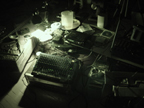May 10, 2007
mech[a]OUTPUT
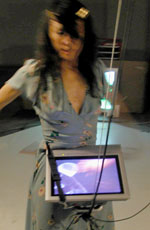
koosil-ja / danceKUMIKO
The Japan Society presents mech[a]OUTPUT by koosil-ja / danceKUMIKO :: Thu-Sat May 31- June 2, 2007.
Radical New York-based choreographer/dancer/ singer song writer/ new media artist Koosil-Ja presents an electrifying multimedia dance-performance with live 3-D environment, seamlessly incorporating elements of traditional noh music and choreography from the classic noh play Dojoji. The legends surrounding Dojo-ji Temple in Wakayama, southeast of Osaka, have inspired numerous noh and kabuki plays about the vengeful spirit of a spurned woman. By juxtaposing the restrained and subtle choreography of Dojoji with 3D world imaging projected on to a large screen, the daring Bessie Award and Guggenheim Fellowship-winning artist Koosil-ja transposes the work into her own aesthetic context, creating an innovative blend of modern and traditional, digital and flesh.
The production features 3D world designed and production by Claudia Hart, 3D Interactive interface designed and performed by John Klima, live Neo Punk Music by Geoff Matters, dramaturgy by Nanako Nakajima, Pendulum & Physical Apparatus Design and Kinetic Engineering by Michael Casselli, Head Gear by Tara Webb, and Betnon-C Bainbirdge (Video Projection Super Engineering).
With:
Geoff Matters (Live Neo Punk Music and Software Design)
Nanako Nakajima (Dramaturgy)
Michael Casselli (Pendulum & Physical Apparatus Design and Kinetic Engineering)
Claudia Hart (3D Wrold)
John Klima (3D Interface & Live Performance)
koosil-ja (Concept, Dance, Video, Video pendulum, Song, Sound Installation and Costume)
Tara Webb (Head Gear)
Benton-C Bainbirdge (Video Projection Super Engineering)
Dates: Thu-Sat May 31- June 2, 2007
Time: 7:30PM
Location: 333 East 47th Street, btwn 1st and 2nd Ave. NYC
Tickets: $25/$20 Japan Society members.
Reservations: Japan Society (212) 715-1258
at JAPAN SOCIETY Ticket Information
STUDENT RUSH $12.50 Student Rush (50% off!)
Pending availability, Student Rush tickets will go on sale an hour
before showtime. Valid ID required, 2 tickets max per ID.
mech[a]OUTPUT is made possible by a commission from Japan Society; funds from American Music Center Live Music for Dance, and New York City Department of Cultural Affairs; and generous individual contributions.
Posted by jo at 03:37 PM | Comments (0)
Synk
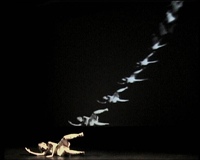
Real-time Processing
Synk is an experimental dance / video / audio piece where video and audio samples and recycles the movements of the dancer on stage, creating rich layers of images and sound. The performance deals with transformation of time ; distortion, displacement, delay, layering and buffering. The idea of Synk is that no prerecorded video or audio will be used, only material sampled during the performance are presented, to investigate live as raw material, and to impose a structure on a live situation to allow unpredictable results within that frame structure. Synk was made in 2002 and performed in a split-evening with the video ensemble 242.Pilots.
On Friday May 4th, (HC Gilje) performed Synk with Kreutzerkompani and Justin Bennett. More images from Synk (click on the small images).
Posted by jo at 02:32 PM | Comments (0)
May 04, 2007
JOHN BALDESSARI: MUSIC
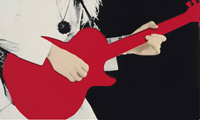
Beethoven's Trumpet: In One Ear and Out the Same Ear
Bonner Kunstverein and Kunstmuseum Bonn present JOHN BALDESSARI: MUSIC :: 12 May – 29 July, 2007 :: Curators: Christina Végh (Bonner Kunstverein) and Dr. Stefan Gronert (Kunstmuseum Bonn).
JOHN BALDESSARI (*1931, lives and works in Santa Monica, California) is doubtless one of the foremost American artists, whose work – since the 1960s and 1970s – has influenced young American, as well as European, artists. The list of the exhibitions of this multimedia artist is correspondingly long, but the way his work is reviewed still leaves countless questions open. The collaboration between Kunstmuseum Bonn and Bonner Kunstverein – under a common thematic banner – seeks therefore to uncover an (up to now) almost disregarded dimension of his approach: BALDESSARI’S artistic engagement with music.
This is the first time that the two Bonn institutions will collaborate on a project that they have developed in tandem. The two-part exhibition at both Bonn venues makes apparent the different goals and undertakings of their respective houses: while JOHN BALDESSARI is developing a thoroughly up-to-date 3D presentation for the Kunstverein, the exhibition at the Kunstmuseum will pursue his multimedia work from the 1970s to 2006, with a focus on its musical elements.
Using the example of over 50 works (paintings, photographs, videos and mixed media) from international museum and private collections, the Kunstmuseum will make visually comprehensible the great variety of Baldessari’s pictorial vocabulary up to the present.
Meanwhile Baldessari has accepted the Kunstverein’s invitation as an opportunity to create an interactive installation for the first time. The (partial) deafness of a musician and composer was the occasion that sparked BALDESSARI’S questioning of the processes of, and capacities for, hearing. Titled BEETHOVEN`S TRUMPET; IN ONE EAR AND OUT THE SAME EAR there will be six interactive sculpture as well as 9 new works on the theme NOSES and EARS. In the six sculptures BEETHOVEN'S TRUMPET (WITH EAR) OPUS # 127, 130, 131, 132, 133, 135 Beethoven’s ear trumpet will play a central role.
These questions on processes of hearing will again be taken up in a different musical installation by LEIF INGE (*1970, lives in Oslo), an artist invited here for this occasion. INGE’S work 9 BEET STRETCH records Beethoven’s 9th Symphony and stretches it out to a 24-hour duration. On the one hand, the work is presented as an installation and, on the other, as a concert for which the Kunstverein will one time stay open for 24 hours.
This exhibition – custom-made for the Beethoven town Bonn – not only for the first time makes graphic the artistic significance of the theme of music, but also enables the visitor to review how far the complex relationship of text, sound and image in JOHN BALDESSARI’S works have developed from the late 1960s up to the present.
An extensive program has been planned around the exhibition, among which is the acoustic performance BEETHOVEN`S EAR in the exhibit rooms by the American avant-garde composer and award-winner of the Beethoven prize, PAULINE OLIVEROS (in cooperation with the Beethovenfest Bonn), an event organized around the film “Conceptual Paradise” by the Munich media artist, STEFAN RÖMER, video showings in cooperation with the Videonale e.V., as well as the presentation of up to now unknown film material from ALLAN KAPROW to BALDESSARI.
In a two-day symposium, organized in tandem with the University of Bonn, the relevance of conceptual art in today’s world will be discussed. Here the way music and the visual arts became interwoven in the 1960s and at present will be the subject of debate from the perspective of art history, musicology, as well as from that of visual artists and musicians.
Press contact:
Kunstmuseum Bonn: Dr. Stefan Gronert, Friedrich-Ebert-Allee 2,
53113 Bonn, Tel +49 228 7762-26, stefan.gronert[at]bonn.de
Bonner Kunstverein: Anna Dietz, Hochstadenring 22, 53119 Bonn,
Tel.+49 (0) 228 693936, a.dietz[at]bonner-kunstverein.de
Posted by jo at 08:18 AM | Comments (0)
April 19, 2007
The Reception

Performance + Discussion
A tele-immersive cross-disciplinary performance piece called The Reception will be presented April 20, 21, 27, 28 at 8pm and April 22, 29 at 2pm as a part of the Berkeley Dance Project 2007. The piece was created by the co-directors of SmithWymore Disappearing Acts, Lisa Wymore and Sheldon B. Smith in collaboration with Ruzena Bajcsy of CITRIS (Center for Information Technology Research in the Interest of Society). Live performance and streamed realtime 3d tele-immersive technology are used to poetically examine the subject of presence. BDP is an annual collection of danceworks presented by UCBerkeley's Department of Theater Dance and Performance Studies. Performances will take place at UCB's Zellerbach Playhouse theater.
The April 22 performance will be followed by a post-performance discussion: Being Here: Presence/Remote Presence within Live and Media Based Performance by N. Katherine Hayles. The discussion will feature a demonstration of a live bi-located dance utilizing the tele-immersion labs at UC Berkeley and the University of Illinois, Urbana-Champaign. Co-sponsored by the UC Berkeley Department of Theater, Dance, and Performance Studies, the Towsend Center Dance Studies Working Group, and the Dance Department and Intermedia Program at Mills College. The discussion is free and open to the public.
Posted by jo at 07:40 PM | Comments (0)
April 13, 2007
Intermedia Arts Group
Two Birds by Nathan Bowen
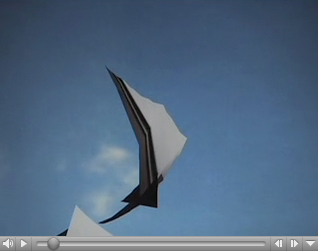
"I have had a long interest in the relationship between motion and stasis, particularly in nature. For example, one could say that the sky is always the same (it's always above, it's blue, there are clouds, etc.), or that it constantly changes (depending on the time of day, the color is always different, the clouds are in constant movement, things fly in the sky, etc.). I am drawn to such things as the sky because they provide both reliability and incomprehensible variety. In this piece I explore how to create dynamic and static behavior simultaneously. Three visual objects projected on a screen each correspond to specific audio events or layers. One object acts as a frame, projecting a video of clouds and sky. The two other objects are three dimensional birds. Through Max/MSP/Jitter, I will be able to control the movement of each object and their corresponding sounds by touching preprogrammed keys on my laptop keyboard and mouse. The relationship between visuals and audio is symbiotic: the visual movement of the 'birds' is initiated by amplitude of drum beats, while the position of the 'clouds' in 3D space directly influences the amplitudes of a cluster of drones." Nathan Bowen, Intermedia Arts Group.
Posted by jo at 04:50 PM | Comments (0)
April 10, 2007
Mladen Bizumic: How If – A Translation in III Acts
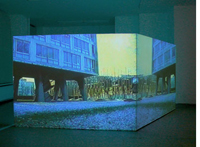
A 'Spatial Opera'
Mladen Bizumic: How If – A Translation in III Acts :: 29 March – 28 April 2007 :: Finissage April 27, 19.00 :: PROGRAM: initiative for art + architectural collaborations, Invalidenstrasse 115, D-10115 Berlin :: t: +49 (0)30 39509318 :: in collaboration with Künstlerhaus Bethanien.
PROGRAM – initiative for art + architectural collaborations presents ACT III of the exhibition How If – A Translation in III Acts by New Zealand artist Mladen Bizumic. Bizumic's first solo exhibition in Germany is structured as a ‘spatial opera’ in which he explores the facets of contemporary geopolitics in relation to representations of architecture. In each of the piece’s three acts, we find the contribution of other artists, musicians, theorists and in one instance, his mother. Act III is presented at PROGRAM, while ACT I & II form the installation at Künstlerhaus Bethanien.
Bizumic’s work is often based on the architecture, urban context and history of the space in which he is living. How If - A Translation in III Acts activates Berlin, his current abode, as the urban fabric comprising the space between Künstlerhaus Bethanien and PROGRAM.
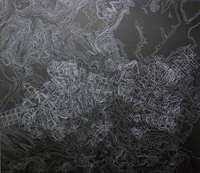
ACT III (at PROGRAM)
Since 2004 Bizumic has been working on a multi-channel video project called event.horizon.black.hole. An angled wall in the gallery acts as a screen for a pair of mirrored video projections. A video of the crumbling architecture of the UNESCO Headquarters in Paris is projected back-to-back with images of an avalanche on Mt. Cook, itself a UNESCO world heritage site in New Zealand. Mirrored along the bend in the wall, each pair of projections resembles an enormous, constantly morphing Rorschach blot. On this occasion, a multi-channel soundtrack has been added, bringing together ambient sounds taken from the Berlin Museum Island (also a world heritage site), with the flapping noises of flags outside the UN Headquarters in New York. The projections dematerialize the wall while the soundtrack organizes notions of nationality, geography, and the concept of a world heritage.
ACT I (at Künstlerhaus Bethanien)
Freud Museum (for her) 2006-2007 is a vitrine of fragments from buildings in Vienna. Two commissioned works accompany this: a piano piece composed by his Viennese girlfriend (a musician), and a ‘psychoanalytic poem’ written by his mother (a psychologist) which both articulate the personal dimensions embedded in the work. The material index of Vienna’s built environment becomes a self-consciously museological display – it’s materiality abstracted and questioned in turn by the music and poetry.
ACT II (at Künstlerhaus Bethanien)
Sister Cities of Berlin (Paris) 2007 is a video installation depicting streetlights seen through the glazed door of a building near the National Highway 7 in Paris. The distorted image through the glass is contextualized as a voice-over begins to tell a story of the Parisian suburb Le Kremlin-Bicetre, loosely based on an interview conducted by Bizumic with French artists Saadane Afif and Valerie Chartrain – themselves residents of the aforementioned building. The characters in the narrative are reduced in their description, but a counter point of complexity is provided by the collision of images, poetic verses and ambient sounds composed by MINIT.
Mladen Bizumic (born 1976, lives and works in Berlin) will present his work in the New Zealand Book at the Venice Biennale (2007). Notable exhibitions in the past include: Through the Picture at the 2nd Moscow Biennale (2007), Busan Biennale (2006), Hide-Tide, CAC, Vilnius and Zacheta National Art Museum, Warsaw (2006), Re: Modern, Künstlerhaus Vienna (2005), Fiji Biennale Pavilions, Govett-Brewster Art Gallery, New Plymouth (2003), Mladen Bizumic, ARTSPACE, Auckland (2002).
PROGRAM is a nonprofit project aimed at testing the disciplinary boundaries of architecture through collaborations with other fields. Initiated in 2006 by Carson Chan and Fotini Lazaridou-Hatzigoga, PROGRAM provides a discursive platform for artists, architects, critics and curators to explore ideas through exhibitions, performances, workshops, lectures, and residencies. PROGRAM intends to diversify the ways we understand and make architecture by engaging the discourse with emerging creative processes that activate the space between pure theoretical research, professional praxis and architecture's social role.
The exhibition is generously supported by Creative New Zealand and the New Zealand Embassy in Berlin.
opening hours:
Tuesday–Friday 14.00–19.00 hrs
Saturday 11.00–19:00 hrs
For further information please email info@programonline.de, or visit http://www.programonline.de
Posted by jo at 11:31 AM | Comments (0)
April 02, 2007
E K T A: A Sensory Awareness Installation
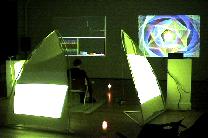
UNITY
E K T A: A Sensory Awareness Installation by Ashanti Vivia and Chris Korda: EKTA is an interactive multimedia and biofeedback installation that allows a user to control light and sound directly with their brain waves. EKTA mirrors the user's brain state, allowing them to mentally program many aspects of the experience, in real time. The user wears a special EEG headband, which radios their brain waves to a network of computers. The computers respond with synthesized algorithmic music, and a video projection of continuously morphing kaleidoscopic imagery, both of which follow changes in the user's brain waves. For example, as the user relaxes, the music gets slower and deeper, encouraging them to relax even more (positive feedback). The experience leads the user through seven distinct stages, which correspond to the seven chakras (energetic centers) of the human body. Each chakra is represented by a unique color, geometry, bass note, and change of musical instrument.
EKTA is the Sanskrit word for UNITY. EKTA allows the user to experience the unification of their inner and outer vibrations. The goal of this heightened awareness is transcendence, a state in which they see things as they really are. As with many meditative and spiritual practices, this has the potential to bring about internal transformation.
Part of Emergent Consciousness :: April 21, 2007:
3:00pm - 8:00pm :: Ashanti and Chris Korda will be facilitating sessions with EKTA
8:00pm - 9:30pm :: Scott Draves a.k.a. Spot presents Dreams in High Fidelity
9:30pm - 11:00pm :: Sean Stevens presents Synaesthesia
Posted by jo at 11:25 AM | Comments (0)
March 07, 2007
‘If the route’: The Great Learning of London

[A Taxi Opera]
‘If the route’: The Great Learning of London [A Taxi Opera] :: PerformanceStudio Voltaire :: Friday 9th March at 7.30pm :: The radio works: 104.4 Resonance Fm, Wednesdays 9pm 14th of March - 25th April 2007. More times below.
A collaboration between artist Beatrice Gibson and musician Jamie McCarthy, ‘If the Route:’ The Great Learning of London is a live performance and radio work in seven parts based on The Knowledge (the infamous London cabbie navigation system and mnemonic device students must master in order to become licensed cabbies). The Performance: The live performance of the 'if the route' has been developed collaboratively with 10 students from Knowledge Point and four improvising string players. A complex and fascinating mathematics of the everyday, The Knowledge involves learning 320 routes or runs mapped within a six-mile radius of Charing Cross. Traveling approximately 26,000 miles across the city on Honda C90's, knowledge students memorize a total of 30,000 streets. ‘Calling over’ entails that after the completion of the days run[s], students must call them out, reciting them out loud. Partners form to call over runs to one another, using recital and repetition as a means to remember the city.
Knowledge Point on Caledonian road, one of several taxi universities students may attend and whose curriculum includes a series of mnemonic devices to aid in their endeavor, is filled with pairs of men and increasingly the odd woman aurally reciting sets of directions to one another. Entering it is to be surrounded by the city fragmented and auralized into sets of sentences and street names, a veritable symphony performing the city as text .
Using the technique of calling over as its principle sound source, the performance of ‘if the route’ celebrates and elaborates this formidable system and poetic by re-contextualizing it within in the space of the gallery. Modeled on paragraph seven of Cardew's original score, Gibson and McCarthy's compositional structure emphasizes the practice of calling over as an ongoing process of repetition, memorization, rehearsal and navigation, articulated in a networked and non heirarchical manner.
The Score
‘If the Route’ takes it title from The Great Learning, the well known score by the radical and experimental 60’s composer and musician Cornelius Cardew. Informed by similar developments and ideals in the Fluxus movement and realized around the same period, Cardew’s work was rooted in belief of the democratic potential of music as a social platform, his score’s often intended for implementation by untrained musician-performers. Cardew’s version of the Great Learning was a score in seven paragraphs, rooted in and acoustically generated by the Confucian text of the same name. Playing on the title of ‘the great learning’ as it relates to The Knowledge and its own system of learning, and borrowing from the methodology, structure and political intent of Cardew’s score, Gibson and McCarthy have used both aural and non aural research into the knowledge as the generative principle behind composition. The score for 'if the route' provides the basis for both realization of live perfo rmance and the radio works.
The Radio Works
Mirroring the seven paragraphs of Cardew’s score, the radio piece comprises seven parts and takes place over seven weeks. In keeping with the spirit of Cardew and the political gesture of experimental composition in general, seven practitioners from varying fields and disciplines have been commissioned by Gibson and McCarthy to use and translate the score for radio according to their own personal and varying interpretations.
Participants include; artist and architect Celine Condorelli, artist Beatrice Gibson, musician and composer Kaffe Matthews, musician Jamie McCarthy, artist and writer, Tom McCarthy, poet and cabbie, Simon Phillips, and architect and theorist, Eyal Weizman in collaboration with Peter Mörtenböck & Helge Mooshammer (Networked Cultures)
Wednesday 14th March 9pm Beatrice Gibson and Jamie McCarthy
Wednesday 21st March 9pm Celine Condorelli
Wednesday 28th March 9pm Simon Phillips
Wednesday 04th April 9pm Eyal Weizman in collaboration with Peter Mörtenböck & Helge Mooshammer (Networked Cultures)
Wednesday 11th April 9pm Tom McCarthy (International Necronautical Society)
Wednesday 18th April 9pm Kaffe Matthews
Wednesday 25th April 9pm Beatrice Gibson and Jamie McCarthy
'If the Route:' The Great Learning of London is generously supported by Arts Council England. Partnered by Studio Voltaire and Resonance FM.
With special thanks to London Contemporary Dance School at The Place.
Posted by jo at 11:43 AM | Comments (0)
January 03, 2007
Engaging 'Intermedia'
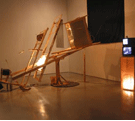
Engaging Technology: A History and Future of Intermedia
In the mid-sixties, Fluxus artists began using the term 'intermedia' to describe work that was both interdisciplinary and composed of multiple media. The term highlights the intersection of artistic genres and has gradually emphasized performative work and projects that employ new technologies. The exhibition Engaging Technology: A History and Future of Intermedia, on view through March 11 at Muncie, Indiana's Ball State Museum of Art, offers an art-historical survey of such activity. Artists Richard Bloes, Hans Breder, Adam Brown, Gary Hill, Dick Higgins, Jenny Holzer, Golan Levin, Nam June Paik, and Alan Rath show work that explores 'intersections between electronic media and various modes of art making--video, poetry, sculpture, performance, sound, typography, music, and installation.' Organizers John Fillwalk and Tania Schuler worked to explore the etymology of the term 'intermedia,' while emphasizing the practice of artists who 'are particularly interested in the relationship between a viewer and a work of art.' Fillwalk's curatorial statement argues that, 'In encountering that threshold of engagement, the viewer can enter into a partnership with the artist in shaping the direction of the work.' The implication is that these pioneering pieces have an ongoing legacy and flexible trajectory. Meanwhile, the show is a refreshing look back at the history of new media. If you can't visit it in person, check out the online video tour. - Marisa Olson, Rhizome News.
Posted by jo at 10:04 AM | Comments (0)
December 18, 2006
Anger

a multimedia immersion performance
Anger - a multimedia immersion performance by Randy Gibson and Ana Baer-Carrillo :: performance, reception, and silent auction :: presented by Avant Media Performance :: Thursday January 25, 2007 - 8PM ::20 Greene, SoHo, NYC (between Canal and Grand) :: tickets $15-$50.
Featuring :: Randy Gibson (piano, crotales), Mike Rugnetta (guitar, banjo), Laine Rettmer (voice), Ana Baer-Carrillo (video), Alicia Wargo (costumes, sculpture), and Oscar Henriquez (design).
"Anger" is an evening-length multidisciplinary work that deals with issues of major ordeal in the contemporary setting. Originally sprung from an intense feeling of pain and anger, "Anger" has developed into an idiosyncratic expression of the human condition. From birth, the human experience is multifaceted and contradictory, delightfully painful; at its most, this experience is bursting with excitement and passion, sorrow and anger.
"Anger" is a collaborative effort to depict the contradictory human condition through music, video and dance. The music runs a fine line between control and chaos. It is performed live on piano, guitar, and voice as a long form hyper-structured improvisation that moves through tonal areas that get to the heart of these feelings running the gamut from simple open chords to extremely dense sonic environments, and everything in between. The performers are forced to confront some of their worst fears, as the music is restructured live by a computer that samples the sounds they create and feeds them back to them in new combinations, all with complete randomness on multiple speakers. The musicians must be extremely aware of their performance, since they never know if what they just played will be played back to them five minutes later, or in little snippets 100 times over, or only once, or not at all. For this reason the performers are extremely skilled and able to adapt to any situation.
Accompanying this soundscape is a visual landscape of film and filmed dance. The visual elements are extensions of the ideas presented in the music. The chaos and randomness are depicted in the film through various experimental editing techniques. The majority of surfaces in the space are covered in large form video lending a surreal saturated environment to the performance installation.
"Anger" is uniquely suited to performance in a gallery environment. There is no best angle for hearing and viewing the work. The piece is unique from every position as certain elements change volume and importance. The video, four unique but similar channels of ever-changing combinations of loops, does not repeat the same combination of images until it has run for two and a half years. With a central core of speakers surrounding the performers, and additional speakers surrounding the audience, a true immersion in the music is achieved, live sound mixes perfectly with looped sound, and all sense of time and direction is lost as the audience member becomes entranced by the music and esoteric images.
"Anger" will premiere January 25, 2007 at 20 Greene in New York. Get your tickets here.
listen to sound excerpt | quicktime required
view video excerpt | quicktime required
Posted by jo at 10:32 AM | Comments (0)
December 07, 2006
Betablocker
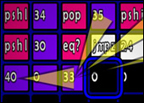
Livecoding and Music Performance
'Livecoding' is the activity of writing a program, or part of it, while it runs. It thus deeply connects algorithmic causality with the perceived outcome and it allows code to be brought into play as an artistic process by deconstructing the temporal dichotomy idea of 'tool' and 'product'. BetaBlocker, project made by software artist Dave Griffiths is a livecoding performance and a piece of software. It's a virtual acid techno machine which is live coded with a gamepad to create code and processes which modify and destroy each other in 256 bytes of memory. The machine's memory and processes are projected and integral to the performance. The software is written in 'fluxus', a small realtime rendering engine that generates animation from sound. The rhythm is a direct result of the process, the number of instructions and jumps.
Livecoders propose a hardline approach to the understanding of software-based art: the code and the process of writing should be visible to the audience, and not hidden inside a 'black box'. However, as it written in TOPLAP Manifesto Draft "It is not necessary for a lay audience to understand the code to appreciate it, much as it is not necessary to know how to play guitar in order to appreciate watching a guitar performance". Livecoding allows the exploration of abstract algorithm spaces as an intellectual improvisation. As an intellectual activity it may be collaborative. And there is something peculiar in BetaBlocker specifically related to live performance. Beta-blockers are in fact cardiac medications quite commonly used by musicians to relax nerves before a concert. By blocking the action of adrenaline and other substances, these drugs mute the sympathetic nervous system, which produces fear in response to any perceived danger. The effect of the drugs does seem magical. Beta-blockers don't merely calm musicians; they actually seem to improve their performances on a technical level. Pointing out this 'live' aspect, the name seems to advocate the 'humanisation of generative music', where code isn't left alone to elaborare its own self-describing soundscape, but it is hacked collectively, chopped up and moulded to make live music." -- Valentina Culatti, Neural.
Posted by jo at 08:19 AM | Comments (0)
October 31, 2006
e and eye
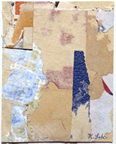
Art and Poetry Between the Electronic and the Visual
e and eye: art Art and Poetry Between the Electronic and the Visual :: Led by Penny Florence, Tim Mathews and John Cayley :: Monday 13 November 2006, 18.30–20.00.
Modern art has had a close historical relationship with poetry and performance since its formation. Electronic poetry has developed a strong element of performance, an implicit demand for some form of exhibition. This series of events explores the relationship between the visual, the poetic and the electronic in art. The sessions begin with a conversation in which invited speakers discuss issues relevant to the Collection and to electronic and visual poetry. This is followed by a short performance or reading of an electronic poem, and an open discussion. Laptop computers with video projection showing interactive electronic works are also placed within the galleries.
The speakers are theorists and practitioners in a variety of media and virtual curators, and include John Aiken, Patrick Burgaud, John Cayley, Penny Florence, Elizabeth James, Mark Leahy, Tim Mathews, Brigid McLeer, Sharon Morris and TNWK (Kirsten Lavers and cris cheek).
Virtual presence practitioners / curators / theorists: Sandy Baldwin, N Katherine Hayles, Camille Utterback, Talan Memmott, Rita Raley, David Rokeby, Alan Sondheim, Noah Wardrip-Fruin.
There is an e and eye blog at where further information is given. Members of the audience and participants can post comments and discuss the talks.
Organised by Penny Florence and Tim Mathews, with John Cayley.
In collaboration with The Slade School of Fine Art, SCEMFA and the Department of French, University College London
Tate Modern Throughout the gallery
Free, booking recommended
Price includes drinks afterwards
A booking fee of 50p applies to online bookings.
For tickets book online
or call 020 7887 8888.
Posted by jo at 11:57 AM | Comments (0)
October 14, 2006
Antony and the Johnsons with Charles Atlas
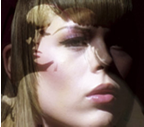
European tour of Turning
Antony and the Johnsons with Charles Atlas – European tour of Turning :: 31 Oct – 10 Nov 06.
Turning combines the haunting and dramatic music of Antony and the Johnsons with a vivid visual backdrop provided by award-winning film director and video artist Charles Atlas. The live performance features a simple yet moving orchestration from an ensemble of eight musicians alongside Antony, as well as video footage of fourteen NYC Beauties, whose intimate and hypnotic portraits whilst slowly turning onstage are captured, processed and projected by Atlas.
By combining Atlas’ innovative live video processing with Antony’s vocal stylings, which have been compared to the likes of Nina Simone and Lotte Lenya, Turning explores issues of innocence, metamorphosis, and transcendence in a visually dramatic and highly compelling format. Turning was first performed at the Whitney Biennial at the Whitney Museum of American Art in New York, 2004.
:: 31 Oct & 1 Nov, Auditorium Parco della Musica, Romaeuropa 2006, Rome IT
:: 4 & 5 Nov, Barbican Hall, London, UK
:: 7 Nov, Olympia Hall, Paris, FR
:: 8 Nov, Palacio Municipal de Congresos, Madrid, ES
:: 10 Nov, Theatro Circo de Braga, Braga, PT
For full tour details visit http://www.forma.org.uk
Antony graduated from NYU’s experimental theatre programme before going on to receive an N.Y.F.A. fellowship for performance art and emergent forms. After a series of solo cabaret performances at the East Village’s Pyramid Club, he assembled the Johnsons and the band recorded its debut album in 1997. His harrowing voice, which Laurie Anderson called “the most exquisite thing that you will hear in your life,” has continued to gain the group acclaim, with the album I am a Bird Now (2004) winning the Mercury Music Prize, 2005. Over the past year the group has toured extensively across Europe, The States and Australia. Antony has toured with Lou Reed and appeared on his albums The Raven and Animal Serenade. He has also made various film appearances with directors such as Steve Buscemi and Sebastian Lifshitz.
Charles Atlas, an award-winning filmmaker, video artist, and pioneer of the medium of media-dance, has created work for film, theatre, television and such prestigious museums as the Whitney, NY and the Musée d'Art Moderne de la Ville de Paris. Best known for his acclaimed collaborations with choreographers, dancers and performers such as Michael Clark, Leigh Bowery, Diamanda Galas and John Kelly, Atlas spent ten years as film-maker in residence for the Merce Cunningham Dance Company; his feature-length film Merce Cunningham: A Lifetime of Dance won the Best Documentary Award at Dance Screen 2000 in Monaco. Recent dance-related pieces are Rainer Variations (2002), a video portrait of Yvonne Rainer, and two collaborations with Merce Cunningham: Views on Camera (2005) and Views on Video (2005).
Further projects featuring the work of Charles Atlas, November 2006, London:
• Hail The New Puritan, a survey of Charles Atlas's work in film and video, Tate Modern Starr Auditorium, 16 -20 Nov 2006, details at http://www.tate.org.uk.
• Instant Fame, an interactive video installation at the Vilma Gold Gallery, London, from 23 Nov– 3 Dec 2006, details at http://www.vilmagold.com.
Turning is produced by Forma and International Music srl and is co-commissioned by The Barbican & Fondazione Musica per Roma & Romaeuropa 2006
The first presentation of Turning in New York was co-produced by Arts at Saint Ann's, True Love Productions, UCLA Live! and Pomegranate Arts
Forma Arts and Media Producers is one of Europe's leading contemporary arts agencies specializing in the production of cross-artform projects. Pioneering new hybrid forms of music, visual art, film, new media, dance, theatre and live art, Forma’s international touring programme for 2006/2007 includes projects with alva noto [carsten nicolai]; Antony and the Johnsons; Charles Atlas; Gina Czarnecki; Ryoji Ikeda; Ryuichi Sakamoto and Lynette Wallworth.
For further information visit http://www.forma.org.uk
Posted by jo at 01:30 PM | Comments (0)
September 11, 2006
REMOTE

You Bring the Secret Location to Life
REMOTE--by Chris Vecchio :: 9 September – 21 October 2006* :: Gallery Joe Bird Park
3rd and Arch Streets :: Philadelphia, PA :: * viewable 24-7 * best experienced at night * (but no sound after 10PM) :: INSTRUCTIONS: 1) Get up off of the couch 2) (but bring the remote control with you) 3) Go to the south west corner of 3rd and Arch 4) Use your remote to activate the park.
REMOTE is an interactive environmental installation containing a range of sound and visual effects. Installed in an outdoor space, the installation is activated, controlled, and navigated using a common household remote control which may be supplied by the viewer. The piece takes the form of an intervention in an outdoor space, along a street or in a small park. There’s an “insider” element to the installation since, when not activated, its location may not be immediately apparent to a passerby. Additionally, the viewer needs to know to bring a remote to the location to bring the secret to life.
At the installation site, pressing buttons on any (TV, DVD, VCR, audio, etc…) remote control triggers a myriad of responses ranging from subtle (bird calls or soft sounds emanating from hidden speakers, changes in the ambient lighting) to bombastic (more dramatic sound effects, explosions, strobe lights, or projected images). Each key press generates a unique combination of effects. Viewers may bring any remote control from home to activate the installation.
Central to my work is an interest in the expressive potential of electronic devices and in the potential for user interfaces to generate new modes of interaction. A set of social precedents now exists for interaction with electrical technology. When these precedents are followed but subverted or there is no clear immediate “functional” objective, a viewer’s expectations are challenged and an opportunity for reflection or commentary on the human-technology relationship is created. This project makes use of such ambiguity – juxtaposing the familiar with the unexpected – to encourage people to question their assumptions about technology and reflect upon their interaction with it.
The piece has a strong element of accessibility. People who may be intimidated by interactive work or by technology in general may be engaged because an everyday object is the agent of action. The experience of the installation is reminiscent of a coin-op arcade shooting gallery. Play and experimentation are encouraged as part of the experience. Participants can keep trying different units from their everyday collection because each remote interacts differently with the piece. This highlights the number and variety of remotes we use for everyday tasks, from the mundane to the complex.
Sound samples in this installation have been gathered from a wide range of sources including sound effect libraries, police scanners, popular music, short wave and CB radio, and by using peer-to-peer networks to search the internet for randomly (inadvertently?) shared audio files. The broad range of sources references the instrumental use of sound samples in music as well as common (mundane) technological interactions such as channel surfing or tuning across a radio band.
Finally, the installation presents the man-technology interface ironically. The couch potato is asked to get off of the sofa and experience art first hand, but still holding the ever-present remote. Issues related to the effects of technological mediation and the degree to which technology is an atrophying rather than an empowering force are raised.
Posted by jo at 01:38 PM | Comments (0)
September 06, 2006
See You in Walhalla
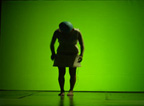
World Premiere of Live Computer Game
[Posted by Yukihiko YOSHIDA] World Premiere of new Live Computer Game "See You in Walhalla" :: September 14, 2006 :: IME Industrial Performing Arts Complex - Athens (Greece) and two other European cities (Sofia and Amsterdam) connected live through the Internet.
The Athens based performance group amorphy.org, with support of the Cultural Center of Kifissia and the EU Culture 2000 Funding Scheme, is proud to present the world premiere of "See you in Walhalla," a distributed live performance game connecting three cities – Amsterdam, Athens and Sofia. This multi-media dance/theatre project, collaboratively created by artists and designers from four different European partner sites in Greece, The Netherlands, Germany and Bulgaria, presents the unusual journey of a video game “avatar” through a haunted urban industrial landscape composed of digital fragments from the spectacle of Europe.
The audience in Athens is invited to witness the exciting premiere of the first live 3D computer game enacted by three dis/located performers simultaneously, with Ermira Goro playing the “avatar” on location in Athens, while Nancy Mauro-Flude and Ivaylo Dimitrov are streamed via web-cams into the game but are located in Amsterdam and Sofia respectively, and watched by local audiences in those cities. At the same time, “See you in Walhalla” can be witnessed live on the Internet, where online players can log on to offer their comments and reactions to the performance/game. The Athens premiere represents the first leg of a European tour scheduled for 2006-2007 seasons.
Description of the new work:
An average man. Slightly obsessive, familiarly lonely. He eats his green apples, rendered phosphorescent in the glow of his computer screen. A new video game, See You in Walhalla – “in this place everyone who is not in jail works for the police.” He creates his avatar. The game’s purpose - to guide this avatar, born as an “empty” shell, through various journeys taking place in an imaginary city-scape morphed out of Amsterdam, Athens and Sofia, with the final goal of rendering the avatar into a more “human being”, capable of surviving the density, danger and psychosis of urban existence, at a time when Europe is undergoing its own nightmares of economic and political integration. Paradoxically, integration in this haunted and visually disturbing game is experienced as a series of physical and psychic dis-sociations. The Player gets more involved with the game, losing a sense of reality and becoming more socially autistic, while his avatar slowly recovers a sensibility for human inter-action which is punished by the pressures and regulations, as well as the hyper-euphoric spectacular image-scapes, of which the urban rhythms of existence are determined.
I am Amalia, if you hurry me I will say I am Molly, I am her, locked up in the big house, desperate, pursued by Rosas’s mazorca, I am Irish, I will say then, I am her and I am also the others, I was the others, I am Hipolita, the gimp, the little cripple, I tottered slightly when I walked, Hipolita, I say to him, and he smiles, Hipolita, with “the gloves on her small hands”, she ran away with the psychopath, the big castrated psychopath who could tell the future on Tarot cards, he had a scar on his groin from here to here.
Three performers inter-connected, a complex web of fantastical events seen from pre-recorded film, live-web cam and audio streams from Amsterdam and Sofia, interactively controlled sound and video based determined by movements of the performer in Athens, and unpredictable site-specific performances in Sofia and Amsterdam – these components compose the 3D live game environment which promises Player and Avatar a life after death (Walhalla).
The protagonist of this game is not an ego-shooter, but a flâneur, a cyber wo-man who discovers herself as an anonymous face in the multitude, but who is free to probe her surroundings for clues and hints that may go unnoticed by the others. The Avatar-wanderer does not abandon herself/himself in the crowd, but actively participates, observes, revolts, and intervenes in her surroundings, and just as she experience her “unbearable lightness of being”, she is nearly killed in an accident.
This theatrical computer game explores the “system” of deadly possibilities that lurk in the entropic cities of late capitalism, amongst the facades of glamour, heroic icons and consumer fetishes which, like a dream, do not exist in reality or can fall apart in a moment, setting fire to the outskirts of our imagination or flooding our delusional consciousness.
* * *
Initial Concept by: Tzeni Argyriou, Ioanna Tsinividi, and Ash Bulayev
Tzeni Argyriou (Concept and Direction); Zoe Chatziantoniou, Ioanna Tsinividi, and Ash Bulayev (Creative Team); Tzeni Argyriou, Zoe Chatziantoniou, Ermira Goro, and Ash Bulayev (Choreography); Ioanna Tsinividi (Video Direction/Editing); Zoe Chatziantoniou and Ash Bulayev (Dramaturgy/Text Composition); Stavros Gasparatos (Music Composition); Arjen Keesmaat and Stoycho Stanchev (System Design/Programming); Paul Verity Smith (Sensor Development); Kostantinos Kipriotakis (Stage Design); Sakis Birbillis (Lighting Design); Despina Makarouni (Costume Design); Nikos Makris (3D Animation); Christopher Brellis (Designer); Lena Kitsopoulou and Ash Bulayev (Voiceovers)
Web interaction design and logistics by: Sher Doruff (Waag/Holland), Johannes Birringer (InteraktionsLabor/Germany), and Galia Dimitrova (InterSpace/Bulgaria)
Performed by: Ermira Goro (Athens), Nancy Mauro-Flude (Amsterdam), and Ivaylo Dimitrov (Sofia)
Production Crew:
Maria Kerasioti (Lead Project Facilitator/ C.C. of Kifissia), Maria Ladaki (Project Coordinator/C.C. of Kifissia), Eleni Katsarou (Project Coordinator & Production Manager/amorphy.org), Galia Dimitrova (Project Coordinator/InterSpace), Johannes Birringer (Project Coordinator/InteraktionsLabor), Floor Van Spaendonck (Project Coordinator/de Waag), Dyonisis Petrouchopoulos (Director of Photography), Katerina Stasinopoulou (Co-Video Editor), Christopher Brellis/antidot (Web-Design/Poster Design), Guy Stefanou (Technical Director)
Logistics:
Date: September 14th, 2006
Time: 21:00 (Athens/Sofia) & 20:00 (Amsterdam)
Locations:
Athens/Greece (IME Industrial Complex, Building 5)
Amsterdam/Netherlands
(Waag Society, Nieuwmarkt Square)
Sofia, Bulgaria
(Red House for Culture & Debate,
15 Ljuben Karavelov Street)
Info: www.amorphy.org/imap
* For press photographs or any other information regarding the show or project, please contact: info[at]amorphy.org
Development History
With funding support of the European Culture 2000 Framework Program, the project development of “See you in Walhalla” began in September 2005, and after extensive filming on location and digital choreography and computer programming workshops in the various partner sites , the new work will be shown as a live networked performance on September 14th, 2006 in Amsterdam, Athens, and Sofia. The collaborative project, implemented through a trans-European network of four participating media art organizations, is dedicated to fostering new and innovative works of art through effective integration of interactive technologies and live performance practices.
Collaborative Network of Co-Organizers
· amorphy.org (Athens, Greece) - www.amorphy.org
amorphy.org is a non-for-profit organization devoted to production of original works of live performance and installation, through constant pursuit of practical investigation fusing media art technologies and live performance practices.
· InteraktionsLabor (Göttelborn, Germany) – www.interaktionslabor.de
InteraktionsLabor, under the direction of Johannes Birringer, is an organization which focuses on research in communications technologies, interactive media, performance and virtual environments.
· InterSpace (Sofia, Bulgaria) – www.i-space.org
InterSpace is a New Media Art Center that works for the establishment of a social attitude to new media art forms, through the development of alternative means and possibilities of artistic expression in new media technologies.
· De Waag (Amsterdam, Holland) – www.waag.org
Waag Society for Old and New Media is a knowledge institute operating on the cutting edge of culture and technology in relation to society, education, government and industry, established in 1994.
· Cultural Center of Kifissia (Athens, Greece) - www.kifissia.gr
C.C. of Kifissia various courses for painting, Greek traditional dancing, theatre, jewelry , photography, batik, mosaic and so on. The municipal cultural centre highly supports and promotes cultural creativity.
Associated Partners
PACT Zollverein - Essen, Goethe Institute, Red House For Culture and Debate, IKS, IME Research Facility, Ipsilon Production Company, Brunel University, i-DAT/University of Plymouth.
ash bulayev/amorphy.org
artistic director
Address:
Alopis 58, Kato Petralona
11853 Athens Greece
email: ash[at]amorphy.org
web: www.amorphy.org
mobile: + 30 6937 20 33 00
work: + 30 210 34 56 341
Posted by jo at 08:18 AM | Comments (0)
September 01, 2006
OPERA.tion LIFE NEXUS
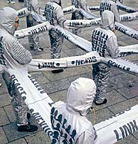
An Evolving Opera
OPERA.tion LIFE NEXUS: Jorge Orta began this mixed media work in 1996 and it will evolve and grow in length until 2006. Based on interdiciplinary collaborations, 3 generations of artists are invited to create a module for the open-ended composition: music scores, dance sequences, sculpture, light and video projections. The federating theme is the heart = Life, the creative idiom from both a symbolic and Human perspective. Its complex mythology renders the symbol poetic.
The Babylonians designated the heart the center of intelligence and memory. For the Egyptians it represented the terrestrial support for the soul. Hypocrite refer to the heart as the intelligence organ. Plato believed the heart was the center of feelings and passion. For Aristotle the heart transformed food into blood and was the emotional centre. Its universal nature helps to converge cultural, social, religious differences and from a scientific angle it exposes a new vision of a medical problem.
OPERA.tion is a locus for debate to address the sensitive subject of life saving organ donation; thousands of people are on a waiting list for organ donations... [F]renzied individualism has left society without hearts and heart !
The opera comes in a kit format and adapts to all venues. Crate sculptures facilitate the transport, preserve the archive of resulting collaborations: objects, music scores, video and photographic works, CD Roms, silkscreen prints, visual poetry, paintings, Body Architectures…, are stored in the wooden crates, which in turn are labeled and stamped with the origin of the multiple actions throughout the world.
Jorge Orta (Rosario, Argentina 1953) lives in Paris Artist and architect, Jorge Orta has been working on large scale ephemeral works since 1973. Protagonist of an urban and social poetic language, he has developed many new and alternative forms to communicate : using mail art, video installations and performance in the early 70's, to large scale projections in the 80's. Over the last 20 years he has devised a polysemic alphabet of signs and symbols which allow him to address very diverse publics, and more recently he has been exploring the symbol "Heart" to consolidate art, mythology and science. Jorge's light projection work took on its veritable dimension in 1992 when he projected giant mobile images inside the Pompidou Centre in Paris and when he embarked on a human experience to project his signs on Machu Picchu mountain in Peru. Since, he has covered the facades of the Venitian palaces at the 1995 Venice Biennale, and more obsolete places such as Capadoccia in Turkey, Cuenca in Spain, Aso volcano in Japan, Chartres and Evry cathedrales and many more.
Posted by jo at 12:09 PM | Comments (0)
August 21, 2006
RELIQUARY OF LABOR - Parallel Media Project
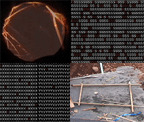
A Participatory Art Experience
The New Britain Museum of American Art is pleased to announce the performance of the participatory art experience Reliquary of Labor, a multi-media collaboration between media artist Gene Gort, composer Ken Steen, and electronic cellist Jeffrey Krieger. The project, designed as what the producers’ term "parallel media" -- a single project or phenomena experienced through various distribution systems and performance venues -- takes as its inspiration the creative process as a product of labor. Using the Museum’s building expansion as their source material, they have harvested video and sounds of the museum's new construction to develop a multi-media performance for video, electronic cello, percussion ensemble and pre-recorded sound.
Reliquary of Labor explores the collaborative process among artists, observes and reveals beauty in the ordinary, and celebrates the idea of labor as integral to any art work or production; that architecture, music, writing, visual art, or any creative endeavor doesn't merely appear out of the atmosphere. The artists seek to make their collaborative process transparent for the audience and, in keeping with the idea of "parallel media", have launched the website. It contains project updates and works-in-progress for viewing and downloading, as well as podcast material. Visitors to the site are encouraged to use sound, stills, and videos from the project for their own work through the "creative commons" license and to submit processed files for reintegration into the project.
A preview of the project/experience will be held on Thursday, August 31, 2006 from 4 p.m. – 6 p.m. The premiere will be held on Sunday, November 26, 2006 at 2:30 p.m. in the new Chase Family Building of the New Britain Museum of American Art.
BIOS:
Gene Gort is a visual artist, video producer, media programmer and educator. His videotapes, installations and digital imaging projects have been presented internationally including La Casa Encendida, Madrid, Spain; DeCordova Museum and Sculpture Park, Lincoln, MA; Pacific Film Archive/Berkeley Art Museum, Berkeley, CA; TheVideoArtFoundation, Barcelona, Spain; Cyberarts Festival, Boston, MA; Real Art Ways, Hartford, CT; Black Maria Film and Video Festival, touring. He has received two nominations from the Rockefeller Foundation Fellowship Program, received two MacDowell Colony Fellowships (2006 & 2004) and received grants from the Connecticut Commission on the Arts and the Pollack-Krasner Foundation. Gort holds the position of Associate Professor, Media Arts at the Hartford Art School, University of Hartford, a program he designed and directs.
Jeffrey Krieger, e-cellist and specialist in the performance of new music, is principal cellist of the Hartford Symphony Orchestra. He is among the new generation of solo recitalists who have incorporated technology - the computer and video - as well as an electronic cello built by Vermont craftsman Tucker Barrett into performance. Mr. Krieger’s many awards includes a 1993 Solo Recitalist Fellowship from the National Endowment for the Arts which allowed extensive touring in the USA performing concerts and workshops. He has collaborated with composers such as Virgil Thompson, Ned Rorem, Kaija Saariaho, Donald Erb, and Alvin Lucier, as well as numerous emerging composers. His own interactive video improvisation, Videocello, was chosen by American Composers Forum to be included on their touring program, Sonic Circuits, resulting in a performance at the Kennedy Center.
Ken Steen's music sits squarely on the frontier between the acoustic and electronic domains of musical expression; often combining traditional orchestra, chamber ensemble or soloist with electronic instruments or processed sound and noise. He recently received a MacDowell Colony Fellowship (2006), a Fellowship from the Connecticut Commission on Culture and Tourism (2005) and a residency at the Artist's Enclave at iPark (2004). Recent premiere performances and sound installations in such diverse locations as Xi'an, China, Fortaleza-Ceará, Brazil, Spring in Havana Festival, Havana, Cuba, Merkin Concert Hall in NYC and the Australian Centre for Contemporary Art in Melbourne, Australia, confirm that his work is fast attaining international recognition. Steen is currently Associate Professor of Composition and Theory and director of Studio D at the Hartt School, University of Hartford.
Posted by jo at 02:41 PM | Comments (0)
Cardiomorphologies
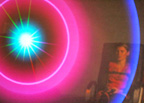
The Body as an Instrument
"George Khut is an artist working in the area of immersive and interactive installation environments. His research focuses on the development of interactive sound and video environments where users experience and learn to influencial aspects of their own psycho-physiological processes by reckoning changes in the sound, colour and form of the artwork. His latest project, Cardiomorphologies (now version 3.0) is an interactive installation that uses technologies and principles of heart rate variability and biofeedback training for this purpose. The biofeedback training, in fact, enables people to obtain voluntary control over various physiological processes providing an instantaneous electronic display of body functions. In this case breath and heart data, collected by a pressure sensitive strap placed around user's upper rib and by two sensors held in his hands, are used to control a large video projection. The video consists of a halo-like concentric circles that pulsate and change colour according to heart and breath rhythm. Heartbeats and breathing are also transformed into sounds emitted by speakers so that the user, sat in a comfortable chair, can watch his own 'bodysong'. According to Khut, Cardiomorphologies uses biofeedback design principals to help participants differentiate contrasting forms of psychophysiological orientation: ways of being present and relating to our own experience of the world and ourselves through mind-body organisation.
Refusing the traditional western preconception of an observing self and observed body/other, the installation might be experienced in two different ways by the users. The first is passive one: the participant is nothing more than a spectator amazed by his body show, enchanted by the translation of his vital functions in sounds and colours and surprised by the performance. The second, instead, is a pro-active one: like a musician the user can play his body as an instrument, hyperventilating or deep breathing, getting excited or relaxed. In both the cases the result is a hypnotic cyborg interaction experience." Valentina Culatti, Neural.
Posted by jo at 02:12 PM | Comments (0)
August 17, 2006
not a time machine:
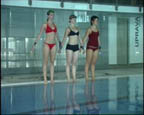
[: visible > audible > sensible :]
not a time machine: a composition for dancers, swimming-pool, camera, monitor and mixing board by Miha Ciglar, Mojca Kasjak, son:DA :; video file - 25 MB (divx codec) - rightclick + save target as) :: not a time machine is an interdisciplinary art project that uses dance, music and video as forms of expression. The two central elements (water and electricity) constitute the fundaments of a gestural interface. The main idea was to expose the intrinsic aesthetics of conventional electronic devices through a particular electronic connection of swimming-pool, camera, monitor and audio mixing board.
Since the dancers are electrically connected to this constellation of misused technology, they become a crucial part of the instrument and consequentially get misused as well. All of their actions (gestures) reflect themselves in unique sound events, limiting - but at the same time focusing - their standard expression spectra to the expressive potential and boundaries of the instrument. The induced sound respectively its electronic abstraction is in direct contact with the performers body and is providing a tangible feedback. This enables a different corporal perception and interpretation of the caused sound, since now the performers do not only have the audible but also a haptic reference - i.e. pain, caused by the electric current - for the choice of their following actions. In this way, a circle – based upon the principle of cause and effect – gets completed, which triggers a continuous oscillation of the three basic impressions: [: visible > audible > sensible :]. [PDF] [via VVORK]
Posted by jo at 12:27 PM | Comments (0)
July 26, 2006
Flüux:/terminal

A Bipolar Performance
Flüux:/terminal is a bipolar performance that skoltz_kolgen have named diptyque rétinal . As in all Of their work, here their research has established a point of contact between sound and image. But Flüux:/terminal pushes the dialogue between these two elements one step further: their performance Creates a dramatic tra jectory, fuelled by the panoramic tensions (left/right) between hearing and seeing.
Flüux:/terminal projects images on two screens, in a parallel visual body of luminous particles_ photographed or filmed images and wire frame displays. As stereophonic visual representations, the two screens are the alter egos Of the audio, which is also divided in two. The sound sources (left/right) are desynchronized and propelled into separate channels: the left-hand channel excites the left-hand image; the right-hand channel excites the right-hand Image. The image is distorted, bearing the marks that the sound imprints upon it, and becomes the fossil of the sound.
A bipolar experience is therefore built by catalyzing the lines of tension between two Independent but related audio and visual worlds. Their dissociation in one instance and their synchrony or symmetry in another establish space–times that fairly float in weightlessness. These suspended moments are succeeded by fresh charges of energy that are massive and intense. A new generation of meaning escapes: attraction and repulsion, interdependence at times, followed by struggle and conflict at others.
Flüux:/terminal is a living performance that evolves each time it is presented. In the same evolutionary S p i r i t , The flüux:/terminal album transposes the performance in another environment. Skoltz_kolgen give the audio CD a life Of its own while reprising textures and sound microfragments from the performance and reconfiguring them, stripped of their visual aids. The result is more musical and minimalist, venturing beyond the raw, polarized qualities of the performance.
Flüux:/terminal will be performed at RECOMBINANT MEDIA LABS, San Francisco on Wednesday August 16th & Thursday August 17th at 8:30 pm. Cost: $15.
Posted by jo at 09:56 AM | Comments (0)
July 18, 2006
Turbulence Commission:
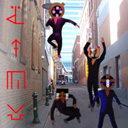
SWM05: Distributed Bodies of Musical-Visual Form
SWM05: Distributed Bodies of Musical-Visual Form [SWM05] -- by Troy Innocent and Ollie Olsen with the Shaolin Wooden Men and Harry Lee -- features the distributed bodies of musical-visual form that are inhabited by the Shaolin Wooden Men (SWM), a virtual band, a 'gang of numbers' -- me(a)tacodeflesh. SWM require your assistance to manifest as media creatures. They invite you to send them images of your local environment in which they can appear. Sending images unlocks access to the SWM05 mobile site which consists of downloadable micromusic ringtones and small screen machinima performances. The SWM are everywhere. In a meshwork of wireless entities, they are media creatures seeking a fragmented existence to be consumed in the nanoseconds of play-time in the emerging wireless net. SWM05 will transfigure the SWM by embodying them in a new materiality.
SWM05: Distributed Bodies of Musical-Visual Form is a 2005 commission of New Radio and Performing Arts, Inc., (aka Ether-Ore) for its Turbulence web site. It was made possible with funding from the Andy Warhol Foundation for the Visual Arts.
BIOGRAPIES
The SHAOLIN WOODEN MEN are a 'gang of numbers' whose bodies are 'made of sound'. In their various manifestations they have released three full-length recordings - "S.W.M. " (1992), "The Hungry Forest" (1994) and "Supermindway" (2001) - and a collection of singles and remixed released on the Psy-Harmonics label. The S.W.M. work across image, sound and interactivity and have performed at DEAF96 and exhibited at ISEA96. Typically, they require the assistance of creative humans to manifest as media creatures to be distributed across the net.
TROY INNOCENT has been exploring the 'language of computers' and the new aesthetics of digital space since 1989. In recognition of this work, Innocent has been described as "the first philologist of virtual reality". His artificial worlds – Iconica (SIGGRAPH 98, USA), Semiomorph (ISEA02, Japan), and lifeSigns (Ars Electronica 2004, Austria) and Ludea (SIGGRAPH2006, USA) – explore the dynamic between the iconic ideal and the personal specific, the real and the simulated, and the way in which our identity is shaped by language and communication. He is currently Senior Lecturer, Department of Multimedia and Digital Arts, Monash University, Melbourne.
OLLIE OLSEN is an Australian composer, synthesist and sound designer who has been producing and performing rock, electronic and experimental music for the past thirty years. Projects include "Max Q," "NO," "Third Eye," "Orchestra of Skin and Bone," "Shaolin Wooden Men," and "I am the Server." Some recent collaborations and projects include performing with Negativland (from USA-2001); guest soloist with the Australian Art Orchestra (2002); and recording with Japanese bands, BOREDOMS and AOA (2001-2002.
HARRY LEE is a web developer working with Macromedia Flash, SQL, PHP and related technologies. Recent projects include database development for lifeSigns, exhibited at the Australian Centre for the Moving Image (ACMI) in 2004, in addition to numerous corporate and education projects. He lectures in multimedia and digital arts in the Faculty of Art & Design at Monash University.
Posted by jo at 01:06 PM | Comments (0)
June 07, 2006
ZOT!
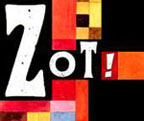
From Nowhere to Nothing
ZOT! was formed in 2005 by Luca Tanzini (theremin+video), Luca Cascino (drum), Nicola Cascino (guitar) and Patrizia Musino (sax) as an improvisational, experimental multi-media ensemble. The final outcome of early 20th Century thought was to make pure cinema as visual music and express oneself through a rhythm that stood for nothing but itself. The project is based around improvisational use of mixed technologies (analogical - digital) that allow to realize and adapt the ideas of the first experimenters in a contemporary live-video-music performance.
ZOT! creates a space where any sound, text, video or texture, is treated as a possible contribution to the ambient situation, every performance must be different, surprise, chance and variety are far more important. The visual aspect will be, instead, created in real time, using ZOT! own original computer-software: RandomCinema and Musica a Colori.
In occasion of their trip to one of the most important avantgarde arts-electronic festival in Europe - EXPO 2006 - Manchester UK. ZOT! will perform in Dublin at lower deck on 23th of June 2006.
ZOT!/LESA (Situationist Space)
"Music-Video and Poetry from nowhere to nothing"
(websites)
http://www.myspace.com/zottovolante
http://www.media.unisi.it/liberarte/zot.html
http://www.media.unisi.it/liberarte/lesa.html
Related projects: CABERNET VOLTAIRE (Free Form, Free Music, Free Everything)
Posted by jo at 09:21 AM | Comments (0)
May 30, 2006
EtchASound
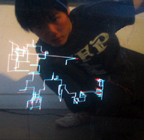
Drawn Words
You talk, and EtchASound makes your words into 3D sketches - "EtchASound is an installation inspired by the world famous toy Etch-A-Sketch. By interacting with EtchASound audiences can have the unique experience of drawing with their own voice. First the user creates a 2 dimensional image in real time with his or her voice, and after a few moments the computer converts this into a 3 dimensional drawing. Then when you wear anaglyph glasses (3d red and cyan glasses) users can see in real space the drawing that you have created." [via] - Link. & process of EtchASound (photos). [Posted by Phillip Torrone on Make Blog]
"The user's voice is input through four microphones. Volume controls the vertical and the horizontal variables. Pitch controls the depth. Therefore by using nothing but your voice you create a 3d drawing. Voice is one of our most defining characteristics, we can usually recognise a person just by his or her voice. In addition, in this project we aim to let people discover a new and creative application for their voice, namely drawing. The artist usually uses his hand to draw, but in EtchASound our voice plays the role of the hand."
Posted by jo at 02:30 PM | Comments (0)
May 18, 2006
Alan Sondheim with Leslie Thornton
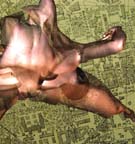
em/bedded
Track 16 Gallery presents em/bedded: A multi-media installation by Alan Sondheim with Leslie Thornton; Guest curated by Tyler Stallings; May 27-June 24, 2006; Reception: Saturday, May 27, 6:00-9:00 p.m.; Performance: 8:00 p.m. Free.
About the performance at 8:00 p.m.: Alan Sondheim will present em/bedded (assembled performance) (45 mins. approximately). It consists of a laptop performance that deals with political, sexual, and cyber issues. He runs video/audio/text segments from a laptop in combinatory fashion, typing a real-time commentary at screen bottom. The result is an extended body, the digital problematized by analog, purity by error, language by language-stumbling. He uses various avatars who “live” in a world that has collapsed into pixel- annihilation.
About the installation: In his first solo exhibition in California, Alan Sondheim, along with filmmaker Leslie Thornton, will transform Track 16 Gallery’s cavernous main gallery into the multi-media installation, em/bedded. Sondheim brings together video projections of cyborgian, mutating, sexual bodies and the artifacts of battlefields soaked in banal horror. Together, they offer a distorted beauty of the disasters of war and the pleasures of love. Guest curated by Tyler Stallings.
Scattered amongst the video projections of furiously moving dancers, of sexual confrontations, of computer generated “avatars,” there will be antennae, battlefield telephones, off-kilter combat tents, photographs of battleships, trenches, and bodies, souvenirs taken from Japanese soldiers, old microscope slides, and antique book editions of du Maurier's Trilby, Confessions of a Magnetiseur, a Japanese pre-Meiji book of black and white block prints of Westerners, Volney's Ruins of Empire, and Albert Dreyfuss' Five Years of My Life. Together they all suggest attempts at communication amidst fortifications created around language and confinement.
Integral to the installation will be a large tent that contains Leslie Thornton’s recent video work, Let Me Count the Ways: Minus 10, Minus 9, Minus 8, Minus 7, Minus 6…. In this work, Thornton explores the social effects of new technologies and media, but here she pushes even further into autobiographical territory to suggest the ways in which we are all implicated in these changes. Juxtaposing aerial footage of pre-9/11 New York City; scientific data on genetic mutation; audio testimony about the bombing of Hiroshima, and a home movie of her father, an engineer on the Manhattan Project, as he is dispatched to that city, Thornton creates a dense and compelling meditation on violence.
Like nomads, Sondheim and Thornton create an ensemble of videos and the physical remains of history that traverse the landscape of memory and time. The work occurs in the far future - mutations, extinctions, broken spaces of information. The work occurs in the past - organisms huddled as if protected against the fury of the world, primitive electrical machines tuned into atmosphere and universe. In em/bedded, the distorted bodies are our own of course, in the present, of course. em/bedded offers no solution - there isn't any - but presents a distorted beauty of its own within an image storm that is a continuous splay, spew, emission, of violence, sexuality, and cloned
grotesques.
Track 16 Gallery
Bergamot Station
2525 Michigan Ave., C1
Santa Monica, CA 90404
310.264.4678
About the artists and the curator
Alan Sondheim's work is trans-media; his emphasis is on writing, theory, and digital performance.
His books include the anthology Being on Line: Net Subjectivity (Lusitania, 1996), Disorders of the Real (Station Hill, 1988), echo (alt-X digital arts, 2001), Vel (Blazevox 2004-5), Sophia (Writers Forum, 2004), Orders of the Real (Writers Forum, 2005), and The Wayward (Salt, 2004) as well as numerous other chapbooks, ebooks, and articles. His video and film have been widely exhibited. Sondheim co-moderates several pioneering email lists, including Cybermind, Cyberculture and Wryting. Since 1994, he has been working on an Internet Text, a continuous meditation on philosophy, psychology, language, body, and virtuality. In 1999, Sondheim was the 2nd Virtual Writer in Residence for the Trace online writing community (Nottingham-Trent University, England). In 2004, he was a resident of the Center for Literary Computing and the Virtual Environments Laboratory at West Virginia University, and in 2005 he was resident artist/writer at Grand Central Art Center in Santa Ana. He produced two CDs at the latter (his older records have been reissued by ESP-Disk and Fire Museum). In 2001, Sondheim assembled a special issue of the America Book Review on Codework, which was seminal in its genre. He is currently working with the Swiss dancer/ choreographer Foofwa d'Imobilite on new work to be premiered in Switzerland and Italy in summer 2006. Sondheim lives in Brooklyn, New York.
Text and image of his work can be found a the following URLS:
• http://www.anu.edu.au/english/internet_txt/
• http://nikuko.blogspot.com
• Recent related to WVU http://www.as.wvu.edu:8000/clc/Members/sondheim
• Trace writing projects http://trace.ntu.ac.uk/writers/sondheim/
Leslie Thornton is an internationally acclaimed media artist working in film, video, photography and installation. Her conceptually rigorous and lush work explores the outer parameters of ethnographic and narrative form, and consistently breaks new ground. She was born in Knoxville, Tennessee. She studied with filmmakers Hollis Frampton, Paul Sharits, Stan Brakhage and Richard Leacock. Her numerous awards include the Maya Deren Lifetime Achievement Award, the first Alpert Award in the Arts for media and grants and fellowships from the Rockefeller Foundation, the NEA, NYSCA, NYFA, and The Jerome Foundation. Thornton's film and media works have been exhibited worldwide, in such venues as The Museum of Modern Art, the Whitney Biennial Exhibition, Centre George Pompidou, capcMusée Bordeaux, and at the Pacific Film Archives. Festivals include The Rotterdam International Film Festival, The New York Film Festival and the film festivals of Oberhausen, Graz, Mannheim, Berlin, Austin, Toronto, Tokyo and Seoul. Thornton is Professor of Modern Culture and Media at Brown University. She lives and works in New York City and Providence, Rhode Island.
Tyler Stallings, the guest curator for em/bedded, is an artist, curator, and writer. He has been the chief curator at Laguna Art Museum since 1999. His curatorial projects focus on contemporary art and popular culture. Past exhibitions that he has organized include: The Juxtapoz School: An Art Movement (upcoming); Whiteness, A Wayward Construction (2003); Surf Culture—The Art History of Surfing (2002);Cyborg Manifesto, or the Joy of Artifice (2001); Sandow Birk's 'In Smog and Thunder: Historical Works from the Great War of California' (2000); Rubén Ortiz Torres: Desmothernismo (1998); Kara Walker: African't (1997); Robert Williams: New Work (1997); among others. He is also the co-editor of the anthology, Uncontrollable Bodies: Testimonies of Identity and Culture (Seattle: Bay Press, 1994). Stallings is also an artist who has shown in Los Angeles, New York, and Europe. Concurrent with em/bedded, Stallings has a solo exhibition of his new paintings at Newspace Gallery in Los Angeles, May 9-June 17, 2006.
em/bedded has also been made possible by additional collaborations with Azure Carter, Foofwa d'Imobilite, and Thomas Zummer.
Posted by jo at 11:10 AM | Comments (0)
May 08, 2006
Aperture + Contemplace
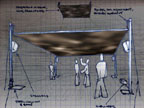
Spatial Experience
Aperture--by transmote.com-- focuses on the ways sound and light affect spatial perception. Spatial experience comprises several related elements. Some of these are ephemeral and difficult to isolate, such as time, context alongside adjacent spaces, and human presence or absence. However, some elements more directly affect spatial experience; in particular, sensory data such as visual changes, aural motion, and tactile input have profound impacts on the way we perceive space.
Multi-channel sonic textures, generated from recordings of existing spaces, encircle the space of the installation. A rear-projected ceiling is used as a display and light source, describing arcs of motion, intensity, and color. Transitions between audiovisual textures echo transitional places in architecture, places that deal with changes in scale, use, material, and motion. By contextualizing these changes of sound and light in physical space, Aperture enables visitors to gain a greater awareness of the composition of their individual perceptions of space.
Aperture is on display as part of Eyebeam's Circuit program from Tuesday, May 9th, through Saturday, May 20th. Eyebeam’s hours are Tuesday - Saturday, 10am-6pm.
Eric will be on hand to discuss the piece during the following times:
Tuesday, May 9th, 4-6pm
Wednesday, May 10th, 6-8pm
Aperture was developed during a fellowship in Eyebeam's Production Studio and is an extension of Contemplace.
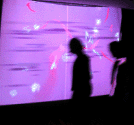
Contemplace is a spatial personality that redesigns itself dynamically according to its conversations with its visitors. Sometimes welcoming, sometimes shy, and sometimes hostile, Contemplace's mood is apparent through a display of projected graphics, spatial sound, and physical motion. contemplace is an environment in which inhabitation becomes a two-way dialogue.
Contemplace is an exploration of possible interactions between people and the spaces they inhabit. Typically, built spaces are passive shells that rely on their inhabitants to provide them with character. What would our spaces be like if they could receive their visitors like a human host?
Contemplace's visual displays and overall structure are built with processing, a java-based programming platform. Contemplace's sounds are generated by max/msp, a graphical programming environment for manipulating sound. processing and max/msp communicate via flosc, a java server designed by Ben Chun to allow communication between OSC/XML-compatible programs over IP. Visitor presence and motion is detected by a webcam and pressure sensors. The same electronic circuit that monitors the pressure sensors also drives a motor that raises and lowers the ceiling with contemplace's mood swings.
Posted by jo at 05:03 PM | Comments (0)
May 03, 2006
Schwelle I: Bardo
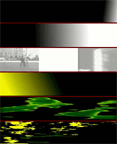
HDV Tryptic for Three Large Screens and Eight Channel Audio
At Elektra7, Thursday, May 11, 2006, 9:00 PM; Usine C, Montreal, Canada.
Schwelle I: Bardo--by Chris Salter--is a turbulent exploration of the experience undergone at the time of the dissolution of the body and consciousness. It is part I of a larger three part performance project currently under development that uses new sensing, electronic, material and computational technologies to tangibly explore the extreme physical and emotional states that might take place in the thresholds before and after death.
Part 1, Bardo, is an extended audio/visual composition/performance lasting approximately forty-five minutes. Partially shot in High Definition video, the work consists of three overlapped and synchronized 720 x 480 projections that form a 2160 x 480 widescreen resolution image with 8 channels of digital surround sound. Over the duration of forty minutes, the spectators undergo a powerful journey through a transforming landscape of abstract, Rothko-like image and dense, tsunami-like walls of sound that builds toward peak intensity, transporting the viewer through the threshold stages of dying and dissolution.
Posted by jo at 11:20 AM | Comments (0)
April 20, 2006
The Aurora Picture Show
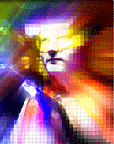
Digital in the Heart of Texas
If you're a fan of video art, live music, or new media performance, Texas is the place to be this week. From April 19-23, The Aurora Picture Show will present their annual Software Cinema festival at venues throughout Houston. The theme of this year's fest is 'Media Archeology,' and it offers a treasure trove of artists, including (in order of appearance) the a/v-jam collective Share, Tommy Becker, Rick Silva, Golan Levin, Sue Costabile, Scott Arford, Tree Wave, Lovid, Yacht, Nate Boyce, My Robot Friend, and Madeline Minx. Billed as a program of 'improvised, interactive, and multimedia performances,' the events will provide introductions to some of the most engaging new media artists practicing in the US. Whether through employment of the super high tech, nostalgically low-tech, or simply everyday materials, each performance will trace the ubiquity of software in our daily lives and in our modes of making and accessing contemporary art. Rhizome's Lauren Cornell and Marisa Olson join artist/producer Nick Hallett as the guest-curators of this year's festival. We look forward to heading south for this lively convergence of innovative and entertaining artists, and to the possibility of meeting a few Rhizome News readers! - Rhizome.org
Posted by jo at 09:58 AM | Comments (0)
January 10, 2006
The Unseen Video
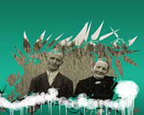
Weather Controlled Video
The Unseen Video is a weather controlled music video for Mike Milosh's You Make Me Feel. The video is affected by the weather and local time of the viewer's localisation. Every little change in their environment ensures that they will never see the same video twice. The look of the video might slightly change within an hour, but will have a whole new character in a few months. More screenshots.
By Daniel Scheibel and Ferdinand Weinrother. Weather-related installations: the Cloudharp, weather report. [blogged by Regine on we-make-money-not-art]
Posted by jo at 08:24 AM | Comments (0)
December 16, 2005
Audio Visual Orchestra
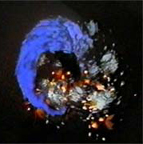
Hallunication, Synaesthesia and Technology
The Audio Visual Orchestra--an HMC MediaLab project--explores the relationship between hallucination and technology, between the natural and the artificial and between the everyday and the mystical. It recreates an altered state of consciousness in the viewer solely through technological means. It is fractaline, chaotic and self-organising in form. These pieces represent a shared space between the physical and the virtual, the brain and the mind.
The Audio Visual Orchestra brings together dancers, musicians and video artists, working to create stunning live art pieces, with an emphasis on combining the spiritual with the technological, culminating in artworks that will react dynamically to your presence. As you stand in the space huge screens show an image of you with colours and shapes flying around your body. The visuals are complimented by strange echoing sounds that react to any noise you make. The sounds and the visuals can be intrinsically linked creating a true synaesthesia.
Posted by jo at 03:30 PM | Comments (0)
December 14, 2005
BOULDER - SCOTTSDALE - SYDNEY - WWW

24 HOUR COUNT: "a blog jam"
The 24 Hour Count is a multi-media blog band made up of Colorado artists Mark Amerika, Rick Silva, and Nathaniel Wojtalik. For this newly commissioned 24-hour online blog performance, the artists will use a variety of media including the Internet, mobile phones, digital video and photo cameras, mini-disk recorders, musical instruments, and many computer software programs to improvisationally remix, interpret, and respond to current events while filtering their "digital readings" through the prism of Count Lautréamont's "Songs of Maldoror," a classic French text written in the 19th century and whom the Surrealists adopted as the progenitor of their significant 20th century movement.
Sponsored by the Scottsdale Museum of Contemporary Art, the Alt-X Online Network, and the TECHNE lab at the University of Colorado at Boulder, the artists performing this distributed multi-media blog performance will be located in three different locations: Sydney, Australia, Boulder, Colorado, and Scottsdale, Arizona.
The event starts December 17th at 14:00 MST/Arizona; 16:00 EST; 21:00 London; 22:00 Berlin; December 18th, 08:00 Sydney.
For 24 hours straight, the three distributed artists will use the same blogging website as the virtual location for their ongoing multi-media jam session. The performance will coincide with the opening of the SOUTHWEST.net:Techno show in Scottsdale, and a living archive of the blog jam site will remain online both in the gallery through May 14, 2006, and on the web throughout the duration of the exhibition and beyond.
Posted by jo at 10:08 AM | Comments (0)
November 29, 2005
Don Ritter Performances
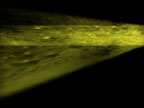
Digestion and Badlands
Don Ritter Performances in Budapest, December 4, 2005; Intro Festival Millinenáris Park, Budapest, Hungary.
Digestion:
Influenced by early 20th Century experimental animation, Digestion presents organic imagery--originating as boiling water--that is interactively transformed into a series of mechanical movements with synchronized sound emanating from the imagery. Using a pair of networked computers, viewers are presented with a hypnotic experience of multi-channel imagery that is controlled by sound. The seemingly unpredictable nature of the work provides an internal interactivity which can be observed by an audience, but not controlled.
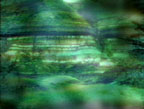
Badlands: Processed imagery of the Canadian Badlands are controlled and manipulated by live music. One or two networked computers use a musical analysis of live music to control clip selection, tempo and cinematic features of the video.
Since 1988, Don Ritter's interactive performances have been presented at festivals, museums, and galleries in North America and Europe, including the Art Institute if Chicago, New Music America (New York), Montreal Museum of Contemporary Art, and Steim (Amsterdam). [Related]
Posted by jo at 12:13 PM | Comments (0)
November 08, 2005
DOUBLE VISION:

Evolutionary Patterns & the Lonely Owl (Mutation #1)
DOUBLE VISION presents Evolutionary Patterns and the Lonely Owl (Mutation #1)--When: November 19 [Sat] 7:30PM (doors close at 8:15PM); Cost: 5-10$ suggested donation; Where: MadHorse Loft, 2200 Adeline St. (Ste. 125), Oakland, CA 94607; Info: 510-535-2504.
Bay Area intermedia performance group DOUBLE VISION is presenting an evening of mutating dance, music, video, and installation. Audience members transmit genetic codes, play cryptic games, and witness the 21st Century debacle of the wise and mysterious owl. Interactive technology and old school human bodies fill in the void between neuron and neurosis. Come play!
Cast of artists include: Claire Barratt / Cilla Vee, Sean Clute, Amanda Crawford, Nick Fox-Gieg, Simran Gleason, Jessica Gomula, Dave Holton, Pauline Jennings, Jason B. Jones, Chris Kruzic, Geoff Kuffner, Amy Leonards, Amy Lewis, Peter Matthews, miss gawker & the tweeker, Amy Nielson, Patricia Svilik, Tim Thompson, Nicole Zvarik.
DOUBLE VISION is an intermedia collective of performers, musicians, dancers, and video-artists. Together, our group creates immersive environments utilizing unconventional spaces and transforms conventional spaces through unconventional means. By experimenting with different methods of collaboration through the adaptation of social systems, transvergence of scientific models, and mapping of algorithmic structures, DOUBLE VISION unifies multifaceted art forms and ideas.
DOUBLE VISION was formed in December, 2003 by Sean Clute and Pauline Jennings as an means to work with others interested in questioning and altering the landscape of dance, music and video. Their first major collaboration came in the form of Involution 2, a cross-country, NY and CA event held at 23 Windowz, Brooklyn, NY. Their interactive dance and animation work Disembodied Head has been performed at the Mills College Signal Flow Festival, WORKS/San Jose, SPARK (KQED), and will be televised on Meaning in the 21st Century, a national PBS broadcast. DOUBLE VISION commonly collaborates with other performers in and outside of the Bay Area, including video artist, Nick Fox-Gieg (LA), Lux (Amoeba Technology, NY), and Zemi-17 (Bali).
During its brief existence, DOUBLE VISION has curated and performed pieces in New York, Los Angeles, Oakland, San Francisco, Albuquerque, and the WWW.
Posted by jo at 05:08 PM | Comments (0)
October 20, 2005
Furthernoise.org + VisitorsStudio
![]()
Live A/V Net Performances
Furthernoise.org presents the 2nd in it's series of live A/V net performances Featuring 2TOMS (France) & John Kannenberg (USA); Sunday 23rd October 2005 16.00-18.00 GMT [Time Zone Converter]: Where: Online; and broadcasting live into the Stills Gallery, where the VisitorsStudio is projected live for 2 months to visiting audiences--23 Cockburns St, Edinburgh, Scotland. Also broadcasting live at the theatre of The Point CDC 11.00 - 13.00 EST--940 Garrison Avenue, Bronx, New York.
Furthernoise.org is hosting a series of monthly live A/V net events and is interested to hear from all audio and visual artists who feel that they could create interesting A/V performances in VisitorsStudio. VisitorsStudio is a live multi-user playground, an audio-visual space for artists and musicians to experiment, jam and perform with a real time, online audience. Please contact roger[at]furthernoise.org for more information.
VISITORSSTUDIO AT STILLS GALLERY, EDINBURGH
VisitorsStudio is currently featured as part of Ricochet, an exhibition at Stills Gallery, Edinburgh 16th October - 18th December 2005. Also including work by Henna Nadeem, Leena Nammari, Chris Dooks, Pamela So.
VisitorsStudio Workshop: Ruth Catlow recently worked with artist Henna Nadeem and young girls (8-13) of Saheliya project at the Stills Gallery, Edinburgh. Marc Garrett joined the sessions working remotely, online from london playing & mixing the live sounds as they uploaded & mixed their own imagery as part of the Stills Ricochet exhibition.
Posted by jo at 11:15 AM | Comments (0)
October 14, 2005
Screen Play

Video as Musical Score
Eyebeam and PERFORMA05 will co-present the premiere of Screen Play, a new work by visual artist and composer Christian Marclay, consisting of a video and three live musical ensembles. Marclay created the video to serve as a score to be interpreted live by a series of invited ensembles. The performances will take place on November 11th at 7pm at Eyebeam, 540 W 21st Street. Tickets are $15 for general admission, $10 for Eyebeam members and students, and may be purchased online through the PERFORMA05 web site.
Marclay was the recipient of the 2005 Moving Image Commission, creating the video score Screen Play in Eyebeam’s Production Studios. The projected element of Screen Play is a combination of found film footage overlaid with computer animation. Marclay chose footage suggesting certain visual rhythms and emotions, which he then worked to accentuate or underscore elements with overlapping computer graphics. The resulting video- reminiscent at moments of a silent film and at others of a flight simulator- becomes the visual score for musicians to interpret live. Musicians leading ensembles during this premiere will include multi instrumentalist Elliot Sharp, the electronic trio TOT- (Tim Barnes, Toshio Kayiwara, and Okkyung Lee) and composer and electric harpist Zeena Perkins.
Christian Marclay: Marclay is a New York based visual artist and composer whose innovative work explores the juxtaposition between sound and vision. Since 1979, Marclay has been experimenting with sampling both visual and audio elements, experimenting with composing and performing to create his unique “theatre of found sound.” He has shown extensively nationally and internationally including solo shows at the Tate Modern, the Hirshhorn Museum and the Venice Biennial.
Performing Ensembles: Zeena Parkins , multi-instrumentalist, improviser, composer, sought after in European and North American 'other music' circles. She is not only one of the pioneers of the electric harp but a composer with a unique vision of how to meld acoustic and electric processes.
Composer/multi-instrumentalist/sound-artist Elliott Sharp pioneered the use of fractal geometry, chaos theory, and genetic metaphors in his algorithmic compositions as well as the use of computers in his improvisation and performance. Sharp has collaborated with influential artists and musicians of many genres as well as producing his own sound sculptures. In addition to creating soundtracks for feature films, Sharp has produced numerous CD’s including his most recent, "Radio Hyper-Yahoo" [zOaR], a collection of collaborations with writer/performers.
TOT Trio- Tim Barnes, Toshio Kayiwara, and Okkyung Lee: Tim Barnes’ drum and percussion work transverses a varied musical terrain. From the 90's as a member of the free folk outfit Tower Recordings to conceptual textural electronic music with Dean Roberts. In 2000 Barnes produced a cd of solo percussion music called All Acoustics. Since then he has traveled and performed extensively in Asia and Europe playing with a range of free players and rock musicians.
From central Tokyo, turntablist Toshio Kajiware, studied photography before beginning in the 90’s to perform improvised music. His obsession with obscure music led him to collaborate and perform extensively. Currently he is a producer for his own label and event series entitled "phonomena.”
A native of Korea, Okkyung Lee used her classical training in cello as a springboard from which to incorporate jazz, sounds, Korean traditional music and noise with extended techniques. In addition to participating in TOT Trio, solo performances, and leading her own ensembles, she collaborates with artists, dancers and choreographers. Her latest album is titled Nihm (TZA 7715) and was produced by John Zorn's Tzadik label.
PERFORMA: Established in April 2004 by performance art historian RoseLee Goldberg, PERFORMA is a nonprofit interdisciplinary arts organization committed to the research, development, and presentation of performance by visual artists from around the world. The organization is founded on a commitment to education, history, and active investigation, bringing diverse audiences, artists, curators, and educators together in new and innovative ways. PERFORMA will commission new performance projects in visual arts, establish a dedicated performance biennial, and provide year-round educational programming for expanding knowledge and understanding of this critical area of visual art and cultural history. Each biennial will include the premiere of a major commission, new visual art performance produced by PERFORMA, performance-related film and video programs, and related educational programming.
Screen Play is made possible with support from Eyebeam’s Moving Image Commission and Highbrow Entertainment.
Posted by jo at 09:45 AM | Comments (0)
October 13, 2005
Map to Sine
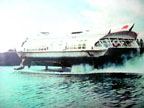
Cartiographic Translation in Sound Experienced by Russian Hydrofoil
Map to Sine is a two-part project by South African artist James Beckett (1977) as part of the international exhibition of contemporary art ADAM, produced by SMART Project Space. Map to Sine is a series of translations from image (cartographic) to sound, based on much of the fascination and formal study of the German Serialist musicians. Exercise such as the rotation of musical pattern, the arbitrary expansion of spacing and the imposition of shape applied directly from nature all formed part of their practice.
With the generous support of the transport company Connexxion, Beckett will host passengers to a live translation of surrounding information of the North Sea Canal, aboard a Russian Hydrofoil - a water rocket of eighties design. The Bulgarian performance artist Zhana Invanova (1977) offers a live explanation of the system in both Russian an English for the benefit of an educational composition.

Dates: Friday 14th, Saturday 15th, Sunday 16th October 2005; Times: Leaving Amsterdam 15:00hrs; 16:00hrs; 17:00hrs; Where do you catch the boat? Connexxion fast service between Amsterdam and Velsen-South (direction IJmuiden); Departing behind Amsterdam Central Station, just to the left of the ferry which crosses the North-Sea Canal; 25 minutes there, 25 minutes back. For more information: www.connexxion.nl
Posted by jo at 10:18 AM | Comments (0)
October 07, 2005
CONTAINED

Improvisatory in Nature
Contained--by MIX--is a collaborative and interactive, hybrid work performance/installation that utilizes technology to blur artistic boundaries and challenges notions of presentation/audience. The artists have created a generative, improvising, real-time multimedia environment using both commercial and custom designed software in conjunction with dedicated hardware sensors, motorized robotics and real time processing or text, video, images and sound. Contained is improvisatory in nature, principles of movement improvisation are employed in the creation of the imagery, sound, and movement generated by the system.
October 7, 8, 2005; 7:30pm; Doane Dance Performance Space; Denison University campus, Denison University, Granville, Ohio 43023 USA • 1-800-DENISON; Performance with Artists' Talk to follow.
MIX is:
Sandy Mathern-Smith, dance,
Alexander Mouton, Art,
Micaela de Vivero, Art,
Christian Faur, Art, Digital Technology
Aaron Fuleki, Music, Digital Technology
Marlon Barrios Solano, dance and interactive art
http://www.unstablelandscape.org/
Mary Sykes, Lighting Designer
Posted by jo at 09:40 AM | Comments (0)
TEMPEST

Van Eck
The audiovisual performance TEMPEST--by Erich Berger--draws its name from a U.S government code word for a set of standards for limiting electric or electromagnetic radiation emanations from electronic equipment such as microchips, monitors or printers. In 1985, Wim van Eck published the first unclassified technical analysis of the security risks of emanations from computer monitors. Because of his research radiation from computer monitors is sometimes called "Van Eck Radiation" and the associated surveillance technology "Van Eck ". "Van Eck " means that computer screen content can be reconstructed remotely by picking up the emitted EM-field of the computer screen.
The performance TEMPEST utilizes the basic principles of this technique to transform purely generative graphic into a tight and intense composition of sound, noise and light. Several AM receivers are tuned into different frequencies of a computer screen and their outputs are plugged into an audio mixer for further sound processing. The graphics on the computer screen (seen by the audience via 2 large projections) become a means of producing sound and it is only the generative graphics which determine the different timbres and rhythms. A feed of the audio back into the image generating process adds a chaotic layer and so TEMPEST becomes a synaesthetic instrument mastered by surfing the space of possibilities evolving from this autopoietic process. [via Art from code - Generator.x]
Posted by jo at 08:45 AM | Comments (0)
October 02, 2005
Institute of Artificial Art Amsterdam

Interface
Arthur Elsenaar and Remko Scha cooperate in the "Institute of Artificial Art Amsterdam" (IAAA). They jointly developed a series of automatic performance-pieces, video-installations and audio-installations. At the 1997 Ars Electronica Festival they premiered Arthur and the Solenoids: an "algorithmic choreography" piece which displays computer-controlled motions of human facial muscles, accompanied by computer-controlled electric guitars. Their lectures on computer-controlled facial expression (with computer-voice "Huge Harry") were presented at many scientific conferences, theatre festivals and art exhibitions, including the Dutch Electronic Arts Festival, the Annual Meeting of the American Anthropological Association, and the Research Colloquium of the MIT Media Lab. Elsenaar and Scha also carry out experiments with automatic broadcast radio and with new forms of internet radio. Their theoretical and historical reflections on technological art were published in journals such as Mediamatic and Leonardo Music Journal. Read PDF. [originally posted by nick from Grand Text Auto, ReBlogged by Fede on Reblog]
Posted by jo at 10:18 AM | Comments (0)
September 27, 2005
SEDIMENTAL JOURNEY!
10/3 - 7:30PM PDT (10:30PM EDT) Songlines Series, Mills College - Pauline Oliveros with Stuart Dempster perform a SEDIMENTAL JOURNEY! via iCHATav with Pauline in Troy in the iEAR Studio at RPI and Stuart in Seattle at the DX Center, U Washington and the duo appearing on screen in the concert hall on the Songlines Series at Mills College Oakland CA.
This concert is commemorating 50 years of musical friendship between Pauline & Stuart. Other collaborators include June Watanabe-choreography, Scot Gresham-Lancaster-video and networking design, Les Stuck-technical direction. Possibly the concert will be streamed onto the INTERNET as well. Otherwise attendance will be in three places: Oakland, Troy and Seattle. Contact: John Bischoff bischoff[at]mills.edu Songlines Series, "J. Pampin" pampin[at]u.washington.edu-Center for Digital Arts and Experimental Media (DXARTS), University of Washington, Seattle, Pauline Oliveros paulineo[at]deeplistening.org, Arts Department Rensselaer Polytechnic Institute.
Scot Gresham-Lancaster: http://o-art.org/Scot
podcast: http://feeds.feedburner.com/OrchestrateClangMass
blog: http://clangmass.blogspot.com/
Posted by jo at 09:55 AM | Comments (0)
September 22, 2005
amorphy.org
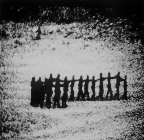
a synchronous union
amorphy.org produces original works of live performance and installation connecting image, movement, and design elements in a synchronous union that creates incredibly detailed performances. To push boundaries of presentation, interactive technologies are utilized in selected works (optic tracking systems, sensor interfaces, live video mixing, Max/MSP programming software, etc.) Issues such as difficulty of communication amidst never-ceasing technological advance are tackled and dissected; impact of close proximity urban living, politically and sociologically inspired topics of interest, and other fascinations. The work is intrinsically hybrid in nature, meaning the merger of art forms to create an integrated performance. We are humans living in a complex world and the work we create is likewise complex and packed with layers where each element can be viewed as a discrete layer that combines to create a complete whole. Although amorphy.org is a structured entity, the work is collaborative in nature and new colleagues enter on per project basis and in some cases strike long-term partnerships. The present goal of the company is to continue challenging existing models of art creation with an emphasis on a co-existence and fusion of interactive media and performing arts. As a long-term goal amorphy.org is in the process of creating the first Media Lab Center facility in Greece in the next two years with the kind support of governmental and private funding bodies.
Posted by jo at 07:35 AM | Comments (0)
Strainings

Sift, Sort, Stretch, Pull
To see is to choose. To see is to select something and overlook something else. To be seen is to exist. When someone set sights on you, you appear in the other persons world.
Strainings--by MusicalFieldsForever--is about this genesis: to select what you want to keep from that which should be left out. In a physical, personal and cultural sense. Strainings is an interactive sound and light (audiovisual) installation contained in a silo. The many interpretations of the word "strain" embrace all of this: to sift and to sort, as well as to stretch and pull a string. In Strainings the audience decides what should be heard and seen. By pulling strings, they change the mesh of the strainer/ the large web. Light, sounds and images are strained and created.
Strainings consists of 7 light ropes 6 meter long, hanging from the roof and pulled through a web of flexing rubber bands. Interacting with the light ropes changes the structure of the web that cast shadows on to the projected images on the wall. A camera analyses movements in the light ropes and the input is used to change and make variations in the light, the light ropes and the sound. The background sound consists of bell frogs recorded in Baldringe, Sweden, strings and synthesised sounds that change, mix, and filter generatively. The interaction sound consists of trumpet loops with granular synthesis making it possible to play continuously and changing tones when pulling the ropes.
The software is developed in Max/MSP and SoftVNS. [via]
Posted by jo at 07:00 AM | Comments (0)
September 21, 2005
Five Streams
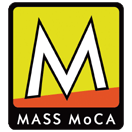
Anarkali, Bhagavad-Gita, and Who Knoweth Himself
In a piece stunning to both the eyes and ears, this work-in-progress by Ibrahim Quraishi reinterprets ancient texts to examine Islam in the five nations of South Asia-India, Pakistan, Bangladesh, Nepal, and Sri Lanka. Five Streams is a theater performance that integrates live and pre-recorded voice, dance, 3-D animation, and interactive sound installations to illuminate the three foundational texts in the cultures of the region: Anarkali, a tragic court romance of Mughal India; the Bhagavad-Gita, the deeply philosophical climax of the Indian epic Mahabharata; and Who Knoweth Himself, a mystical treatise by the Sufi philosopher Ibn al-Arabi. Paul Miller a.k.a. DJ Spooky and choreographer Parul Shah are among a large group of collaborating artists, many of whom will participate in a 2-week residency at MASS MoCA. Presented in collaboration with The Asia Society. [via eyebeam reblog]
Posted by jo at 09:37 AM | Comments (0)
September 15, 2005
Mediate
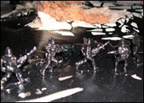
Modern Day Rites and Invigorating Spectacle
Mediate--by Brian Knoth (aka Theta State)--is a spiritually and socio-politically charged thirty-minute multimedia installation intended for alternative art spaces. Utilizing shamanic ritual as a conceptual backbone, a mixture of original music, video, performance art and mixed-media sculpture abstracts the transformational experience.
Original music, in a sometimes cacophonous and contradictory mix of tribal-electro pastiche surrounds... creating a completely immersive experience. Moving image tweaks consciousness in conceptually and viscerally driven image juxtaposition...Progressions through a childhood regression, evoke the modern day rite...In concert, projected word clusters reflect and deflect, visually echoing the critical deflection inculcated in our status quo culture. The piece crescendos in an invigorating spectacle of sound, text, image and light.
Next Exhibition: As part of Arts Central 2005..., Sunday, September 18th 12-6pm @ Cambridge Community Television (CCTV), 675 Mass. Ave., enter on Prospect Street, Cambridge, Massachusetts.
Posted by jo at 10:09 AM | Comments (0)
September 14, 2005
Artistic Interfaces:
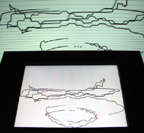
Between Instrument and Artwork
"At three separate venues at Ars Electronica 2005 in Linz, Thomas Petersen found examples of hybrids between artworks and artistic instruments, which explore the relations between sound and vision in physical and virtual space. In this article he offers a few perspectives on what we can learn from these artistic interfaces.
Creative Interactivity Required: Certain types of digital artifacts place themselves firmly in the border zone between instruments for artistic production and artworks. They are 'artistic interfaces' in both senses of the concept. On one hand, they constitute useful interfaces for users to create independent artistic expressions. On the other hand, these tools are artworks in their own right, which offer critical perspectives on the concept of the instrument itself and the dynamics of the creative process.
In the field of digital culture the difference between instrument building and art-making can often be quite subtle. In some cases there are not necessarily any structural differences between an interactive artwork and an interactive space for users to produce aesthetic experiences because they can share characteristics as interactivity, interchangeability, transformation, user-controlled graphics and sound etc. Of course many digital pieces are a far cry from resembling tools e.g. genres like hypertext fiction, point-and-click game environments etc. The defining characteristic of the artistic interface is a specific type of interactivity where the common denominator is a large number of reconfigurable elements, the total sum of which create a manipulable space into which the user can project ideas and expressions. This space depends totally on direct creative interaction from the user.
Each of the following pieces are frameworks of possibilities and limitations. They do not promise more complex or superior results than conventional or analogue instruments, but constitute specific explorations of the production of aesthetic results within certain boundaries. These pieces are critical approaches to the technologies of creative production and can be considered as complex artistic statements in themselves.
Drawing Sculptures of Sound: An immensely popular work at the Cyberarts exhibition at Ars Electronica was Amit Pitaru's Sonic Wire Sculptor, which received an Honorary Mention in the Interactive Art category. This piece attracted quite a crowd in a stuffy room at the O.K Centrum für Gegenwartskunst.
Sonic Wire Sculptor deals with the production of sound by means of three dimensional wire drawings. It explores the correlation between vision and sound as the user literally draws the sound with a pen at a drawing station. The drawings are inserted in a rotating 3d-space as spinning wire sculptures. As this virtual space rotates 360 degrees, the sculpture is interpreted by the computer and transformed into sound according to the initial speeds and positions of the drawings. The vertical axis determines the pitch, notes are indicated by horizontal lines and a metronome can be found at the centre of the stage. The user can save and retrieve the sculptures, stop the rotation and reposition the compositions freely to reconfigure the elements within a new tonal space. The installation of the piece in the exhibition space is based on surround sound so the sound in the physical space reflects the structure of the virtual sculpture.
Compared to many other similar projects the piece distinguishes itself by actually being playable as a performance instrument. It can be used as a precise musical instrument by means of the guidelines to achieve specific notes and precise rhythm. A practical implementation into a joint performance setting is definitely conceivable. The piece is a critical approach to the production and representation of sound at the same time. The wire sculptures are an original counterpart to the conventional note system and a dynamic equivalent to graphic notation systems like the ones used by composers like John Cage, Brian Eno etc.
A Playful Physical Sequencer: A similar project is Golan Levin's Scrapple: A physical active score table, which was presented at the Ars Electronica Center across the Nibelungen bridge. As with Pitaru's Sonic Wire Sculptor, Levin's piece Scrapple deals with the transformation of shapes into sounds. In this case the piece is based on the configuration of physical objects on a table, transforming them into a musical score.
Instead of placing samples in a sequencer or notes on paper, Scrapple adds a physical dimension to computer-generated music. The user has to move and adjust objects to indicate rhythm, tones, melody etc. The visual result quickly ends up as an abstract composition of shapes corresponding to sound. The strength of the piece is not so much being a precise musical instrument but rather a very enjoyable toy appealing to the playful interaction between several users at a time. It also adds a bodily aspect forcing the users to move swiftly around the table.
Other projects by Golan Levin touch upon similar aspects. In The Manual Input Sessions, hand gestures, finger movements and other objects are analyzed by custom software generating graphics and sounds. In Yellowtail, virtual worm-like creatures are drawn by the user on a screen and transformed into sound by a scanning mechanism.
Augmented Table Composition: Going back over the bridge to the 'Interface Culture' exhibition at Kunstuniveristät Linz (Art University of Linz) The reacTable* was exhibited next to a number of experimental interfaces. This particular piece was developed at the Music Technology Group, Pompeu Favra University, Barcelona.
The instrument consists of a round table and plastic objects marked with various symbols. Based on these symbols a camera tracks the position and direction of the objects when they are placed on the table. When one of the objects is placed, the particular symbol is recognized and the immediate environment is augmented with graphics indicating the functions of the element. Some of the objects produce sound and other objects modify these sounds. Some events can also affect the general visual appearance of the table. The total sum of events creates a dynamic, tangible interface with virtually unlimited possibilities in the creation and visualization of sound. The visual result is a stunning abstract animation generating buzzing, clicking and humming compositions.
The interface allows the composer to handle physical objects to generate digital sound supported by a full range of dynamic visualizations. As opposed to the widespread use of e.g. the laptop as a performance instrument, the strength of reacTable* is its tangibility and involvement of the user's body to manipulate digital sound. reacTable* has a social and telematic dimension as there is the possibility of involving distant participants at a shared table. The piece was used in a collaborative performance between Linz and the ICMC conference in Barcelona Spain. The two tables shared musical components and the composers could affect each other' s components in a shared performance situation.
Basic Research: The range of strategies shows us that the visualization/notation of sound is not an unequivocal project. The correlation between sound and vision is a magnet for pioneering instrument builders, simply because this space can never be definitively charted. Each instrument constitutes an interpretation of the ephemeral nature of sound and a longing to map it. The result is an abundance of complex analyses of aesthetic transformations and some very interesting artistic interfaces.
The sheer amount of different strategies of this kind points to the fact that the artistic instrument is under full-scale development these days. These experimental instruments can be regarded as basic research into alternative ways of creating and visualizing music. Because they take place as an experimental practice between art-making and instrument building they can establish interactive spaces which may not have the potential to survive on a commercial market. Certain aspects of these instruments will most likely find their way into commercial production and some of them will maybe become commonplace performance tools - some will not. Whatever their future destinies may be, they are nonetheless important as singular statements and they demonstrate the importance of experimental spaces to develop and test new approaches to artistic tools." [originally published by Thomas Petersen, artificial.dk]
Related links:
- Online version of Amit Pitaru's Sonic Wire Sculptor: http://www.pitaru.com/sonicWireSculptor/
- Amit Pitaru's website: http://www.pitaru.com
- Golan Levin's website: http://www.flong.com
- Yellowtail by Golan Levin: http://www.flong.com/yellowtail/index.html
- The Manual Input Sessions by Golan Levin: http://tmema.org/mis/
- reacTable*: http://www.iua.upf.es/mtg/reacTable/
- A list of tangible musical interfaces: http://www.iua.upf.es/mtg/reacTable/MusicTables/
- Ars Electronica website: http://www.aec.at
Posted by jo at 11:53 AM | Comments (0)
September 06, 2005
TeleMurals
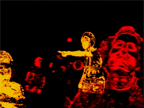
Blending [Distributed] Participating spaces
Telemurals is an audio-video connection where a communication space is created by breaking apart the pixels and speach of the participants at each end and reassembling them abstractly. The initial setup is straightforward. Two disjoint spaces are connected with an audio-video wall. Video and audio from each space is captured. The two images are then rendered, blended together, and projected onto the wall of their respective space. The difference between Telemurals and traditional media space connections are the image and audio transformations that evolve as people communicate through the system and the blending of the participating spaces.
Participation is required for this communication space to work. To reinforce a sense of involvement, we provide the system with some intelligence to modify its space according to certain movements and speech inflections. First, the image is rendered non-photorealstically. Second, words spoken in both spaces are captured, converted to text, and rendered on the screen in blocks left to fade away over time. The immediate feedback of seeing one’s spoken word alter the window lets them know they are adding to and affecting the shared environent. More complicated image manipulations are affected by changes in pitch and volume of the voice.
Much research has been conducted on the benefits and limitations of adding video to an audio communication channel. One of our goals here is to see how using non-photoreastic images influences conversation. Adding video to a communication channel improves the capacity for showing understanding, attention, forecasting responses, and expressing attitudes. A simple nodding of the head can express agreement or disagreement in a conversation. Gestures can convey concepts that aren’t easily expressed in words; they can express non-rational emotions, non-verbal experiences.
Yet these cues are not always properly transmitted. There may be dropped frames, audio glitches. Lack of synchronicity between image and audio can influence perceptions and trust of the speaker at the other end. Other challenges include equipment placement. For example camera placement has long been a reason for ambiguous eye gaze in audio-video links. A large camera offset gives the impression that the person you are speaking to is constantly looking elsewhere.
With Telemurals, we are creating an environment where rendered video maintains subtle cues of expression such as posture and hand motion, yet also enhances other cues. For example, changes in voice volume and pitch may be represented in the graphics of the rendered video. Audio conveys the speach inflections in conversation by altering parameters of the rendering. By adding another layer of abstraction into the video stream, we can enhance cues in a manner that is not possible in straight video streams.
Abstracting the faces is of big concern in the rendering. It builds on the intrigue of how one would appear if transplanted into this filtered space. Caricature and cartooning are such types of abstractions. There are elements of curiousity, humor, and surprise when seeing a caricature yet there is enough resemblance to make a personal connection.
The creation of an abstract environment in Telemurals has some similarities to virtual spaces in online worlds. Examples of fantasy environments for conversation can already be seen in online graphical communities. One essentially puts on a mask and enters an electronic communication space. This element of mediation removes many of the social barriers by allowing one to safely enter a stimulating world. Just as this lack of concrete identity may aid in suddenly and continually confronting new people in virtual environments, it may help in our physical-virtual hybrid. It has the added benefit of mitigating the perception of offset eye gaze and the effects of unsynchronized audio and video.
In this project, the abstraction of person, setting, and feedback provide the social catalyst for the experience. This new wall created by filtering creates an ice-breaker, a common ground for interaction, and a object for experimentation. How will one communicate in this abstracted space? How will their behavior affect their appearance and the appearance of the setting? How different is communication using photorealistic vs. non-photorealistic video? The goal here is to create a new styles of movement and speach interaction by providing a common language across the two spaces.
The first Tele-mural installation will connect two MIT graduate dormitories, Ashdown and Sidney-Pacific. The Tele-mural in Ashdown is located in the lower level in the common reacreation room. In Sidney-Pacific, the Tele-mural will be placed near the main entrance. This connection came about as the under-construction Sidney-Pacific dormitory committee was looking to put public art in its public areas and create spaces to encourage students to gather. Ashdown, the oldest graduate dormitory on campus was similarly undergoing renovations to create public spaces for social gatherings and the two dormitories were open to the idea of linking the older dormitory to the newer one. The sites within the dorms were chosen because they have high levels of traffic, are openly public , and because a large video wall aesthetically blends into the space.
Posted by jo at 10:52 AM | Comments (0)
August 30, 2005
Hard Drive Orchestra
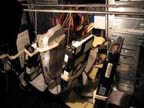
Radio Taking Place Between the Ears and Behind the Eyes
Hard Drive Orchestra--by Fundamental Radio (August Black and Markus Seidl)--is a sculpture and instrument that can be programmed to run autonomously as a stand-alone installation or played live and intuitively in a performance taking control commands via OSC, midi, or some other input protocol.
The hardware component consists of a mobile computer containing 8-16 IDE and SCSI hard drives of various ages of computing history and therefore of various sonic properties. The mechanical sounds of the drives are recorded live with 8-16 separate contact microphones, cleaned by a noisegate, and amplified over loudspeakers.
The software component consists of two objects written in C for PureData. One object performs very specific read-write operations on the various hard disks in order to force the disk's head to move from the innermost part of a drive's platter to the outermost part and back again. This results in an audible grinding click. The second object reads the data being written on each disk and blits it to the video screen. Essentially, the first object allows one to control the sonic activity of each drive while the second object simply displays the data to screen.
With the Hard Drive Orchestra, Fundamental Radio can analyze and present the physical, mechanical, and most importantly, the aesthetic properties of stored information. The HDO has premiered with "The Physical Mechanism of Forgetting" at the Freud Museum in St. Petersburg [Bolshoi Prospekt, Petrogradskaya Storona, 18a] as part of Traumlandshaften festival from October 7-10, 2003. There, the successive versions of the ****soft operating system have been deleted, slowly, over a week cumulating into a live performance of found and submitted data.
Posted by jo at 09:08 AM | Comments (0)
August 24, 2005
Career Moves
Players Can Create Their Own Semantic Systems
Career Moves--by Mary Flanagan--explores the contradictory world of women in corporate America through an interactive, computer controlled board game. Work is a troubling condition internationally for all women. Women represent 50 per cent of the world adult population and one-third of the official labour force, but they perform nearly two-thirds of all work hours, receive one-tenth of the world income and own less than 1 per cent of the world's property...
This commercial style is intended as a critique of the historical sequence to which the popular board game belongs: many games have traditionally supported social "norms," including heterosexuality, consumerism, and especially non-liberatory positions for women. However, as players progress down the board, it becomes clear that it is they themselves who are determining the rules of the game, and the collective and individual goals become apparent...
To participate in Day of the Figurines, the player must first visit a physical place. Here, they find a large scale model of an imaginary town at table height. The model is 1:100 and extends for several metres in all directions. The image is a mix of computer graphics and photographic collage.
The town has identifiable buildings such as the YMCA, the Big Chef, Video Zone, the XXX Cinema and the Battle of Trafalgar Square. There are other features such as a Cemetery, a Gasometer, a canal, a Level Crossing and an Underpass.
To play the game the visitor selects from a display of one hundred plastic figurines. They give the figurine a name, answer a few questions about him or her and then watch as she or he is placed at a random location into the model town. As they leave the space the player is given a small map of the town and a set of rules for the game.
An hour or so later the player will receive their first text message from the game, asking where their figurine would like to go. By replying to the message with the name of a place in the town the player’s figurine is set on the path towards that destination. Each hour a turn is executed and the invigilator moves each figure a small distance towards their destination. There are 10 turns a day for 24 days.
Intermittently each player receives text messages to alert them to nearby figurines in the model city, to their figurine’s arrival at a destination or to other events in the town. Each destination has a short description. For example, if you arrive at the The One Club you receive the SMS: “Home of the 2 Fs. The lock ins are legendary, the fire escape stairs have seen it all.” The goal of the game is “to help others”. Texting messages to other players may provide opportunities to do this.
The project is deliberately targeting low-end phones: it is playable on any phone that is able to receive SMS. Instead the technological focus is on orchestration and management tools. During the long-term test period, 8 players have been given phones that log Cell ID and upload this information to a server. We aim to use this data to assess when players are engaged, when they are most likely to play and how the game fits into their daily activity pattern. We will also carry out phone interviews with selected players at key moments, to study the interaction between game play and daily life.
Posted by jo at 10:12 AM | Comments (0)
August 17, 2005
R&Sie(n)’s Dandy & Mutant A-life Architecture

I’ve heard about…©
R&Sie(n)’s Dandy & Mutant A-life Architecture by Joseph Nechvatal: R&Sie(n)’s exhibition “I’ve heard about…©” opened on the 6th of July at the Musee d’Art Moderne de la Ville de Paris‘s temporary space at the Couvent des Cordeliers - and I think it is one of the most relevant exhibitions to what is going on in art today that is of importance. R&Sie(n) is an investigational architectural firm consisting of François Roche, Stéphanie Lavaux, and Jean Navarro; working here with Benoît Durandin. Together, they utilize generative heterogeneous mutations in the creation of proposed utopian city spaces. In fact what they propose at the Musee d’Art Moderne is the artificial growing of extruded urban housing (generative & robotic) - where new cities are constructed via robotic processes by feeding off the carcasses of older dying cities. Very viral. Envisioned is an approach to city planning based on growth scripts and open algorithmic procedures. Towards these ends the show itself includes some subtle audio tracts, model-sculptures, a fully immersive hypnosis chamber with video monitors, booking services, 3D movies and robotic drawings/plans that reveal the source code of the generative program at the heart of their work.
There is a definite tangled and intertwined approach to the city vector that reminds me of the dithyrambic visual hyper-logic which has manifested in all modes of decadent artistic periods; from the Hellenistic and Flamboyant Gothic, to the Mannerist, Rococo, and Fin-de-Siècle - as they all opposed dogmatically imposed ocular paradigms with hyper-engendering strategies of form. The multiplicity of its interwoven experiences challenges the now bogus idea of simplicity – a modernist-minimalist idea which has taken on the intensity of a righteous injunction in many cities where the implied equation between simplicity, surveillance and goodness obscures a less evident function: that of cognitive constraint. Such constraint runs counter to what Georges Bataille considered to be the non-hypocritical human condition, which he took as being roused non-productive expenditure (threshold excess) entangled with exhilaration. For the finest comprehensive overview of Bataille's thought in this regard, see his book Eroticism - but also Denis Hollier's book on Bataille's general postulates, Against Architecture.
Given the organic-like, biomorphic architectural forms R&Sie(n) spawn by their generative program, I could not avoid thinking about the Palais Idéal of Ferdinand Cheval (1836-1924) - which to my eyes appeared to be one huge budding edifice when I visited it a few years ago - as if the stupendous mannerist grotto-façade at villa Borromeo had been left to grow untrimmed and run amok. However, the Palais Idéal was constructed by the postman Cheval alone and by hand in the Hauterives (Drôme) (near Lyon) between the years 1879 and 1912; the result of 93,000 man hours of hard labour. R&Sie(n) rightly prefers the work to be accomplished through a computer programmed emergence via artificial intelligence which directs robotic execution. Why should humans physically work when we might better be playing and dreaming?
The other inescapable reference for R&Sie(n)’s work is the visionary city-planning put forth by the Situationists. One thinks immediately of Guy Debord’s essay On Wild Architecture, for example. Like the Situationists, for R&Sie(n), the urban form no longer depends on the arbitrary decisions or control over its emergence exercised by the elite few. Ultimately R&Sie(n) leads us towards juicy Situationist-like complexities and engagements by way of immersion into an open-ended multiplex conceivable as a virtual environment: the Virtual Reality experience.
As R&Sie(n) say themselves, “Many different stimuli have contributed to the emergence of “I’ve heard about…©” and they are continually reloaded. Its existence is inextricably linked to the end of the grand narratives, the objective recognition of climatic changes, a suspicion of all morality (even ecological), to the vibration of social phenomena and the urgent need to renew the democratic mechanisms. Fiction is its reality principle…” Ahhhhh, the domain of decadent art, VR and artifice. Against Nature.
What has been somewhat poorly determined however is the degree a dweller feels totally immersed in an optically excessive space. And this depends to a large extent on personal psychological need and adaptability in accord with the proposed spatial depth cues. Cognitive-aesthetic space has to be coordinated phenomenologically with the proprioceptive space of the eye - and R&Sie(n)’s only failure is in maintaining the evident structural seams of the immersive faux-hypnotic chamber (the only enterable structure and the highlight of the show) because what the entire show is proposing is a seamless immersion into generative totality, and the visual seams take us out of that exquisite fantasy. So they are denied the loveliest of triumphs.
A pity, as one might otherwise imagine oneself totally immersed there somewhat like a 21st Century dandy. As at the birth of the 20th Century, this new hyper-dandy constantly might affirm his or her originality down to the decorative details of the home. In that the robots are doing the algorithmic planning and building, this work definitely proposes a new form of dandyism - if dandyism’s defining characteristic is remembered to be the making of one’s person a work of art while extolling laziness and displaying contempt for work. Evident here are the Baudelairean/Duchampian dandy ideals of impassivity, nonchalance elegance, and inscrutability. What matters are the triumphs of a radical contempt for one’s “hand”.
Indeed one can say that “I’ve heard about…©” favorably extolled artificiality, indifference, impassiveness - the reign of an ironic causality and knotted ambivalence, while staying open to all transactions. Most importantly, a-life forms are embedded within it and its growth is artificial and synthetic. So R&Sie(n) maintains a version of transcendental phenomenological idealism, but they do not disavow the extant actuality of the material sphere. Instead they seek to elucidate the sense of the world-as-is today - that is viractualized – by stressing the embodied nature of human and artificial consciousness and bodily existence as the original and originating material premise of sense and signification.
All told, the show is well done – as proposition. However this proposition inevitably turns the mind to the actualized imposing suavity of Antoni Gaudí’s fully realized wavy architectural shapes in Catalonia. Although he did not travel about Europe, Gaudí was aquatinted with fin-de-siècle Belgium/French avant-garde movements because of the intimate relationship between Barcelona and France and with the pre-modernistic movements of Arts and Crafts, Gothic Revival, and Impressionism which were discussed in the intellectual proto-modernist circle which he frequented. But it was Victor Horta's Art Nouveau movement that influenced Gaudí the most, stimulating him to experiment with new materials and new fluid shapes that appear grown. Gaudí's version of Art Nouveau is characterized by an overwhelming proclivity for the organic nature of women, beasts, and plants which he translated into immersive utility.
Antoni Gaudí is a chief exponent of R&Sie(n)-type open algorithmic building procedures precisely with his 1906 building Casa Batlló located at 43, Passeig de Gràcia, Barcelona - noticeable for its organic tactility of bones and shells within, and its external cocked surf façade and chimerical roof. With Casa Batlló, Gaudí accomplished an astute transformation of an existing building, transforming it into an enchanting immersive gesamtkunstwerk as Gaudí thoroughly undertook the design of every single element of the building, from the extravagantly protuberant façade to all aspects of the interior, including the gracefully gnarled furniture. On the exterior Gaudí was able to combine a flamboyantly surging façade (in an ingeniously cool-color orchestration) while maintaining a dialogue with the neighboring Casa Ametller (1900), built by Josep Puig i Cadafalch (1869-1956) four years earlier. Powerful pillars which resemble the substantiality of mammoth elephant legs accost the visitor at street level, protruding into the sidewalk, nigh tripping up an unaware pedestrian. These legs are bordered by a craggy vertebrae-like tier and the wavy façade extends upward between these two biologically evoking forms, culminating at the roof in a gargoylesque humping crescendo. The façade itself, coated in a layer of Montjuïc stone, shimmers seductively under the sun in multifarious chameleon-like colors; fraught with a scattering of small roundish plates resembling fish or reptilian scales. Affixed to this seething mass of swelling construction are a number of small, elegantly curved balconies with oval shaped portholes.
The entire structure feels unsharpened, flowing and smooth in opposition to the street itself on which the arrangement sits, with the exception of a few square windows up top. Even the walls are gently rounded in strained undulation and contraction, as if they too have entered into the oceanic female throws of a fluttering uteral orgasm. The walls appear to be made of a soft, smooth, supple, leathery material and this illusion of softness is carried through by the roundness of the inside forms of the building where one has the feeling of being pleasantly encased in an expanse of hardened dripped honey. Turning, lunging stair railings are met, engulfed and supplemented by softly heaving honey-colored walls and wooden biomorphicly shaped carved doors and irregularly shaped windows. There are no right angled corners or straight lines, which offers an impression of being wrapped up in one continuous fluid wave motion, complimentary with the exterior. By comparison, R&Sie(n) still has a ways to go in achieving a like sensuality of its avant-garde stance. But one only hopes for them an immediate success in doing so.
Credits:
R&Sie(n) = François Roche, Stéphanie Lavaux, and Jean Navarro with Benoît Durandin
With the production and authorship of :
-Berokh Khoshnevis (Contour Crafting Process, USC, LA)
-Francois Roustang (Hypnosis specialist, Paris)
-Chris Delaporte (Film director, 3D effect, Paris)
-Christophe Berdaguer & Marie Pejus (Artist, Marseille)
-Mathieu Lehanneur (Designer, Paris)
-Laurent Genefort (Science Fiction writer, Paris)
-CNRS Grenoble, Laboratoire de Spectrometrie (Nano Particules)
-M/M (Graphic designer, Paris)
-Gilles Schaeffer (mathematicien, Paris)
-Michel Boulcourt (Landscape architect, Paris)
-Alexandra Midal (Author, Paris)
-Matthieu Kavyrchine (Video artist, Paris)
-Sebastien Szczyrk (Sound designer, Paris)
-Alexandre Merlet (Video producer, Paris)
-Stephan Henrich (Architect, Germany)
-Providence (Singer)
Prototype / installation / publishing
-Ufacto, David Toppani (prototype scale 1)
-One Star Press (neighbourhood protocole publishing)
-Christian Hubert Delisle (prototype)
-Thibaut Boyer (installation)
-Jean-Michel Castagné (electronic driver)
Sponsors, partnership
MAM Paris-Musée (F), MUDAM (L), De SINGEL (B), USC (USA), KANAZAWA 21st century museum (J), CNC / Dicream, (F), LAFARGE (F), Materialise (B), Next Limit Technologies (SP), DAPA (F), University of Architecture Innsbruck (OST), New-Territories (F)
Show closes the 9th of October. Musee d’Art Moderne de la Ville de Paris / Couvent des Cordeliers / 15 Rue de l'ecole de Medecine / 75006 / Phone : 0156813321
Images and more info available at: www.mam.paris.fr
Even more info available at: www.new-territories.com
Posted by jo at 08:06 AM | Comments (0)
August 13, 2005
DOUBLE VISION:
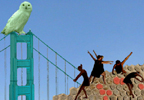
Evolutionary Patterns and the Lonely Owl
Bay Area intermedia performance group DOUBLE VISION is presenting a new work combining elements of dance, music, video, and installation in an immersive evening of cellular struggle, oscillating flesh and digital drama. Adapted from John Conway’s Game of Life, performers and technology dynamically respond to one another creating unusual and sometimes beautiful patterns within the vast gallery space of WORKS/San José.
Cast of performers include: Liz Bootz, Sean Clute, Amanda Crawford, Dorsey Dunn, Dave Holton, Marielle Jakobsons, Pauline Jennings, Jason B Jones, Amy Leonards, Amy Nielson, Sonia Reiter, Isabelle Sjahsam, Max Stoffregen, Agnes Szelag, Bill Wolter and Nicole Zvarik.
DOUBLE VISION is a collective of performers, musicians, dancers, video-artists, and technology aficionados. Together, the group creates events and immersive environments utilizing unconventional spaces or transforms conventional spaces through unconventional means. One of their primary objectives is creating links between the physical world and digital worlds using computers, sensors, networks and custom-designed software interfaces.
When: September 24 [Sat] 8PM
Cost: 8-10$
Where: WORKS/San José, 30 North 3rd St, San José, California
510-535-2504
Posted by jo at 10:03 AM | Comments (0)
August 12, 2005
Orchestra of Anxiety

The Concept of Security
In Orchestra of Anxiety, London-based artists Manu Luksch and Mukul Patel expand their ongoing explorations of the concept of security. While 'security' can be seen as desire, as ideology, as illusion but never as a guaranteed status quo, socio-political measures of control, ... have been implemented in the name of security. The security industry is one of the fastest growing sectors this decade, and is worth hundreds of billions of dollars annually. A participative installation piece--to be shown at Watermans Gallery--Orchestra of Anxiety deploys security and surveillance technologies in an unusual and playful context, prompting visitors to reflect on their personal sense of security and their relationship with public fears (of petty crime, terrorism, etc.).
The central focus of the installation at Watermans is a harp, traditionally regarded as a sacred or metaphysical instrument associated with tranquillity, love and goodness. However ambientTV.net’s harp differs from standard harps as it is strung with razor wire, requiring the harpist to wear protective gloves while playing. The protective gloves complete data circuits when a string is touched, triggering multiple projections and sound sources in the gallery. Before playing, the harpist must first overcome the instinctive anxiety the instrument provokes.
Orchestra of Anxiety is produced by inter-disciplinary arts production company ambientTV.NET. ambientTV.NET highlights models of networked and collaborative practice. Techniques and effects of data transmission provide theme, medium and performative space for works spanning installation, performance, documentary, dance, gastronomy, and live sound and video art. Much of the film and music production is freely disseminated through the website.
Posted by jo at 08:45 AM | Comments (0)
August 04, 2005
EA's m/M
Six Hour Continuous INSTALLATION-PERFORMANCE
EA's m/M: [1] As computers keep offering us the ability to play with numbers in increasingly complex ways, our perception of proportional relationships is being exponentially challenged. We begin to realize our involvement in a ubiquitous hyper-game where reality fades into its own representation. [2] Even time is no longer regarded as an absolute parameter to which safely anchor ourselves. With the realization of these, ever-shifting dynamics comes the desire to take on an active role and to start interacting with the idea of relative magnitude, and with the way in which we perceive proportions. Microphones and amplifiers, optical lenses and projectors are some of the instruments that make it possible for us to monitor, analyze and redefine ourselves within our environment. Such technical tools, as well as philosophical hypotheses, are abundant and allow us a wide range of exploratory possibilities.
This exploration is the scope of m/M, EA's installation/performance in Williamsburg's Galeria Galou and its surroundings. During six hours, sounds and images will be collected from near and far, processed and re-presented in our first attempt to formally engage with the fluctuating interface that lies between the micro-bound and the macro-bound. An empirical test bench equipped with various electronic devices will be installed inside the snug space of the gallery. Its function will be to collect and process the sensorial information and to send it back to the outside world - the gallery's bare industrial surroundings and further on, eventually reaching EA member Andre Goncalves who will participate to the event via Internet connection from Lisbon, Portugal. Guest sound artist Brendan Murray, visiting from Boston, will provide yet another "outside perspective" to be internalized in the performance. Rather than a specific sound or an image, EA's piece will be constituted by the whole machine/environment. m/M is the whole functional apparatus designed to create dimensional loops and to attempt a short-circuiting of the conceptual extremities of inward and outward subjective planes. Passers-by will be attracted to the core of the performance space, and encouraged to participate in this empirical and expansive process.
EA is Gill Arno, Richard Garet, Andy Graydon, Andre Goncalves (performing from Portugal via internet), Brendan Murray (special guest from Boston) and Gil Sanson.
Galeria Galou: 237 Kent Ave. (bet. North 1st and Grand), Williamsburg, Brooklyn, NY 11211. Take the L train to Bedford - about 5 minutes walk from the train. Tel: 718-486-3730
Posted by jo at 12:14 PM | Comments (0)
July 26, 2005
Drawn
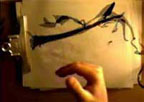
Drawn to Perform
Drawn--by Zachary Lieberman and Pardon Kimura--is a concert-performance in which live painting is augmented in real time, the painted forms appear to come to life. The performance explores the musicality of drawing by turning brushstrokes of ink into complex and energetic life forms.
A table on stage holds the paper, ink and brushes. A camera above the table captures the drawing and the image is then projected for the audience to observe. However, the projected image is not entirely unadulterated - a software analyses the video image and augments the image with synthetic graphics. The result is a hybrid video signal, combining both factual and fictional pixels. The hand-drawn gestures appear to have a mind of their own: they can be played with as though they weren’t actually painted on paper, and the user can push them around the page using only his hands.
One of the main concerns of the developers was to create a visual "instrument" that could be used in collaboration together with musicians. In this nuanced relationship between animated drawing and sound, the sketches, doodles, and gestures mix together with the sonic environment in order to create a dense and lively musical form. The videos on the website are really impressive. [blogged by Regine on we-make-money-not]
Posted by jo at 07:00 AM | Comments (0)
April 28, 2005
The Passion of Henry
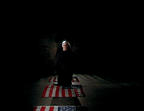
"Power is the Ultimate Aphrodisiac" - Henry Kissinger
Jerry Snell proudly presents his new collective creation: The Passion of Henry, an industrial performance event denouncing over 40 years of international terror. The result of a research and creation residency at SAT, The Passion of Henry will be presented April 28 & 30 at 8pm. Artist, director and composer for dance, theatre, cinema and circus, Jerry Snell’s new collective creation fuses all these elements, collaborating not only with artists from Canada but also from China, Vietnam, Japan, Netherlands, Belgium and Chile. The Passion of Henry excavates the mind of Henry Kissinger, mythical icon of international hypocrisy of the American political society.
Integrating 5 video screens and mixed with archive materials, live music and performed on stage by actor Pascal Dabe from Belgium, The Passion of Henry presents a sarcastic and cruel reflection of our contemporary world. Henry Kissinger: Nobel Peace Prize recipient, mass murderer, anti-Christ or playboy?
Participants include: Pascal Dabe (actor), Michel F. Côté (composer), Lorne Brass, Thien Vu Dang, Martin Laporte, Yasuko Tadokoro (film and video), Pascale Montpetit, Kurt Chen, Goos Meeuwsen and Alacanté de Chilé (virtual performance),
Posted by jo at 07:47 PM | Comments (0)
March 30, 2005
Phonic Frequencies:
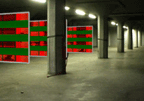
Shaping Networked Realities
ABSTRACT: The paper introduces a networked multi-user installation and interactive mixed reality environment that combines the fields of interactive art, telecommunication and streaming technologies. Phonic Frequencies is an audiovisual data space whose appearance can be altered via networked communication devices. Visitors are active agents and participate in shaping spaces as they control audiovisual data with their telephones.
Linking the physical space to the digital network space, Phonic Frequencies opens a hybrid reality for distributed sound exchange and visual communication, blurring the boundaries between verbal communication and digital information. The work attempts to break the conventional communication cycle of bidirectional dialogue and to consider the meaning of in- and output from a different perspective." From Phonic Frequencies: Shaping Networked Realities by Tamas Szakal, Christoph Groenegress, Wolfgang Strauss, Predrag Peranovic (c) 2003
Posted by jo at 07:40 AM | Comments (0)
March 29, 2005
Liquid Gold
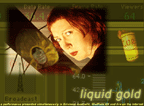
An Artery of Liveness
Liquid Gold--by the Transmute Collective--was a live performance event that spanned the globe, using the Internet to link several sites and audiences into one entire 'net-worked' performance. It consisted of several intensely quirky performances, accurately coordinated across multiple time zones. Liquid Gold demonstrated a new kind of net-work, using the Internet as the artery that spreads a new performance experience of networked 'liveness' across the world.
Liquid Gold brought together filmmakers, artists, musicians, network specialists and writers to make a new work of live art both in real space and throughout the global electro-o-sphere. It employed a custom built chat server ('idea animator'), running in the physical live venues and on all Internet located audience's browsers. This allowed writers in both Australia and England to describe what they saw locally in their own performance venue - putting back some of the 'liveness' lost through the lo-fi images and sounds the web currently allows.
Liquid Gold used its novel approaches to present one woman's journey of reconciliation - a trip that will allow her to reconcile the ghosts of her chequered past and travel towards the new futures that her vivid imagination are now making possible.
Performer Lisa O’ Neill, in the persona of adventurer and strong woman 'Ling Change', was filmed live on video as she traveled throughout the stunning internal landscapes of the Brisbane Powerhouse Centre for the Live Arts, an old industrial site now converted into a major arts complex.
Her journey proceeded from the depths of the 'turbine room' and finished in the dramatically patterned glass of the main atrium.
Video imagery of this journey was streamed live across the Internet to Site Gallery, Sheffield, England. There an assembled audience watched as Keith Armstrong directed the work, mixing the Australian streamed vision with further performance vision and audio, unfolding a bizarre narrative which developed in real time between the live and pre-edited footage.
The two steams of video (From Brisbane, Australia and Sheffield, England) were projected upon adjacent screens in both the physical spaces, with the audiences 'editing' their own performance from these two images.
The work was webcast live for online audiences and incorporated a custom interactive chat facility, called an 'idea animator'.
LIVE WEB CAST: The live webcast showed prerecorded footage of the main character ('Ling Change', performed by Lisa O'Neill) traveling through animated landscapes mixed live with the images from the live performance in Brisbane. This mix was undertaken by the show's artistic director Keith Armstrong in Sheffield. All original sound for the show was composed by Guy Webster.
These dual narratives showed Ling's journeys in some past time, and now in the present, as she moved through strange industrial landscapes. (filmed live in the striking industrial interiors of the Brisbane Powerhouse). Hence audiences were asked to construct the narrative online, as the characters' actions shifted from virtual to actual architectures"
Online viewers with high specification machines and plenty of bandwidth could enjoy the luxury of participating in both the video stream and interactive chat dialogue, whilst also surfing background information. The video stream was kept as minimal as possible to avoid excluding other users on slower computer systems.
IDEA ANIMATOR: The 'liveness' of this work, particularly for the web-based audiences, was enhanced by a idea/animator/custom chat server which allowed two writers, situated both in Brisbane and Sheffield, to comment in real time upon their impressions of the performance as they saw it evolving in their respective venue.
The writers at each physical venue referenced performers, imagery, audience, environment and global communication. Remote viewers, and those present at each venue, watched the writers words appear in real time on their screens alongside the performance imagery. Throughout this poetic dialogue key words/ideas were extracted from each writer's texts and became animated upon a large projection screen.
This idea animator software, designed and constructed by Gavin Sade, allowed keywords and ideas to float onto the screen and animate.
When online users logged in their presence was seen by all those also logged via the Internet along with those audiences present at the two live venues. Online users could participate by selecting words already animating on the screen by clicking upon them... this caused the ideas/words to regroup and grow according to the online audience interactions. [Related]
Posted by jo at 12:17 PM | Comments (0)
March 28, 2005
teletaxi
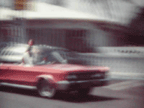
Car #235
Year Zero One is pleased to present teletaxi, a site-specific media art exhibition in a taxicab. The taxi is outfitted with an interactive touch screen that displays video, animation, audio, and information triggered by an onboard GPS (Global Positioning System) receiver which allows the displayed artwork to change depending on where the taxi is in the city. With the combination of the media/gps technology, the mobile environment and the passenger/audience inside the cab. The eleven artists in teletaxi are offered a unique set of possibilities for showing their work - both technically and thematically.
teletaxi will expose interactive media art to a normally passive audience, by presenting works that explore notions of intimacy, mapping, subterranean space, simulated cities, information architecture, data-visualisation, public interventions, surveillance and psychogeography.
Presented by Year Zero One, in Montreal, from March 21 to June, 2005. As part of the DIS/LOCATION: projet d'articulation urbaine programming of DARE-DARE Centre de diffusion d'art multidisciplinaire de Montréal.
Michael Alstad; Mario Côté; Milutin Gubash; David Jhave Johnston; Patric Lacasse; Virginie Laganière; Valérie Lamontagne; Éric Raymond; Doug Scholes
Camille Turner; Myriam Yates.
Opening Friday April first, from 5PM to 9PM, at Square Viger.
Join us at Dare Dare (Square Viger) for a 'fare free' ride in the teletaxi to navigate some of the neighbourhoods and Montreal sites explored by Year Zero One artists and guests.
To reach Taxi Co-op of Montréal, call at (514) 725.9885 and ask for car #235; For more information, contact Dare Dare at (514) 878.1088
[Related]
Posted by jo at 12:54 PM | Comments (0)
March 09, 2005
Augmenting Expectation in Playful Arena Performances with Ubiquitous Intimate Technologies

The Performance Triad Model
"Use of modern technologies in performance is not new. Laurie Anderson (Anderson), Kraftwerk (Kraftwerk), and Stelarc (Stelarc) have all paved the way for recent innovations in the cross fertilisation between performance and technology including body-worn sensors, mobile and wearable computing, directional audio and interactive projections. These innovative technologies allow us to integrate the corporeality of live performance with both remote and mediated presences. As we become more familiar with these technologies, and as these technologies become both more affording and more affordable, their use is becoming more diverse and widespread. The growth in this field has gone hand in hand with the increasing number of performances that seek to investigate and redefine notions of performance and performativity as essential human activity that can occur beyond the tightly bound world of the theatre building." From Augmenting Expectation in Playful Arena Performances with Ubiquitous Intimate Technologies by Alice Bayliss, Jennifer G. Sheridan & Simon Lock
Posted by jo at 11:54 AM | Comments (0)
March 08, 2005
Performance Paradigm

New Online Journal
NOTE: you'll need to register to gain access to this journal.
"For the last decade or more media technologies and live performance have become increasingly interrelated and interdependent. Debates about this critical nexus have resulted in a diversity of views. While there is broad acknowledgement that this interpenetration has resulted in widespread innovation, there is also evidence of a certain anxiety about the status of live performance. Questions have often focused on the resultant status of the live body, the changing nature of the performance experience and of technology itself. The experience of the ‘live’ based on notions of presence is often promised and reinforced by the effect of a mass audience, but it is increasingly susceptible to digital subversion by the temporal disintegration and restructuring of audio and visual data." From the Introduction by Edward Scheer and Peter Eckersall to the inaugural issue of Performance Paradigm. [via Christy Dena's post Scholar has moved into Jupiter Green]
Posted by jo at 08:20 AM | Comments (0)
dotdotdot
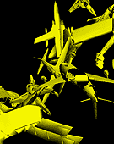
Glimpses of Unseen Places
A landscape from beyond the edges of the browser window that gives glimpses of unseen places. dotdotdot is constructed using several different motion capture systems and improvised performances creating abstract digital portraits. These animated avatars move and react to players inputs within an online virtual environment.
"dotdotdot provides a good example of the ways in which practitioners using old media and new media can collaborate to produce an ongoing body of work challenging the canons from which each component of the work orginates. Using motion capture, web tools, animation, games engines, sound and movement dotdotdot presents a series of animated interactive vignettes. These can be manipulated in terms of speed, sound, rotation and movement so that the basis of the range of visuals on offer stays the same but also so that the viewer/player can change them to accommodate their own preferences. [via Rhizome]
Each work has an Igloo signature but it allows the viewer to manipulate, play and be creative - after years of artists striving for truly interactive work, dotdotdot knowingly works with the limitations of interactivity in order to give the piece a characteristic style.
The viewer/player is presented with a range of choices involving genre orientated radio stations (you can choose drum & bass through to chart music) and a variety of visuals such as red, dot, bendy and plane. All these permutations and combinations together with the ability to interact with the animated figures in terms of speed and rotation challenge the viewer to think about the visual and audio styles in relation to their own experience of video, sound, animation and movement drawn from a variety of sources in day to day culture.
The project, which has been ongoing, is the product of Ruth Gibson, a dancer who is specifically looking at development of movement in the context of motion capture, and a programmer Bruno Martelli, who is interested in pushing the limits of technology in real physical contexts. The artists draw in expertise and collaborators as and when they need and the quality of the work is enhanced with every reworking. Their animations reflect these concerns with their 3D quality combined with recognisability of the human form in spite of the abstractness of the animated shape." Helen Sloan, Director - SCAN
Posted by jo at 07:38 AM | Comments (0)
February 28, 2005
Adaptable Girl Performance Collective

global_interface workshop series
New Media comes to University of California at Riverside in a series of workshops on new media practice.
They purpose that "this critical collaboration across the disciplines of the academy mirrors the global interface itself. Mark Poster outlines how digital technologies like the Internet can traverse the limits of traditional communication models, such as print and broadcast, as follows:
1) Enabling many-to-many communications;
2) Enabling simultaneous reception, alteration, redistribution of cultural objects;
3) Dislocating communicative action from the posts of the nation;
4) Providing instantaneous global contact;
5) Inserting the modern/late modern subject into a networked information machine apparatus.
Humanity is no longer constituted by clearly bounded subjects, but instead begins to function more like a network, in which individuals act "as a point in a circuit." The global interface serves as the site where this transformation occurs."
Singing G4s Song: Digital-on-Human Performance Practice in Late Capitalism: Monday, February 28, 2005, 12:00 p.m. - 2:00 p.m.
Location: Arts Building 166 (Performance Lab)UC Riverside.
Description: The merging of virtual and real audio spaces through the
proliferation of digital tools has dramatically impacted praxis for a number
of artistic genres. This performance/lecture brings together musicians and
dancers in an improvisational installation that explores the extension of
live performance through digital processing. Featuring music, dance and
video, the work will also deploy a number of digital performers, including
programmed audio improvisers (in max), digital cameras, even an iPod. The
performers will discuss the installation and the broader impact that digital
technologies have had on their own artistic practice.
Adaptable Girl Performers:
Ramie Becker is a Ph.D student in Dance History and Theory.
Renee Coulombe is an Assistant Professor of Music Theory and Composition.
Maria de los Angeles "Cuca" Esteves is first year MFA student in Creative
writing and Writing for the Performing Arts.
Isabel Valverde, a choreographer/performer and researcher, recently
completed her Ph.D. in Dance History and Theory at UC Riverside, and is
presently pursuing a postdoctoral program at UC Irvine.
Elizabeth Venable is a Ph.D. student in the Dance Department.
Sponsor: Mellon Workshop
Contact: global_interface@hotmail.com
Join the Global Interface blog:
http://globalinterface.blogspot.com
Posted by michelle at 04:18 AM | Comments (0)
February 25, 2005
Multimedia Performance after Dumb Type
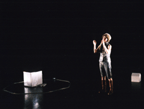
New Movement Emerges
In 90's, Dumb Type established multimedia performance in Japan. Teiji Furuhashi and Dumb Type in early 90's were legend of Japanese Multi Media Performance and Media Art for their works, for example, "S/N"(Dumb Type) and "Lovers"(by Teiji Furuhashi).
In this season, I have a presentiment of stages after Dumb Type. There was a competition called Yokohama Solo X Duo Compe'tion + R at the end of January. This competition has a relation with a French famous competition called "Recontres Choreographique Internationales de Seine-Saint-Dennis." [posted by Yukihiko YOSHIDA]
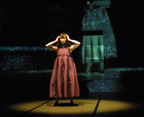
In this competiton, there are many multimedia Performance and performance with robotics. Thee winner of this competition, Mariko Okamoto, used interesting robotics in her piece. A young Japanese girl sits down on a small refrigerator and moves little by little. Small robotics move beside her on the stage. One of the dancers, such as Mariko Kon'no, whom I introduced in this blog before, danced sharply with video art by Haruo Higuma, who is a well known artist in this
field.
A very successful work is "Alicetopia" by Satoko Yahagi in early February. Yahagi got an idea from a picture book "Alicetopia." Yahagi's dance and choreography are under the influence of Surrealism. The aestheics of Surrealism arranged the visual effect of this work. I have a presentiment of a new movement after Dumb Type after seeing this work.--Yukihiko YOSHIDA
Photo Credits:
French Embassy Prize for Young Choreographers Mariko Okamoto, "sputonik*gilu" Photo:Yoi'chi Tsukada
Satoko Yahagi,"Alicetopia", Photo: Kei Yasuda, Dance Cafe
Posted by jo at 09:57 AM | Comments (0)
February 23, 2005
Seine hohle Form

Collaborating on Interactive Performance Works
Abstract: Composers and choreographers face unique and largely unexplored problems as they collaborate on interactive performance works. Not the least of these problems is settling on schemes for mapping the various parameters of human movement to those possible in the world of sound. The authors' collaborative piece, Seine hohle Form, is used as a case study in the development of effective mapping strategies, focusing on dance gesture to real-time music synthesis. Perceptual correlation of these mapping strategies is stressed, albeit through varying levels of abstraction. Read Seine hohle Form: Artistic Collaboration in an Interactive Dance and Music Performance Environment by Joseph Butch Rovan, Robert Wechsler and Frieder Weiß, Crossings: Electronic Journal of Art and Technology, Issue 1.2
Posted by jo at 03:38 PM | Comments (0)
February 22, 2005
Experiments in Art and Technology (E.A.T.)
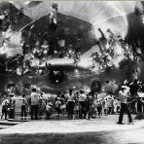
One Forgotten History of Transdisciplinarity
"At a recent meeting of PLAN I mentioned E.A.T. and drew a number of blank looks-so here is one forgotten history of transdisciplinarity and early locative projects:
Experiments in Art and Technology was founded in 1966 by engineers Billy Klüver and Fred Waldhauer and artists Robert Rauschenberg and Robert Whitman. The non-profit organization developed from the experience of 9 Evenings: Theatre and Engineering. This event, which was held in October 1966 at the 69th Regiment Armory in New York City (U.S.), brought together 40 engineers and 10 contemporary artists who worked together on performances that incorporated new technology. It became clear that achieving ongoing artist-engineer relationships would require a concerted effort to develop the necessary physical and social conditions. E.A.T. saw itself as a catalyst for stimulating the involvement of industry and technology with the arts. [blogged by Martin Rieser on Mobile Audience]
The organization worked to forge effective collaborations between artists and engineers through industrial cooperation and sponsorship. Membership was opened to all artists and engineers, and an office set up in a loft at 9 East 16th Street in New York.
Artists and the art community responded enthusiastically to E.A.T. By 1969, given early efforts to attract engineers, the group had over 2,000 artist members as well as 2,000 engineer members willing to work with artists."
Related: Whitman's Phones; PLAN Notes; and On Locative Media's European Reception.
Posted by jo at 02:04 PM | Comments (0)
February 14, 2005
Troika Ranch

Three by Troika
In Plane (1994) was a duet for a dancer and her video image representation. The dance used the MidiDancer system to allow the performer to control the generation of music, the recall of video images, the theatrical lighting and a the movements of a robotically controlled video projector.
The Electronic Disturbance (1996): Searching for the corporeal within the virtual: a "tri-coastal" dance theater performance. Inspired by the book of the same name by The Critical Art Ensemble, The Electronic Disturbance shows the human body in flux: a body whose contact with other bodies comes more and more often not physically, but electronically. The piece explores the liberating aspects of this "electronic" body, like freedom from time or gravity, as well as the more sinister implications of a body that might be easily manipulated by external forces.
Surfacing (2004) combines dance and media to explore how tiny apocalypses and the grandly commonplace create imaginary surfaces through which we may either emerge or remain held captive. Troika Ranch's Artistic Directors, choreographer Dawn Stoppiello and composer/media artist Mark Coniglio, have created a world where real-time movement is captured by onstage cameras and subsequently trapped inside the surface of the video screen. The interplay of the real and the virtual asks the question, are you on the inside or the outside, and do you have the courage to break through?
Posted by jo at 02:56 PM | Comments (0)
The Resonant Image

Graphic Scores for Performance
Graphic scores are images created to convey instructions for the performance of sound or music without the inclusion of standard musical notation. The Resonant Image, a new two-stage exhibition in the Stasis_Space gallery, will explore the creation and interpretation of graphic scores by contemporary artists. In Stage 01 of the exhibition, a series of new graphic scores by a variety of artists will be displayed for a four month period. During those four months, another set of artists will be asked to create sonic interpretations of these scores. Stage 02 of the exhibition will present the best of these performances as downloadable mp3s.
Posted by jo at 11:48 AM | Comments (0)
February 11, 2005
syn chron

Architectural Body as Interface: Space.Light.Sound.
Visual artist and musician Carsten Nicolai has conceived of a mobile space that serves as acoustic body, resonating space and projection surface all at once - a crystalline architectural body whose translucent skin is the vehicle for both acoustic and optical events. Electronic music composed by Nicolai generates modulations in laser-projected light. The composition, designed to run for the duration of the installation, is planned for daytime and nighttime conditions as well as potential live presentations. The architectural body is a sound and light space that visitors can enter into, or they can also perceive it from the outside, even at a distance.
This mobile architecture is a prototype that the artist has developed together with architects Finn Geipel and Giulia Andi, LIN as well as with engineer Werner Sobek. Along with the latest in laser technology, Nicolai experiments with the special acoustic conditions of the crystalline space.
Carsten Nicolai, born 1965 in Chemnitz, has developed a special approach to the connection between art and music, between visual and acoustic perception, in his works since the mid-1990s. His stance as artist and musician may be compared with that of a researcher. In constantly new experimental arrangements, Nicolai seeks to overcome separations between human sensory experiences and to transform natural scientific phenomena, such as sound and light frequencies, into events perceptible for the eyes and ears. "syn chron" represents the largest project to date in Nicolai's endeavor to create a symbiosis between architecture, light and sound.
The "syn chron" project takes place as part of the "Musical Works by Visual Artists" performance series, which Freunde Guter Musik Berlin has realized in collaboration with the Nationalgalerie Berlin since 1999 and, since 2002, with MaerzMusik festival of the Berliner Festspiele. Within this series, Carsten Nicolai's work occupies a special position. It can be thought of as an experiment in which the artist is active not only at the border zones of art and music, but also at their interface with science.
Posted by jo at 05:59 PM | Comments (0)
February 10, 2005
Dziga Vertov Performance Group
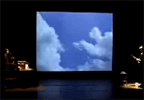
Performance Hybrids
Founded by artist/director Douglas Rosenberg in 1991, Dziga Vertov Performance Group's purpose is to create works bridging numerous disciplines including dance, performance and the visual and media arts. It takes its name from the Russian filmmaker of the early 1900's. DVPG's fundamental mission is to create new and challenging works of art based in the language of performance, dance and media that often combines voice, text, video and projected images. The work of DVPG is concerned with both content and form. The purpose of the work is to engage the audience, other artists and community groups in a dialogue that reaches beyond the usual performer/spectator relationship. In order to do this, we have set out to create a hybrid form of performance that is intended to both engage and challenge, using concepts and images that speak to contemporary and historical issues of human existence.
One of DVPG's many projects is ADaPT, an interdisciplinary association of artists, technologists and scholars from five educational institutions dedicated to research and critical dialogue on performance and media in telematic space.
ADaPT comprises five dance studios in five universities in the USA.:
1. Arizona State University
2. Ohio State University
3. University of California-Irvine
4. University of Utah
5. University of Wisconsin
In Wisconsin, the ADaPT team consists of Douglas Rosenberg (principal investigator), Chris Dowling (telematic technologist) and Jeffrey Gray Miller (technical director).
The objectives of ADaPT are to:
* create a site for telematic collaborative inquiry for the purpose of developing new models of practice and training techniques for the creation of networked dance and performance
* explore embodiment and somatic intelligence through reconceptualization of spirit, body and machine in Internet 2 culture- develop a shared mediated space for investigating performance and creative collaboration through a distributed environment across time zones
* situate research within a larger cultural and political context that acknowledges how mediated performances both frame and are framed by issues such identity, privilege, and access.
Posted by jo at 11:48 AM | Comments (0)
Performance and Live Art

Seeking a New Vocabulary and Practice
"Live Art as a practice draws freely on the widest range of references, influences and disciplines and is therefore hybrid or interdisciplinary by nature: it challenges both single art-form practice and received ways of seeing, thinking and doing. Embracing the broadest range of innovative interdisciplinary activities (deriving from theatre, dance, music, fine art, cinema and video, new technologies and popular performance arts) it characteristically finds alternatives to the assumptions of any one of these disciplines, a process that forms its over-arching research imperative. Given its multi-faceted origins its performances only rarely derive from prepared text but more frequently finds inspiration through close observation, new technologies, social intervention, music, visual image, politics and by challenging alternatives including mixed and colliding media, site specific work and time-based events as well as 'actor/role' created performance seeking to offer a new vocabulary and practice to the performing arts."
Performance & Live Art Group Members at The Nottingham Trent University: Frank Abbott, Dr Johannes Birringer, Peter Bowcott, Andrew Brown, Matt Hawthorn, Dr Adrian Heathfield, Richard House, Dr Sophia Lycouris, Nikki Milican, Thomas Mulready, Professor Barry Smith, Stelarc.
Posted by jo at 08:58 AM | Comments (0)
February 09, 2005
Cyburbia Productions

Live Movies
Cyburbia Productions, a multimedia performance studio, focuses on the collaborative creation of "live movies," syntheses of cinema, theater and music. The company’s work employs digital projection and sound technologies, and filmic narrative techniques, to construct moving stage pictures and sonic theater, in which live actors interact with animated performers, and emerge from or vanish into projected environments, settings and dreamscapes.
Projects include: SILENCE & DARKNESS is a live movie for the cell phone age by Kirby Malone, and passages from Jean Baudrillard, Guy Debord, and Heiner Müller. See list of productions here.
Posted by jo at 11:54 AM | Comments (0)
February 04, 2005
Distributed Improvisation

Distributed Improv~Programmed by n0media
Live improvisation connecting sonic artists, musicians and visual artists sited at University of East Anglia (Norwich, UK), International Centre for Music Studies (Newcastle, UK), Kingston (Canada) & Dublin Institute of Technology (Dublin, Ireland) in a series of realtime audio/ visual networked performances. The event can be accessed live online between 8pm & 9.30pm GMT. Performers include; Phil Archer, John Ayers, Andre Bosman, John Bowers, Laura Cannell, Nick Melia, Matt Rogalsky, Alex Sanders, Will Scrimshaw, Tom Simmons, Shigeto Wada and Liam Wells.
The event features four improvisations, each utilising specially created local or remote networks, sharing realtime audio/visual & performance data between performers in spatially remote locations. For more information go to >>
Posted by jo at 09:43 AM | Comments (0)
January 11, 2005
Code Zebra
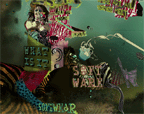
New Artistic Practices Meets Performance Art, Art and Science
Code Zebra is a highly interactive interdisciplinary, performance and software system where art meets science. The performances occur at sites around the world and on the web. CZ induces dialogues and debates between science (with an interest in computer and biological science) and arts (including visual art, design, fashion, architecture). Code Zebra consists of fictional flirtation sessions between an artist and a scientist, actual conversations and debates between the arts and sciences. Code Zebra is built as a scaleable performance series that allow venues to plug and play.
Elements of the development of Code Zebra will be captured in video and Internet streams and form part of a significant archive that will be used in performing the work. Users on the site will experience live events via streamed audio, and at times video. Live events will be publicized through the web site. The project draws from performance theory (art, literature, sociology), discourse theory and grammatology, cross-disciplinary research methods, visualization theory and computer science practice, simulation, new media analysis.
The metaphor of "zebra" is at the core of the project because zebra's stripes are reaction/diffusion patterns; a provocative but resolution based way of describing dialogue. Evolutionary theory uses zebras as a case study, and reaction/diffusion has been at the core of this emerging performance series and at the heart of the operations of computer code. Zebras are the unexpected evolutionary protocol. They stand out in a crowd, but induce nausea in lions, their former predators. Above all zebras survive by moving in camouflaged herds.
Performances will take place in various real and simulated locations. The software of Code Zebra also combines panel discussions and debates, live and on-line, chat, simulated conversations and patterns and visualizations of chat or performance art metaphors using software and fictional performances.
CodeZebra OS (Orifice System) Software
In November and December of 2000, a group of leading artist/software developers, streamed media artists, discourse theorists, chat analysts, computer scientists and programmers gathered in San Francisco, led by Sara Diamond and hosted by the ArtsAlliance. Together, they modeled Code Zebra, a software that will analyze and allow people to author on-line chat, video streams, producing visual patterns that allow users to better understand and symbolize their own position within discussions. The software deploys reaction/diffusion patterns from nature, but permits individuals or groups to have a personalized pattern at any point in time. The design retreat includes some of theworld`s leading thinkers in Internet dialogue analysis, streamed media, and pattern creation. It links to the larger Code Zebra project. The software is capable of analyzing all forms of chat, but will be focused on debates and discussions in art and science as a development phase.
The software provides users with the ability to use visualization patterns to locate themselves within an Internet discussion, review their histories of dialogue, enter a deeply moderated or anarchic space that is designated by topic and/or by mode of chat and feel physically located in this space; monitor other chats simultaneously, use physical links to relate ideas; build a personal pattern icon and a personal tale of chats and Internet dialogues that unfolds as a visually beautiful, navigable, shareable 3D and sound movie.
Fear and self-preservation need to be confronted and transcended in the process of enacting cross-disciplinary exchange. This will be so in the performances and is already a part of the software design process. The performances and the software translate constantly, between the semantic meanings of concepts, people's relationships, into visualization new levels of understanding. The software enables agency (you choose topics and people), but its intelligence constantly suggests new possibilities of idea, related concepts and people for you to connect to. While appearing light, beautiful and playful, this project is in fact serious and viral.
The software development workshop may be a good example of the lock-up technique (referred to later), as the artist placed fifteen top-end researchers and coders in a room with her and several other artists. They came up with the chat visualization software that was a complex melding of computational linguistics, social instincts, and simulations of animal and human physical characteristics and evolutionary logic. First and foremost, they combined an emotional system with the anarchic or unconscious dynamics of Internet interaction. Code Zebra is all about process, allowing a series of lenses on the process of dialogue and creativity. While driven by the vision of one artist, it is highly collaborative and hence high risk, requiring the cooperation of different talents and disciplines for its success.
The user enters each chat or dialogue session by dwelling on the surface of the site and then diving into a familiar or seductive pattern. Once inthe pattern one moves through its moving mass and can stay at any point for dialogue. The software monitors styles of discussion through pattern analysis and can impose patterns on certain kinds of dialogues should these go astray or at least suggest these. Patterns can be used to analyses what people are talking to each other, about what, but most profoundly how they are talking. Character scripts based on the reaction diffusion character team (Code Zebra, Os Zealot, etc.) will arrive in at least text, if not visual form, to moderate discussions or suggest changes of mode (e.g. you have a limit of ten words posting for e.g. and it looks like playful leopard spots). This process of swimming through the topography of the site is called orifice systems (OS).
Each user creates their icon on the site, a moniker for HOW they interact. Each chat sessions produces a pattern that they can capture at any point in time. It forms a ring, or layer attached to their icon. Over time, these layers build to create a personal tale. These are three-dimensional forms that the user can enter, fly through, fly around, pull out layersof for reconsideration. Although highly visual (and eventually sonic), drilling down into these results in precise data base information about whoone has spoken to, about what and in what style (aggressive debate, playful banter, formal panel discussion) at what time. The forms operate as 3D movies, luscious and beckoning. The icons sit on the surface of the site, but at any time, users can share these or revisit these alone or accompanied.
Posted by jo at 06:55 PM | Comments (0)
January 10, 2005
real-time film
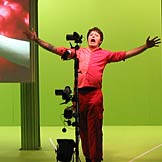
resynthesis of (per)form(ance)
Caden Manson's Big Art Group developed "Real-Time Film" as a conceptual model conflating performance, television, and movies. Using live performance and video, it plays cinematic composition and controlled perspective against the 'verity' of TV broadcast and the immediacy of live performance. It is a live movie that examines the use of image in entertainment, how we experience the image versus its manufacture, the split between surface and interior, and the different layers of truth.
In "Real Time Film" the actors work in front of three stationary cameras, and what those cameras see is projected on a three-segment shoulder-high screen running the length of the stage between the audience and the actors; the performers' heads, shoulders, feet and the projections of their actions are all that's visible. Watching the screen, the audience sees a movie. Watching the performers, the audience sees the making of the movie. Bodies morph into one another and limbs attach and reattach to different characters. It enables an Asian woman to play a white woman with a black man’s arm. The form short-circuits the audience’s ability to discern gender, race, and sexuality; dissecting the semantics of everyday visual communication; and becoming a new way of relating the fluidity and manufacture of identity.
The technical analysis and resynthesis of the form carries through to the infrastructure of the text, the reestablishment of character, and the nature in which expectations of drama are met and deflected. Language is made transparent and meaningless and simultaneously overloaded with possible meanings, and traditional methods of establishing and acting character are exploded and then recombined in the attempt to generate new modes of identity and identification. Narrative plays with the idea of development and frustration, intentionally exposing circular patterns and the inconsistency of structure while using conflict/resolution to push forward.
Posted by michelle at 07:10 PM | Comments (0)
January 05, 2005
Fools Paradise

An Island Floating in a Sea of Stars
Fools Paradise is a VR installation and performance created by artist Paul Hertz and composer Stephen Dembski, based on the "Proverbs of Hell" by visionary poet and artist William Blake. It is also an intermedia work, where different sensory modalities share underlying structures. The artists developed musical structure and visual structure in collaboration. Dembski scored forty-eight proverbs for soprano, cello, and flute. Hertz created a landscape of colorful gems embedded in a tableland on an island floating in a sea of stars. Seen from afar, the island resembles a tongue, the tableland a book. With a clamor of children's voices, a stream of words runs down the central crease of the tableland and cascades over a cliff onto the tip of the tongue and into the sea. The VR performer visits each gem, triggering a song and a mask as she goes. The current mask floats in front of her, and also replaces the gem, until the island is filled with masks, all facing the VR performer. [via Rhizome]
Paul Hertz (paul-hertz @ northwestern.edu) makes art in both digital and traditional media. He has worked in various positions at Northwestern University. In 2003—04 he was Co-Director of the Center for Art and Technology. As a Visiting Artist in 2001 and 2002, he taught the university’s first course in virtual reality for artists. He also developed and taught a course in Interactive Multimedia from 1999–2003. A grant from Northwestern’s Center for Interdisciplinary Research in the Arts helped him to develop VR performance artworks and software. With the support of the journal Leonardo, Hertz is curating an exhibition of pioneering computer graphics for the Block Museum at Northwestern University, for April 2006. He supports his art habit with a day job designing networked multimedia applications for the Collaboratory Project at Northwestern University, where he is currently working with a terabyte astronomical database in a project funded by the National Science Foundation.
Hertz spent many years in Spain producing paintings, music, and intermedia performance works. He earned an MFA at the School of the Art Institute of Chicago, where he began to create digital intermedia art as a fellow of the Center for Advanced Studies in Art and Technology. See http://www.northwestern.edu/people/paul-hertz for links to Hertz's portfolio and other materials.
Posted by jo at 09:02 AM | Comments (0)
December 27, 2004
netzwissenschaft
![]()
Emerging Infrastructures of All (Inter)net Research
Dr. Reinhold Grether's network research | netzwissenschaft site maps the "emerging infrastructures of all (inter)net research endeavours. net.science as an anthropology of connectivity is trying to overcome the constraints of specialist method transfers on net matters. the protuberance of technical networks necessitates a professionalization of human net knowledge. neither the isolation of concepts as in basic research nor the encapsulation of processes as in applied sciences will ever be able to adequately describe the complex autopoiesis of networks. net.science is undoubtedly developing into a scienza nuova of its own right."
Check out his Mobile Art and Virtual Performance research areas.
Posted by jo at 04:45 PM | Comments (0)
December 10, 2004
transmediale.05: BASICS

Multi-Media Performance Program
transmediale.05: BASICS Berlin, February 4 - 8, 2005, Haus der Kulturen der Welt: 1. Performances 2. skoltz_kolgen (ca): 'FLUUX:/TERMINAL' 3. Usman Haque (uk): 'Sky Ear' 4. Yannis Kyriakides, HC Gilje (nl/de); 'Lab Fly Dreams' 5. Christian Ziegler (de): 'turned' 6. Umatic (nl): 'ResonanCITY' 7. Venzha & the House of Natural Fiber (idn): 'CAUS#3' (citizen against UFO secrecy #3)
1. Performances: The international media art festival transmediale.05 puts a new focus on multi-media performances. Artists' collaborations using real-time video and combining it with dance, electronic or unplugged music will perform at the grand opening and the consecutive nights at Berlin's Haus der Kulturen der Welt (HKW). Related performances within the series 'Live Cinema' can also be experienced at the club transmediale (Maria am Ostbahnhof).
2. skoltz_kolgen (ca): 'FLUUX:/TERMINAL'
'FLUUX:/TERMINAL' is a bipolar performance that skoltz_kolgen have named 'Diptyque Retinal'. As in all of their work, here their research has established a point of contact between sound and image. But 'FLUUX:/TERMINAL' pushes the dialogue between these two elements one step further: their performance creates a dramatic trajectory, fuelled by the panoramic tensions (left/right) between hearing and seeing.
Opening: Thu 3.2. 19 hrs, and Fri 4.2. 20.30 hrs (HKW)
3. Usman Haque (uk): 'Sky Ear'
Helium filled balloons with built-in, ultra-bright LEDs form a cloud which moves around in the sky at 100m. This balloon-formation reacts to the changing electro-magnetic fields that are created by distant storms, police and traffic radio waves or television transmittals, which change the colour and colour-intensity of the balloons. Through countless variations of colour, 'Sky Ear' demonstrates the invisible topography of the electro-magnetic field which permanently surrounds us. The glowing cloud not only shows the extent to which natural electromagnetism penetrates our environment, but demands that the audience interact with the electromagnetic fields. Mobile telephones are embedded in the balloons. By telephoning into the 'Sky Ear' the audience is able to see how the local magnetic field is changed by telephone activity. Thus, our daily interaction with electromagnetic fields is rendered visible. [Related 1, 2]
Opening, Thu 3.2. 21 hrs (HKW)
4. Yannis Kyriakides (nl), HC Gilje (no/de), Claire Edwardes (au/nl); 'Lab Fly Dreams'
Lab Fly Dreams (or 'Dreams of a Jet-Lagged Fruit Fly') is a collaboration of composer Yannis Kyriakides and visual artist HC Gilje. It is a homage to the suffering fly, whose sleep patterns are studied by geneticists the world over in order to understand the workings of our own circadian rhythms. They are subjected to all manner of disorientating sleep environments, such as keeping them awake by tapping whenever the insects stays still for more than a minute. What do these flies dream of in their plastic containers? Originally written as a BBC commission for the Icebreaker Ensemble (uk) and Orkest de Volharding (nl), this reduced version turns the piece inside out and is scored for solo percussion and 8 channel electronics. The video is performed live, mainly based on found footage from lab fly research, creating a fruit-fly version of the Ikaros myth.
Sat 5.2. 21 hrs (HKW)
5. Christian Ziegler (de): 'turned'
The multimedia dance performance is a synaesthetic bonding of the elements of dance, painting, visual art, and music by Christian Ziegler in collaboration with Sean Reed and DJ Florian Meyer. The dancing body (of Kazue Ikeda) provides visual material which is sampled in real-time. Visual traces of these movements are poetically re-designed or disturbingly deconstructed. Therefore, an initial glance at the losses that accompany each replacement and each dematerialization is provided. [Related]
Sun 6.2. 21 hrs (HKW)
6. Umatic (nl): 'ResonanCITY'
Many sounds and images in our everyday lives slip past our notice simply because they are too small, or because we lack the proper receivers to pick them up. 'ResonanCITY' is an ongoing project to gather these microscopic sounds from various cities, and to amplify and transform them. The performance builds a new city of sound and visuals inside the old one; it inspires the curiosity to explore one's own environment.
Sat 5.2. 21 hrs (HKW)
7. Venzha & the House of Natural Fiber (idn): 'CAUS#3' (citizen against UFO secrecy #3)
Based in Yogjakarta (Indonesia), Venzha and the House of Natural Fiber create experimental interdisciplinary performances and installations, using both new media and self-developed, sometimes low-tech equipment. In their projects, the aesthetics of technology are mixed with elements from Indonesian (contemporary) culture. For the opening of transmediale.05, Venzha will collaborate with fashion designer Irene 'ira' Agrivina. Using electronic and instrumental samples, 'CAUS#3' will blend sound from Indonesian urban life with spatial sound into a hybrid new space. Two live cameras will project Venzha's performance on a specially designed screen.
Opening: 3.2. 22 hrs (HKW)
transmediale.05
BASICS
international media art festival berlin
http://www.transmediale.de
info@transmediale.de
Posted by jo at 01:48 PM | Comments (0)
OFFLINE

Net Jamm
Outside the frame of the exhibition and for the opening of Unzipping Codes, the net jamm performance will be led by the members of the group OFFLINE, Brian Mackern, Arcángel Consantini, and Fernando Llanos. They will mix live inputs from the internet provided by themselves or OFFLINE colleagues that will resemble a mixture of DJ and VJ procedures while revealing the unstable nature of digital reality.
OFFLINE is a cross-border global group of artist collaborators working creatively with the Internet and related digital and networked media. The purpose of OFFLINE is to bring together online art practitioners and creative technical consultants for collaborative projects staged at real world locales such as art and music festivals, symposiums, cafeterias, rooftops and city streets. OFFLINE projects will take the form of live performances, installations, and diverse experimental augmented reality displays. OFFLINE is organized via an online mailing list and a central server.
Posted by jo at 09:28 AM | Comments (0)
December 02, 2004
Palladio

Selling Out
Palladio by Ben Neill and Bill Jones, adapted from the novel by Jonathan Dee is premiering at the New Territories Festival 2005 in Glasgow, Scotland February 12, 2005 and The Leonard Nimoy Thalia Theater, New York City March 4-5, 2005
Artistic passion and commercial greed collide in a new digitally created narrative/performance format that fluidly mixes sampled commercials, live action cinematic drama, DJ /VJ culture, and live music. Palladio asks the question, "In a world where the line between culture and commerce is increasingly blurred, can you really sell out anymore?" Based on the 1998 novel Palladio by New York Times Magazine writer Jonathan Dee, Neill and Jones new media performance work tells the story of an unlikely romantic triangle set against the backdrop of the often conflicting worlds of music, art and advertising.
Coming out of the world of DJ/VJ culture, Neill and Jones' networked instrumental ensemble plays the video and music simultaneously. The musical score includes Neill's evocative instrumental compositions as well as songs with lyrics written by Lance Jensen, the award winning advertising creative director. Mikel Rouse, a noted composer/performer and creator of the TV talk show opera Dennis Cleveland will play a leading role as an actor and singer.
Palladio's video component, projected onto a movie theater screen, includes commercial samples seamlessly merged with live-action footage as the lead characters played by Rouse, Zoe Lister-Jones and Cort Garretson are digitally transported into an environment created from the ads portrayed in the story.
Ben Neill, internationally known composer, performer and inventor of the mutantrumpet, a hybrid electro-acoustic instrument, has been a pioneer in the use of interactive computer technologies in live performance. Neill has recorded seven CDs of his music on Six Degrees, Universal/ Verve, Astralwerks, and other labels. Visual artist Bill Jones has been exhibiting in galleries and museums for over two decades. He is also a noted writer and editor who has founded a number of periodicals including The Independent Film and Video Monthly and ArtByte the Magazine of Digital Culture.
Neill and Jones have collaborated on performance works and exhibitions since 1996. Their previous projects have been presented in festivals, concert halls, clubs, galleries and museums internationally. Palladio expands the techniques and interactive musical video vocabulary they have been successfully developing together in the context of DJ/VJ culture into a full-length cinematic and dramatic work.
Posted by jo at 09:06 AM | Comments (0)
turned
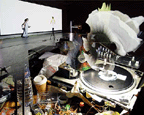
re-turning performance system
turned is an interactive and multi-medial dance performance. Jointly developed and performed by the media artist working at the ZKM in Karlsruhe, Chris Ziegler, and Kazue Ikeda, a Japanese dancer currently working in Berlin. The performance combines elements from dance, painting, visual art and music. The recorded images of the dancing body are sampled and distorted by electronic processing. The motion deconstructed in this manner opens up a poetic vision of losses and destruction. The beholder is taken along on a quest for clues. The piece turned is a turntable: it begins as a concert, continues as a dance, then goes over into an interactive video sequence and finally flows into a 3D-installation. A multi-medial space body develops right before the eyes of the audience.
Synopsis: a) sound/kinetic objects--the concert starts with turntable sound loops. various materials (but no vinyl !) are used on the turntable to start a complex interaction of sound, visuals and movement; b) dance--the dance starts with video and sound fragments based the dancers body in motion. The dancer takes over control of video and sound; c) transformation--the dance is connected to video, video to virtual 3d shapes, and sound is influenced by movement. Fragments of a) and b) will return in c) - another turn.
Between 1993 and 1999 Ziegler developed tools for rehearsal. He was involved in the production of the digital dance school "bill forsythe: improvisation technologies" (ballett frankfurt), which was a cd-rom, published in 1999 by the cantz verlag and the zkm (center for art and media) karlsruhe. After this project Ziegler worked on the relation of sound, visuals and dance on stage in "scanned I-V" (1999-2001). The live dance was scanned and transformed into "traces." This creates a temporal and spatial picture of reference to dance for the viewer about that which has already occured within the performance. "returntable" will permanently develop moving images and sounds in conjunction with the live dance: a "virtual pas-de-trois" of the moving body, visuals and interacitve sounds. the close releationship of all elements on stage will create "returntable": a re-turning movement performance system.
Posted by jo at 08:47 AM | Comments (0)
November 29, 2004
LiveForm:Telekinetics

Intertwined Networks
The Waag Society for Old and New Media has in 2004 commissioned Canadian artists Jeff Mann and Michelle Teran to produce and present the second iteration of the LiveForm:Telekinetics Project. LF:TK involves the creation of a series of site-specific installation/performance works connecting hybrid physical/virtual spaces using streaming media and networked kinetic objects. The commission is part of the Connected! project of Waag Society, a two-year programme of performances, lectures, workshops, installations, and emergent events exploring collaborative networked media and live art.
The LiveForm:Telekinetics project is envisioned as a laboratory that examines the intertwining of social networks and social spaces with their technological counterparts. As a work of art, it challenges and expands the notion of performance, the relationship of the artist and audience, production and exhibition, and ideas of locale and presence. The project creates hybrid installation/performative works, augmented with electronic devices and network systems, to create shared spaces and live social situations. Two-way streaming media such as video, sound, and graphics, are used to connect together physical sites via the Internet. Everyday physical objects within the environments become kinetic communications interfaces, animated with embedded sensors and actuators. In LiveForm:Telekinetics, mediating technologies are human-scale, built into architecture, furniture, decorations, utensils, toys, and the bric-a-brac that we surround ourselves with. Read more.
Posted by jo at 10:22 AM | Comments (1)
November 19, 2004
not yet it's difficult
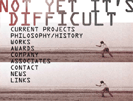
BLOWBACK
not yet it's difficult has a unique presence in Australia's contemporary performing arts culture as a research unit, a producer of industry development programs and a contemporary events maker.
Established in 1995, not yet it's difficult is an ideas-based group of artists who collaborate on the production of public performance events and cross-media projects under the artistic direction of david pledger. not yet it's difficult has produced original theatrical works through its Performance Series, public space projects, play productions, video-installation, new media, television, and, in association with other performance companies, workshop, forum, research and development programs. not yet it's difficult's philosophy is to make work cumulatively and collaboratively. Development practice links research and performance to presentation and analysis. not yet it's difficult's mission is to make critically engaged artworks of high artistic and discursive quality.
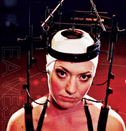
Current projects include: Eavesdrop, 2004, interactive cinema. David Pledger, Artistic Director of not yet it’s difficult and Jeffrey Shaw, world-renowned pioneer of interactive cinema, push the cinematic and the theatrical imaginary in this extraordinary new work. Part game, part real-time film-making, part spectator sport, part magical realism, Eavesdrop opens up the user and the viewer to new ways of looking at old forms, progressive pathways to interactivity and an alternative mode of visual discourse.
Blowback, 2004, theatre: BLOWBACK is an inter-disciplinary theatrical work crossing film, text and dance. Coined by America’s intelligence services, the term blowback describes the situation in which an agent of American foreign policy retracts their support. Using the body and video as double agents, BLOWBACK will be a kind of gestural, agit-prop, horror movie, part science fiction, part documentary, part absurdist metaphor. BLOWBACK will premiere at Memorial Hall, rear St Kilda Army & Navy Club, 88 Acland Street, St.Kilda, Melbourne on 27 November and 4 December 2004 (Previews November 25 and 26).
Posted by jo at 05:10 PM | Comments (0)
November 10, 2004
Sense of the Voice
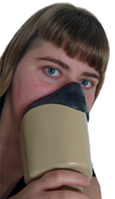
Lecture-Machine
With Lecture-Machine, Michelle Kasprzak takes on the persona of a lecturer. Previous to the performance, Kasprzak wrote a lecture and read it into her computer using a combination of a device called the Stenomask (to isolate the voice) and voice recognition software. The computer interpreted the text that was read to it, making many errors. During the performance this version was read aloud by the computer, while Kasprzak reads the same text into the mask. This re-reading creates a third version of the text, which appears in text format directly into Powerpoint slides. A sonic rhythm emerges between the muffled sound of the voice in the mask and the computer's voice, while audience members can also read a re-interpretation of the text being spoken as it is created on the spot.
From an essay by Lois Brown:
"...Lecture-Machine was very much alive, joyful, even. Lecture-Machine was wry in tone, rhythmic – the dynamic between speech and text and sound almost mesmerizing – certainly entrancing.
Lecture-Machine explores a public and private voice tension – Michelle's training of her device is quite private and her text and presentation public.
Meaning is quite private – she attends to where the machine misunderstands her. Using artefacts of lecture culture, she builds what she calls a "holy trinity" of voice/myself, the Stenomask, and Via Voice software: an impenetrable holy trinity. I heard the computer–voice, the text, and the natural voice all overlapping to create a lulling rhythm – the dynamic in the meanings, mistakes and misinterpretations creating playful "hermeneutic clashes" between the words and contexts." (Posted by Michelle Kasprzak)
Posted by at 11:39 AM | Comments (0)
November 06, 2004
HARVESTWORKS DIGITAL MEDIA ARTS CENTER PRESENTS
![]()
Diane Ludin + Angie Eng
Harvestworks is pleased to present works by Artist In Residence Diane Ludin and Angie Eng. In MEMORYFLESH 2.0, Diane Ludin has assembled media collages that summarize a variety of stories about the human genome's emergence as a voice of scientific authority and DNA as a rising world power. A fake suturing process is the performative gesture that drives the mixing of Internet media. MENOBILE, by Angie Eng (with sound by David Weinstein), is a new media interactive performance that explores the transition of ones perception from a static life to a nomadic one. Interactive video and sound via Jitter/MAX/SP is used to recreate the poetics of mobility in this multi-projection project.
MONDAY, NOVEMBER 8, 7:00pm; 596 Broadway, Suite 602, New York City, 10012/corner of Broadway & Houston; subway: Broadway/Lafayette (F/V), Bleecker (6), Prince St. (N/R); 212-431-1130 (p), 212-431-7693(f); Suggested Donation $5.00.
Diane Ludin is an artist and writer using the Internet as a material resource since 1996. She recycles existing Internet news media to collage a series of automated records of contemporary communication. Her montages focus on framing the Virtual Body as an almost reality and the core of "embodiment." She has exhibited both her solo and collaborative works in the US and abroad. Commissioned works include Internet projects for The Walker Art Center, Franklin Furnace, Turbulence.org and The Alternative Museum. Collaborative performances and broadcasts with The Electronic Disturbance Theater, FAKESHOP, Las Fantasmas, Prema Murthy, Francesca DiRimini, Ricardo Dominguez, and Agnese Trocchi.
Angie Eng moved to New York City in 1993 to pursue her career in the arts. She co-founded The Poool a live video performance group with Nancy Meli Walker and Benton Bainbridge in 1996-1999. Her work has been performed and exhibited at the Whitney Museum at Philip Morris, The Kitchen, New Museum of Contemporary Art, Renssalaer Polytechnic Institute, Roulette and Experimental Intermedia. This year she has been awarded a Lower Manhattan Cultural Council MCAF grant, a Harvestworks residency and NYSCA funds (New York State Council on the Arts) to develop Memobile that will premiere in the fall 2005.
David Weinstein is composer and multimedia artist whose musical and site-specific installation works have been shown worldwide. His musical works juxtapose sound effects, traditional and non-traditional instruments, synthetic sound, ancient and exotic tunings and noise. As a keyboardist Weinstein has recorded and performed in collaboration with musicians including Shelley Hirsch, Elliott Sharp, John Zorn, Ned Rothenberg, Rhys Chatham and many others. Weinstein's theatrical, installation and multimedia pieces have received a number of grants and awards. He articipated in a long collaboration with the live video performance group, The Poool, and works with the artist Doris Vila on her animated, multi-user, multi-screen, responsive environment installations (cited at Prix Ars Electronica 2002).
Posted by jo at 09:36 AM | Comments (0)
October 27, 2004
ArtFutura
![]()
Augmented Reality
ArtFutura's theme this year is Augmented Reality. It's taking place now in Barcelona [October 28th-31st]. The programme includes Howard "Smartmobs" Rheingold, Blast Theory who will perform Can You See Me Now?, the SimpleTEXT performance, Dublin’s MediaLab Europe and Montreal’s SAT will be showcasing installations and developing experimental projects, Richard Marks, creator of EYETOY, Greyworld, Fiona Raby, etc. (via)

Saturday October 30, 2004 - 4PM - 8PM, Live from Barcelona, SAT presents Phéromones, the Art Futura's closing show. Phéromones is a network multichannel audiovisual techno performance regrouping musicians Alain Thibault, Physical Noise Theatre & Champion and VJ jocool , Ladyroll & Le couple in Barcelona as well as Yan Breuleux, Nuclear Ramjet & Johnny Ranger in Montreal.
Pheromones will connect by means of an optical fiber network of Internet 2 (providing data flows of up to 2 Gigabytes per second) the Mercat de les Flors at Barcelona and the head office of the SAT at Montreal in order to share music and images generated on both sides of the world, by means of an experimental technical support: eight audio channels and immersive multi-screens. R&D for clubbing culture.
From October 26 to 30, 2004
A team of 17 artists, researchers and technicians, as members of the Territoires ouverts - TOT - Open Territories consortium initiated by the SAT, are invited by the Art Futura festival to present their work in Barcelona.
Several of the tools developed at SAT, like the nSLAM multichannel audio application and pixelTANGO digital video mixer, will be put at contribution in order to show the know-how and the expertise of the developpers in the fields of IP streaming video and mulitichannel audio, IP telepresence (point-to-point and multi-point) and transmission of immersive audio-visual environments over IP networks.
The Open Territories project aims to foster the emergence of innovative forms of cultural expression by engaging the creativity of a new generation of artists and creators, in whose hands will be placed a host of advanced interface and networking technologies. The TOT project will be able to open the broadband network environment to talented creators who are ideally placed to illustrate broadband's potential as a means of avant-garde cultural expression.
Thursday October 28, 2004 - 10AM - 5PM
Friday October 29, 2004 - 10AM - 5PM
Saturday October 30, 2004 - 10AM - 4PM
SAT invites you and your friends to "cross the Atlantic" and project yourself at the beautiful Mercat de les Flors in Barcelona, site of the Art Futura Festival.
During the three days of the festival, using two Telepresence stations, people at both side of the Atlantic will be able to meet and speak as if they were sitting on the same table, with high audio and video resolution.
To participate and meet the catalan artistic community, Art Futura's visitors and the SAT team in Barcelone, come at the SAT Café each day between 10AM and 5PM (4PM Saturday).
Free entrance
Posted by jo at 02:00 PM | Comments (0)
October 14, 2004
iCinema

Immersive and Interactive Narrative
The iCinema Centre for Interactive Cinema Research, established in 2001, is a joint venture of the College of Fine Arts and the School of Computer Science and Engineering at the University of New South Wales, Sydney. It brings together researchers and postgraduate students in new media, digital cinema, digital aesthetics, film theory, multimedia design, computer science, artificial intelligence and software/hardware engineering.
The iCinema research program focuses on the research and development of a digitally expanded cinema. This includes all forms of the moving image, made visible on any type of screen or in any sort of immersive environment, whose structure is constituted by various methods of narrative coherence. The project is directed by Jeffrey Shaw and Dennis Del Favero.
The Centre has four principal research domains:
Immersive Visualization Systems: The exploration of immersive environments which provide for the collection, integration and display of visual, audio and kinesthetic data.
Distributed Interface Systems: The integration of interface systems with the experience of distributed spatial visualization environments.
Interactive Narrative Systems: The exploration of interactive narrative systems which provide the viewer with the ability to select and edit interaction with a set of visual narrative streams.
Theories of Interactive Digital Narrative Systems: The inquiry into theories of narrative and the organization of units of meaning and experience within the digital domain.
Posted by jo at 12:55 PM | Comments (0)
October 01, 2004
Immaterial

Responding to and Tracing Past Movements
With "Immaterial", Michelle Kasprzak explores the frontiers of 3D visualization, video and live performance. Kasprzak integrates digital video loops with 3D objects being animated and textured in real time. The objects appear to be responding to the movements of the video character (Kasprzak), but it is not immediately apparent which is initiating the interaction: the character, the objects, or both. Notions of actual time and retransmissions are then questioned, and the artist herself has to confront this inversion of time by re-enacting the exact initial movements in order to maintain the integrity of the image.
Upon closer inspection, the audience slowly realizes that their initial assumption, which is that a live video is responding to pre-rendered digitised elements, is false. The performer is in the physical performance space, live, but her representation on the screen is not live. The video character is a loop, an echo of the real person at the computer. The essence of the performance is the harmonization of real time 3D graphics and a video representation of the artist.
With the palette of 3D objects transforming in real time, Kasprzak attempts to respond to and trace her past movements. "Immaterial" is Kasprzak's conversation with her video persona in 3 dimensions. View Quicktime movie.
For more Kasprzak performances, look here.
Posted by jo at 08:45 AM | Comments (0)
September 24, 2004
unsorted, SonicActsX

Live Cinema
This year Sonic Acts presents a special Live Cinema programme, in association with www.live-cinema.org.
"Live Cinema is a form of performance art in which a human performer manipulates sound and image in synergy through movement, for an audience. In the rapidly advancing field of Live Cinema there are a number of distinct movements, e.g. abstract synthetic cinema, graphic cinema and camera-based cinema. We will present a number of renowned performers from these areas in the small hall in Paradiso in a three-evening packed programme. The performances will be interspersed with interviews with the artists, and with a film and video programme specially compiled for Live Cinema organised in association with Martijn van Boven. A Sonic Acts Live Cinema special will be broadcast on television during VPRO’s Nachtpodium on Wednesday 22 September."
From the introduction to unsorted, SonicActsX: "An important traditional paradigm is the familiar distinction between art disciplines such as visual arts, music, dance, theatre and literature. Usually, the different works of information art are forced to fit within this classical categorisation model. This, however, provides us with a misleading image of the nature of the new arts. For instance, imagine two works of computer art, generated using largely similar algorithms. The first work has an aural output, the second results in visual forms. Then the first one will be labelled as music while the second will be called visual art. This might seem to be an arbitrary problem, but it becomes relevant when we realise that the infrastructures of, in this case, the musical world and the visual arts world operate in rather separated areas (art education, exhibition and performance spaces, criticism and analysis). Many of the interesting issues of (and between) artworks like these are being missed because they are positioned outside the current categorisation models." Read more.
"So what exactly is Live Cinema? Live Cinema springs from new presentation forms, arising as a direct consequence of the advancing digitalisation of visual and sound technologies. The synthesis between sound and image is something a few artists already are putting to practice. While other artists hold ambitions in that direction, a platform/lab gathering know-how and the creative potential digital technologies are inscribed with, is still lacking. The technological backdrop of Live Cinema is one of daily technological innovation in the audio-visual field. The process of digitalisation is most developed in the realm of electronic (pop)culture, where equipment is compact, user-friendly and affordable. All these factors have led to a new artistic practice, where the usage of hardware, such as samplers and computers, have led to new artistic genres and ways to approach art.
It is for these new art forms that I seek fitting formats of presentation, whether theatrical, cinematic, interactive, or on DVD. Live Cinema is all about the "live" event, where artists collaborate and work towards a performance where different artistic disciplines are more than the sum of their parts. Fixed components are music (not soundtrack) and image projection (not traditional film). The eventual result is a unique art experience for the spectator. Each time, just as in theatre or at a concert, it is different." Hans Beekmans
Posted by jo at 03:25 PM | Comments (0)
September 21, 2004
Villette Numérique

The Specific Nature of Mutant Forms?
The second edition of Villette Numérique brings together actors from international digital culture and invites you, over the course of two weeks, to discover how artists, emerging in ever-greater numbers from different backgrounds, are reshaping contemporary creation. Structured around two exhibitions and numerous events at the crossroads of performance arts, cinema, video-gaming, music and architecture, the festival outlines the specific nature of a mutant and as yet ill-defined emerging art form.
Posted by jo at 02:18 PM | Comments (0)
September 12, 2004
mobile performance group
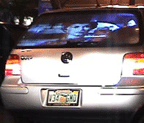
(auto)mobile performances
04.15.04 Downtown Orlando FL: Using the automobile as a mobile performance apparatus MPG presented a live performance which included real-time video and audio processing techniques. This project used two cars, one with audio performers the other with video performers. Using wireless networking and a FM transmitter the two cars where able to keep in sync and perform together as they moved through the city. Performers where Laura Oxendine, Adam Roberts, Martha Garzon, Damion Waters, Bryan O'neal, Ben Hustis, Julius Santiago, James Auten, Chester Udell, Jamie Tauler. Project Leaders where Nathan Wolek, Matt Roberts.
MPG:Mobile Performance Group is a collective of new media artists interested in finding new ways to present art outside of traditional venues. The Group was founded by Matt Roberts and is based in Florida. Using custom video and audio software instruments in real-time, and original video and audio recordings, Roberts and Wolek will present a meditation on the Florida Landscape which will be realized as an improvised new media performance at the New Forms Festival, Vancouver, Canada on October 24, 2004.
Posted by jo at 04:46 PM | Comments (0)
September 09, 2004
tanz performance köln

European Complements
tanz performance köln founded in 1989, develops concepts and realizes dance-related series, festivals and dance film programs, that are representative of new developments in contemporary dance both nationally and internationally including projects with a strong focus on new media technologies. Their projects include DAMPF_lab, an interdisciplinary collaborative project fostering new and distinctive art works of high quality that integrate interactive media technologies with the performing arts while seeking insight into questions such as: how do emerging software practices impact performance; what is the experience of the performer on an interactive stage; how are the relations between maker, performer and audience still shifting; and what are the aesthetic/social consequences?
tanz performance köln partners include:
Animax Multimedia Theater (est. 1999) of the Bonn Development Workshop for Computer Media (est. 1985) focuses on the roduction/presentation of media arts and provides an outstanding operational basis for the exploration of new interactive technologies in the area of performance arts and immersive arts.
Ars Electronica Center/Futurelab offers one of the best-equipped and most efficient research and development workshops for Interactive Spaces, Virtual Environment and Digital Surfaces in the context of Ars Electronica which has been an internationally unique showcase for digital art and media culture and encounters between the arts and sciences since 1979.
V2_Lab is the aRt&D department of V2_, Institute for the Unstable media (est. 1987) that concerns itself with research and development in the field of art and media technology and brings to the project a variety of knowledge/ expertise derived from an interdisciplinary approach to the field of unstable media including specific critical perspectives.
Partners work on the following complementary strands:
research labs aiming to generate shareable outcomes by drawing questions from and in turn supporting the creative work of the co-productions; stimulating other new artistic work; innovating technology solutions together; and devising unique dramaturgical and user testing approaches to the artistic process. In addition, the labs will gather documentation to contribute to theoretical and educational approaches to this area of work.
co-productions aiming to nurture and help realise two specific art works: composer/director Klaus Obermaier working with the Ars Electronica Futurelab to develop interactive media technologies for use in a new performance for the stage; and choreographer Angelika Oei working with the V2_Lab on the creation of a large scale performance/ interactive media installation work.
Associate researchers:
Matt Adams (Brighton/ London)
Daniel Aschwanden (Vienna)
Johannes Birringer (Nottingham)
Carol Brown (London), Nuria Font (Barcelona)
Nik Haffner (Frankfurt/ Barcelona)
Prue Lang (Frankfurt), Cindy Lee (London)
Martin Kusch (Vienna/ Montreal)
Christopher Salter (Berlin)
Stephanie Thiersch (Cologne)
Ariella Vidach (Milan)
Posted by jo at 01:09 PM | Comments (1)
September 07, 2004
UNSTABLELANDSCAPE

Dance and Mutable Media
"I envision the development of UNSTABLELANSCAPE beyond the local performance and gross movements of the dancers towards the use of autonomous streams of data, subtle measurement of biological functions (breathing, heart beat, earth movement, GP systems and distributed performance using the internet)...I would like to explore the augmentation of the system hybridicity and maximizing its bottom-up architecture with the integration of organic tissue such as neurons and muscle cells to the real time aspect of the video-sound-movement continuum (residency at Simbiotica, Australia). Later, I will expand the performance with this bio-digital generativity and with analog/biologically inspired robots. It is a continuation of the aesthetics of emergence."
marlon barrios solano
Posted by jo at 10:06 AM | Comments (1)
August 24, 2004
Media Psychosis
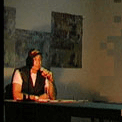
Live Rant
Rant/Rant Back/Back Rant, by G.H. Hovagimyan and Peter Sinclair, samples and re-mixes news report catch-phrases cycling through the global information environment. The work looks at the use of targeted language within the framework of mass media, and posits a media overload psychosis embodied by the live performance word jam created by Sinclair and Hovagimyan. Two live performances will be performed at Groningen Museum and STEIM, Netherlands and streamed live on August 23rd and August 26th.
Peter Sinclair and G.H. Hovagimyan have been artistic collaborators over a number of digital performance and installation works. Mr. Sinclair who is a well-known sound artist lives in Marseille, France while Mr. Hovagimyan who is a multi-media artist lives in New York City.
Sinclair’s works have recently been highlighted in the French contemporary art magazine artpress. (Art Press special edition, number 24, 2003. Le Burlesque. Une Aventure Moderne.) One work, A SoaPOPera for iMacs done in collaboration with Hovagimyan will be included in a historic exhibition called Le Burlesque that will be on view in Paris at the National Galeries Jeu du Paume Museum in 2005. Documentation and video of this work can be seen at: http://nujus.net/gh_04/gallery3.html
Part of the inspiration for the work Rant/ Rant Back/ Back Rant developed out of xenophobic rants that Sinclair encouraged Hovagimyan to do for their 2001 Interactive sound and laser installation work titled Shooter. You may view documentation and video here: http://nujus.net/shooter-new-site/index.html
Their latest work Rant/Rant Back/ Back Rant will be performed in the Netherlands at the Groningen Museum, August 23rd and August 26th at STEIM, Amsterdam.
While investigating synthetic voice programming in 1996 Hovagimyan met Peter Sinclair. The two began to collaborate on a series of works that used text and synthetic voice as an element for robotic performance and installation work. Sinclair brings to the collaboration a fascination with the mechanic possibilities inherent in programming and digital art as well as his expertise in the realm of sound art and performance works. Indeed, before meeting Hovagimyan, Sinclair was quite accomplished as a performance artist in France. A survey of his works can be seen at: http://www.nujus.net/peterhomepage/html/
Hovagimyan brings to the piece a long history of using text within his work both individually and in collaboration with Sinclair. In 1994 Hovagimyan did a billboard campaign for Creative Time in New York City. The billboard , Hey Bozo… Use Mass Transit, used a block of text somewhat in the manner of rap lyrics. Documentation as well as an NBC news report can be seen
at: http://nujus.net/gh_04/gallery2.html
In 2000-2001 Hovagimyan created a series of rant performances for the palm pilot called Palm Rants. Documentation can be viewed at: http://nujus.net/gh/html/rants.html. An example can be seen at http://nujus.net/gh_04/video/entertainMenow.mov
As far back as 1974 Hovagimyan has been using agit-prop as part of his work. Indeed a 1974 work Tactics for Survival in the New Culture was shown in a 1978 group show called Manifesto organized by Collaborative Projects in New York City. Subsequently, in 1994, Hovagimyan updated the piece, turning it into a hypertext work and one of the earliest examples of what is now known as Net Art. The work can be viewed online at: http://www.thing.net/~gh/artdirect/tactics.html
Their collaborative works as well as their homepages can be accessed via the web at: http://nujus.net (note the site uses pop-up windows and javascript. Enable scripting and pop-up windows to view the site)
Posted by jo at 11:28 AM | Comments (1)
August 19, 2004
trans/forms
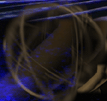
Mixed Improv
trans/forms is an ongoing multimedia collaborative project exploring the fusion of live performance with digital technology and on-line communication from an improvisational perspective. Its first performance event, including live movement and sound as well as digital video and netcasting, was presented as part of International Dance and Technology 99 (Arizona) in 26 February 1999. The material for this performance was produced in three different places of the world: Tempe, Arizona, USA (movement, sound and video contributions), London,UK (sound) and Turku, Finland (video). It was mixed live on the web. Read a paper by Sophia Lycouris. Other works by kunstwerk-blend
Posted by jo at 11:16 AM
New Work Network
New Work Network is a sector-wide, artist-led organisation that brings together artists, producers, venues, academics and other practitioners involved in the new work sector in the UK. The organisation builds on the existing cross-over between a wide variety of practices in the fields of performance, live art, new theatre, new dance, installation, video art, digital art, time-based and interdisciplinary arts including those that embrace new technologies.
Their project "Networked Bodies"is a radical and democratic awards scheme for the creation of new work in the live medium. It hands decision-making back to you - the artists, producers, critics and academics via a unique, online submission, review, discussion and voting process.
In 2004 Networked Bodies will offer 3 awards of £5000 for the production of new work to professional artists working in Live Art, live/interdisciplinary practice and contemporary performance and it offers New Work Network's membership the opportunity to discuss and decide who should get awards. Winning projects must be produced and shown at least once in England by the end of the financial year in which the round takes place.
Posted by jo at 10:36 AM
August 12, 2004
SimpleTEXT
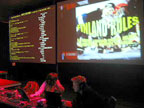
zeitgeist performing
SimpleTEXT is a collaborative audio/visual public performance that relies on audience participation through input from mobile devices such as phones, PDAs or laptops' (from simpletext website). This installation, created by mixing and matching older software projects by Jonah Brucker-Cohen, Tim Redfern and Duncan Murphy, accepts real-time SMSs and text messaging in order to create live music and visuals. The software first parses the text, which dictates the music, then uses these messages to rhythmically drive speech and picture synthesizers (direct from the web using google's image search). Although I've never seen it, my guess is that the most interesting part of this performance would be seeing a dialogue emerge between the piece, the performers, the audience SMSing in the space, and the audience texting from the web. A zeitgesit of ASCII that reiterates.... iterate.... iterative.... (ad nauseum) (Posted by Nathaniel Stern)
Posted by at 02:57 AM | Comments (0)
August 05, 2004
ambienteTV.net
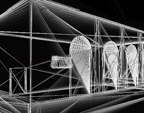
Telematic Traces
ambientTVnet is a crucible for independent, interdisciplinary practice ranging from installation and performance, through documentary, dance, and gastronomy, to sound and video composition and real-time manipulation. We continue to develop social and technical infrastructure and promote network architectures that facilitate alternatives to current socio-political and economic formations. Techniques and effects of live data broadcasting and transmission provide theme, medium, and performative space for many of the works.
Networked Performance: The performance incorporates geographically distant real spaces into the theatre space. The narrative grows out of telematic feedback, and the interplay between real spaces and imaginary realms. Daily life’s occupation--Streetwalking, food preparation or conversing – are presented as a narrative act. Rehearsal, orchestration, choreography, improvisation, the unpredictable response of the audience and traces of city walks are brought together by the crossing of data streams that technology allows. Stories and characters are built through fragmentary vignettes and scetches, and the streaming might be seen to figure how we weave stories and sense from our daily move-abouts and their chaos of traces; traces from which we project a transcendent geography of the self. The theme and structure of the pieces are woven together by crisscrossing of telematic links between a performer in a venue, and a roaming performer in the neighbourhood.
AV DINNERS: EPIC EROS live and online audio-visual gastronomic event. The first in a series of sensory networked cook-ins featuring collaborations between digital and performance artists and chefs.
TELEJAM: TRYPTICHON audio-visual jam session between a venue and its neighbourhood. Roaming performers equipped with location-aware devices write their movements on the urban canvas (London Nov. 2003). Read a review of their April 4, 2004 performance.
MYRIORAMA telematic theatre/dance performance featuring NYC motion poet Ajay Naidu (2004)
Posted by jo at 08:26 PM
n0media

Decentred Improv
decentred | distributed improvisation, an experimental performance space programmed by Tom Simmons & Liam Wells of n0media, took place between 15th March & 17th April 2004. Decentred connected Norwich Gallery with a variety of remote locations & creative partners. A community of visual, sonic, media and performance artists worked within a specially created network in a series of online collaborations, webcast live from this URL.
Posted by jo at 07:03 PM | Comments (0)
August 02, 2004
Mesh Performance Practices
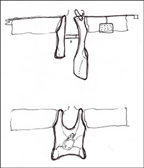
Exiles, Ghosts and Astronauts Physical interventions in the critique of virtual culture
Aura: Film Studies Journal, Volume IV, Issue 1, 1998, Susan Kozel
Exiles, Ghosts and Astronauts was a performance experiment occurring simultaneously between Riverside Studios and The Place Theatre in London (England). The videoconference link was made by Macintosh computers and basic internet videoconferencing software (CU-SeeMe). Performers in each location were projected into the other for a physical exploration of intimacy, weightlessness and altered materiality. It was part of Digital Dancing 1997, the London Dance Umbrella platform for dance and technology collaboration.
As physical exploration is undertaken, with telepresence and other forms of digital intervention in performance, the physical and philosophical vocabularies that emerge are mutually shaped and critical of one another. This article charts a course through philosophical debate and performance practice. Many voices and perspectives unfold across three sections: dialogue with Paul Virilio, devising process, and performance.
Continue reading at Mesh Performance Practices
whisper is a real-time interactive media installation based on small wearable devices, wireless computer communication, and handheld technologies embedded in evocative and playful garments worn by the participants. whisper intervenes aesthetically and critically in the evolution of our human environment by transforming the physical practices and technological interfaces that mediate our physical and emotional interchange. whisper is about creating new physical, technological, kinesthetic & affective vocabularies. whisper is a collaborative project involving artists (dance, sculpture, music), designers (of visuals, objects & textiles), computer scientists, and hardware/software engineers.
Posted by jo at 03:14 PM | Comments (0)
August 01, 2004
Distributed Opera
The BRAIN OPERA
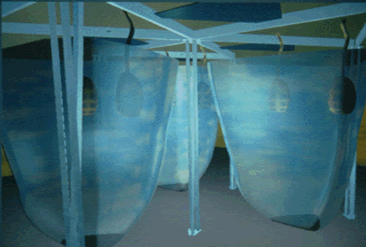
Premiered in 1996, this interactive, musical journey was presented simultaneously in physical and cyber space. A viewer could perform live in the Brain Opera performances via " T h e P a l e t t e," musical instrument. This advanced, multi-user Java applet, was only active during Brain Opera performances. You could also see and hear live video and audio broadcasts of the Brain Opera performances.
The culmination of the Brain Opera experience was the 45-minute Final Performance--a 3-movement composition tied together the project's many musical, visual, and textual strands into a unified tapestry. Three performers shape, select, and interpret precomposed and audience-created elements, using specially-designed hyperinstruments: the Sensor Chair (which translates wireless body movement into sound); the Gesture Wall (a modification of the same instrument from the Mind Forest); and the Digital Baton (which combines pointing, squeezing/selecting, and motion sensing). A large curved screen and multiple projectors allows a constant flow of images to be presented in coordination with the music, illustrating Minsky's words, providing counterpoint to the music, or illuminating the actions of the performers. The audience is also invited to dance on a Sensor Carpet during the Finale, adding sound to the richness and intensity at the end of the work.
Posted by michelle at 04:51 AM
July 31, 2004
Historically Locating Distributed Performance
2004.04.05 Helen Thorington, writing about an early conference proposal:
The following are examples of distributed performances:
Finding Time (Jesse Gilbert, 2000). Finding Time linked performers on six continents in a series of live musical events, each an hour’s duration.
World Wide Simultaneous Dance (1998, Laura Knott). The project took place simultaneously in twelve countries.
In both examples the performers played to audiences in their performance spaces and to a worldwide Internet audience by means of especially created websites.
I then move on to a brief history, beginning with Kaprow's "Hello Hello" in the mid-60s--about which I can find very little information other than that it linked five sites in a television event. And on to Kit Galloway and Sherri Rabinowitz.
But the history is the not the question for me. Internet works resonate with historical issues. But what I'm beginning to think as I research for the conference is that we may already have witnessed the passing of the (pre)structured presentation of large-scale performance works--I keep thinking, for instance, that while Adrift (1997-2001) was very different from other works produced at its time, it was also very traditional. It was a work by three artists (the senders), in which its audiences had no agency at all--Like radio, like television, they were cast in the role of "receivers."

From the Adrift performance
Now...when did it happen?...the Internet environment is in a far more participatory stage and people-interest runs to works/platforms/
environments in which the former viewer can play an active role. Which may begin to explain why there are really not very many interesting large performance works being produced at this time. Not only is the technology still difficult but the environment is no longer congenial.
Or am I wrong? And if not, what does this do for/to our conference?
I'm going to think about this for awhile. Right now my only thought is that if this is so, the conference itself should reflect it and include the many twists and turns performance has taken in the last years.
Posted by michelle at 01:22 PM | Comments (0)
July 30, 2004
What connects the future and the past?
The following comment from Benton Bainbridge frames a question that we, the organizers have been asking since we first thought of this blog. What connects the future and past of networked performance. How has networked performance evolved? What directions has it taken? A real understanding will come from individual replies to the questions Benton has posed. We hope you will make an effort to answer them.
From Benton: "my personal interest would be connecting the dots between the future and the past of networked/collaborative performance. can we advance today's efforts in distance collaboration through global and local digital networks by studying similar ambitions in earlier networked media?
my background is live audiovisual performance. the history of this discipline still hasn't been written, so as a country boy i drew inspiration and guidance from other collaborative arts: live music, underground comix 'jams' and performance art. Laurie Anderson, "Good Morning Mr. Orwell" and Youngblood's "Expanded Cinema" were key triggers too.
i'm curious how networked performance artists on this blog developed their art. how did you get into networked performance; what was your inspiration and how did you map the territory - firsthand R&D or study of past masters?
~benton-c"
Posted by newradio at 07:03 PM | Comments (0)
July 29, 2004
Networked Local Performance
Dialtones: A Telesymphony
Dialtones, as described on Golan Levin’s web site, "is a large-scale concert performance whose sounds are wholly produced through the carefully choreographed dialing and ringing of the audience's mobile phones. Because the exact location and tone of each participant's mobile phone can be known in advance, Dialtones affords a diverse range of unprecedented sonic phenomena and musically interesting structures."
Preparatory to the concert, members of the audience register their wireless telephone numbers at secure Web kiosks located in the performance space. In exchange for this information, they then receive seating assignment tickets for the concert venue. New "ringtones" are then automatically downloaded to their handsets. During the concert, a small group of musicians perform the phones en masse by dialing them up with a specially designed, visual-musical software instrument. "Because the audience's positions and sounds are known to the Dialtones computer system, the performers can create spatially-distributed melodies and chords, as well as novel textural phenomena like waves of polyphony which cascade across the crowd; these musical structures, moreover, are visualized by a large projection system connected to the performers' interfaces. Towards the end of its half-hour composition, Dialtones builds to a remarkable crescendo in which nearly two hundred mobile phones peal simultaneously."
Posted by newradio at 06:26 PM
July 28, 2004
Networked Local Performance
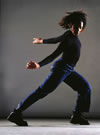
Texterritory v.2.3
Texterritory is a playground performance concept in which the audience has control over physical bodies (dancers and musicians) along with lighting, music and midi system at specific times during the performance. Their influence alters the direction of each performance. Texterritory was performed in May 2003 at the Mumford theatre in Cambridge (UK). Its plot is described as follows:
"Grace, a Legal Secretary arrives home early to prepare herself for her first real date with Jerome. She’s just bought a new pair of shoes to go with one of those outfits. At the moment she drops her keys on the kitchen table, the text arrives from J — he has been delayed but will be there soon. From optimism to despair from knowing to kneeling in prayer, Grace's dilemmas and insecurities unfold as she figures out what to do with this unexpected time on her hands. Together with the influence of the audience she decides exactly what to wear, who she might call if he doesn't show up as well as trying to reassemble a photofit image of what Jerome really looks like."
The multi-media, non-linear narrative "is told through texting/photo-messaging, dance, music, spoken word and animation."
Texterritory makes use of a mobile gateway created by new media company Digit. Computers that tally the results of text messages sent to the audience and derives instructions for the performers from them. It thus gives the audience a certain amount of interactive control over the physical bodies, music and lighting at specific times during the performance.
Posted by newradio at 05:52 PM | Comments (0)
July 26, 2004
Intermedia Performance
Joanna Berzowska, XS Labs, will chair this SIGGRAPH session on Intermedia Performance in LA, 12 August. Projects range from dance-based, eye controlled imagery to cinema editing as live performance.
 Conceiving Embodiment: The Dance Architecture of Spawn
Conceiving Embodiment: The Dance Architecture of Spawn
Spawn is an interactive dance architecture developed by Carol Brown Dances, choreographer, and Mette Ramsgard Thomsen, architect, that aims to conceive an embodied space by investigating presence and being in environments that merge physical and virtual dimensions (mixed realities).
Application of the research is described in the production The Changing Room, choreographed for three performers and a virtual other, which takes place within the framework of an interactive architectural environment. Embedded within the furniture of the room are a series of screens through which a virtual presence is rendered, mirroring, extending and distorting their behaviour. The Changing Room explores the complexity of lives lived in the mediated conditions of the technological and at the edge of the real.
 NightDriving: Videodance in Performance
NightDriving: Videodance in Performance
NightDriving, developed by John Crawford, electricFX Media, and Lisa Naugle,University of California, Irvine, is a hybrid media work, combines live performance of contemporary dance with digital video animations derived from the movement of the dancers.
 Illusory Interactive Performance by Self-Eye Movement
Illusory Interactive Performance by Self-Eye Movement
Junji Watanabe and Susumu Tachi, University of Toky, use saccade-based display, so the audience can perceive different images from what physically exists on the stage. The display enables illusory interactive performance based on audiences eye movements. The project is developed with Tetsutoshi Tavata and Mariana A. Verdaasdonk, Queensland University of Technology, of cell/66b, and Hideyuki Ando and Taro Maeda, NTT Corporation.
 Live Cinema: An Instrument for Cinema Editing as a Live Performance
Live Cinema: An Instrument for Cinema Editing as a Live Performance
Michael Lew, Media Lab Europe, presents the Live Cinema research project, aimed at building an expressive tangible instrument for cinema editing and improvisation as a live performance.
Described as: Live improvisational video performance transforms the editor into a performer while it requires just-in-time selection and manipulation of video shots and sequences in anticipation of streaming the video images to a large display. This project prototypes an expressive tangible and gestural instrument for two hands allowing performer to play video by using two finger-pointing devices, one on each hand, and two "scratch" turntables for precision mark up of in/out points. The control screen, designed such that it can become a visual element in the performance, features video thumbnails which group themselves using behaviors defined and determined by the performer.
He writes about the instrument in this paper. Abstract: The Live Cinema instrument is a cross between a musical instrument and a film editing tool, tailored for improvisational control as well as performance presence. Design specifications for the instrument evolved based on several types of observations including: our own performances in which we used a prototype based on available tools; an analysis of performative aspects of contemporary DJ equipment; and an evaluation of organizational aspects of several generations of film editing tools. Our instrument presents the performer with a large canvas where projected images can be grabbed and moved around with both hands simultaneously; the performer also has access to two video drums featuring haptic display to manipulate the shots and cut between streams.
The paper ends with a discussion of issues related to the tensions between narrative structure and hands-on control, live and recorded arts and the scoring of improvised films.
Posted by michelle at 05:48 PM | Comments (0)


